
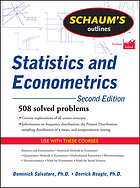 Schaum's Outline of Statistics and Econometrics, Second Edition
by
The ideal review for your statistics and econometrics course More than 40 million students have trusted Schaum's Outlines for their expert knowledge and helpful solved problems. Written by renowned experts in their respective fields, Schaum's Outlines cover everything from math to science, nursing to language. The main feature for all these books is the solved problems. Step-by-step, authors walk readers through coming up with solutions to exercises in their topic of choice. Clear, concise explanations of all statistics and econometrics concepts Appropriate for the following courses: Statistics and Econometrics, Statistical Methods in Economics, Quantitative Methods in Economics, Mathematical Economics, Micro-Economics, Macro-Economics, Math for Economists, Math for Social Sciences
Schaum's Outline of Statistics and Econometrics, Second Edition
by
The ideal review for your statistics and econometrics course More than 40 million students have trusted Schaum's Outlines for their expert knowledge and helpful solved problems. Written by renowned experts in their respective fields, Schaum's Outlines cover everything from math to science, nursing to language. The main feature for all these books is the solved problems. Step-by-step, authors walk readers through coming up with solutions to exercises in their topic of choice. Clear, concise explanations of all statistics and econometrics concepts Appropriate for the following courses: Statistics and Econometrics, Statistical Methods in Economics, Quantitative Methods in Economics, Mathematical Economics, Micro-Economics, Macro-Economics, Math for Economists, Math for Social Sciences
 Basic Statistics for Business and Economics
by
The Fifth Edition of Basic Statistics for Business and Economics is a shorter version of Lind/Marchal/Wathen's Statistical Techniques in Business and Economics, 12e. The authors of this text continue to provide a student-oriented approach to business statistics. In this book you will find step-by-step solved examples, realistic exercises, and up-to-date technology and illustrations. Book jacket.
Basic Statistics for Business and Economics
by
The Fifth Edition of Basic Statistics for Business and Economics is a shorter version of Lind/Marchal/Wathen's Statistical Techniques in Business and Economics, 12e. The authors of this text continue to provide a student-oriented approach to business statistics. In this book you will find step-by-step solved examples, realistic exercises, and up-to-date technology and illustrations. Book jacket.
 Basics of Qualitative Research : techniques and procedures for developing grounded theory
by
The Third Edition of the bestselling Basics of Qualitative Research:Techniques and Procedures for Developing Grounded Theory continues to offer immensely practical advice and technical expertise to aid researchers in making sense of their collected data. Authors Juliet Corbin and the late Anselm Strauss (co-creator of Grounded Theory) present methods that enable researchers to analyze and interpret their data, and ultimately build theory from it. Highly accessible in their approach, Corbin and Strauss provide a step-by-step guide to the research act--from the formation of the research question through several approaches to coding and analysis, to reporting on the research. Full of definitions and illustrative examples, this book concludes with chapters that present criteria for evaluating a study, as well as responses to common questions posed by students of qualitative research. Significantly revised, Basics of Qualitative Research remains a landmark volume in the study of qualitative methods. Key Features of the Third Edition: Allows for students to develop their critical thinking skills in the "Critical Issues" section at the end of each chapter. Shows the actual steps involved in data analysis (from description to grounded theory) and data gathering by means of theoretical sampling. Provides exercises for thinking, writing and group discussion that reinforces material presented in the text.
Basics of Qualitative Research : techniques and procedures for developing grounded theory
by
The Third Edition of the bestselling Basics of Qualitative Research:Techniques and Procedures for Developing Grounded Theory continues to offer immensely practical advice and technical expertise to aid researchers in making sense of their collected data. Authors Juliet Corbin and the late Anselm Strauss (co-creator of Grounded Theory) present methods that enable researchers to analyze and interpret their data, and ultimately build theory from it. Highly accessible in their approach, Corbin and Strauss provide a step-by-step guide to the research act--from the formation of the research question through several approaches to coding and analysis, to reporting on the research. Full of definitions and illustrative examples, this book concludes with chapters that present criteria for evaluating a study, as well as responses to common questions posed by students of qualitative research. Significantly revised, Basics of Qualitative Research remains a landmark volume in the study of qualitative methods. Key Features of the Third Edition: Allows for students to develop their critical thinking skills in the "Critical Issues" section at the end of each chapter. Shows the actual steps involved in data analysis (from description to grounded theory) and data gathering by means of theoretical sampling. Provides exercises for thinking, writing and group discussion that reinforces material presented in the text.
 Q Methodology
by
Q Methodology defines the distinctive set of psychometric and operational principles which, when combined with specialized statistical applications of correlational and factor-analysis techniques, provide researchers with a systematic and rigorously quantitative means for examining human subjectivity. Based on the premise that subjectivity is communicable and advanced from self-reference, the method′s central concern is to ensure that self-reference is preserved and not compromised or confused by external investigation. The authors outline the appropriate principles, techniques and procedures which advance this goal, including data gathering, statistics and small-sample behavioural research.
Q Methodology
by
Q Methodology defines the distinctive set of psychometric and operational principles which, when combined with specialized statistical applications of correlational and factor-analysis techniques, provide researchers with a systematic and rigorously quantitative means for examining human subjectivity. Based on the premise that subjectivity is communicable and advanced from self-reference, the method′s central concern is to ensure that self-reference is preserved and not compromised or confused by external investigation. The authors outline the appropriate principles, techniques and procedures which advance this goal, including data gathering, statistics and small-sample behavioural research.
 The Palgrave Encyclopedia of World Economic History since 1750
by
It is generally agreed that in order to understand the economy today, you need to understand its history. This easy-to-use encyclopedia provides a useful reference for students and academics alike, looking at key events, themes and people that have shaped the modern world and economic thinking.
The Palgrave Encyclopedia of World Economic History since 1750
by
It is generally agreed that in order to understand the economy today, you need to understand its history. This easy-to-use encyclopedia provides a useful reference for students and academics alike, looking at key events, themes and people that have shaped the modern world and economic thinking.
 Why Nations Fail: the origins of power, prosperity, and poverty
by
Brilliant and engagingly written, Why Nations Fail answers the question that has stumped the experts for centuries: Why are some nations rich and others poor, divided by wealth and poverty, health and sickness, food and famine? Is it culture, the weather, geography? Perhaps ignorance of what the right policies are? Simply, no. None of these factors is either definitive or destiny. Otherwise, how to explain why Botswana has become one of the fastest growing countries in the world, while other African nations, such as Zimbabwe, the Congo, and Sierra Leone, are mired in poverty and violence? Daron Acemoglu and James Robinson conclusively show that it is man-made political and economic institutions that underlie economic success (or lack of it). Korea, to take just one of their fascinating examples, is a remarkably homogeneous nation, yet the people of North Korea are among the poorest on earth while their brothers and sisters in South Korea are among the richest. The south forged a society that created incentives, rewarded innovation, and allowed everyone to participate in economic opportunities. The economic success thus spurred was sustained because the government became accountable and responsive to citizens and the great mass of people. Sadly, the people of the north have endured decades of famine, political repression, and very different economic institutions--with no end in sight. The differences between the Koreas is due to the politics that created these completely different institutional trajectories. Based on fifteen years of original research Acemoglu and Robinson marshall extraordinary historical evidence from the Roman Empire, the Mayan city-states, medieval Venice, the Soviet Union, Latin America, England, Europe, the United States, and Africa to build a new theory of political economy with great relevance for the big questions of today, including: - China has built an authoritarian growth machine. Will it continue to grow at such high speed and overwhelm the West? - Are America's best days behind it? Are we moving from a virtuous circle in which efforts by elites to aggrandize power are resisted to a vicious one that enriches and empowers a small minority? - What is the most effective way to help move billions of people from the rut of poverty to prosperity? More philanthropy from the wealthy nations of the West? Or learning the hard-won lessons of Acemoglu and Robinson's breakthrough ideas on the interplay between inclusive political and economic institutions? Why Nations Fail will change the way you look at--and understand--the world.
Why Nations Fail: the origins of power, prosperity, and poverty
by
Brilliant and engagingly written, Why Nations Fail answers the question that has stumped the experts for centuries: Why are some nations rich and others poor, divided by wealth and poverty, health and sickness, food and famine? Is it culture, the weather, geography? Perhaps ignorance of what the right policies are? Simply, no. None of these factors is either definitive or destiny. Otherwise, how to explain why Botswana has become one of the fastest growing countries in the world, while other African nations, such as Zimbabwe, the Congo, and Sierra Leone, are mired in poverty and violence? Daron Acemoglu and James Robinson conclusively show that it is man-made political and economic institutions that underlie economic success (or lack of it). Korea, to take just one of their fascinating examples, is a remarkably homogeneous nation, yet the people of North Korea are among the poorest on earth while their brothers and sisters in South Korea are among the richest. The south forged a society that created incentives, rewarded innovation, and allowed everyone to participate in economic opportunities. The economic success thus spurred was sustained because the government became accountable and responsive to citizens and the great mass of people. Sadly, the people of the north have endured decades of famine, political repression, and very different economic institutions--with no end in sight. The differences between the Koreas is due to the politics that created these completely different institutional trajectories. Based on fifteen years of original research Acemoglu and Robinson marshall extraordinary historical evidence from the Roman Empire, the Mayan city-states, medieval Venice, the Soviet Union, Latin America, England, Europe, the United States, and Africa to build a new theory of political economy with great relevance for the big questions of today, including: - China has built an authoritarian growth machine. Will it continue to grow at such high speed and overwhelm the West? - Are America's best days behind it? Are we moving from a virtuous circle in which efforts by elites to aggrandize power are resisted to a vicious one that enriches and empowers a small minority? - What is the most effective way to help move billions of people from the rut of poverty to prosperity? More philanthropy from the wealthy nations of the West? Or learning the hard-won lessons of Acemoglu and Robinson's breakthrough ideas on the interplay between inclusive political and economic institutions? Why Nations Fail will change the way you look at--and understand--the world.
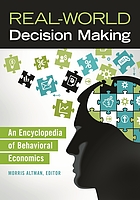 Real-World Decision Making : an encyclopedia of behavioral economics
by
The first and only encyclopedia to focus on the economic and financial behaviors of consumers, investors, and organizations, including an exploration of how people make good--and bad--economic decisions. Traditional economic theories speculate how and when people should spend money. But consumers don't always behave as expected and often adopt strategies that might appear unorthodox yet are, at times, more effective than the rule prescribed by conventional wisdom. This groundbreaking text examines the ways in which people make financial decisions, whether it is because they are smart but atypical in their choices ... or just irrational decision makers. A leading authority on behavioral economics, Morris Altman and more than 150 expert contributors delve into key concepts in behavioral economics, economic psychology, behavioral finance, neuroeconomics, experimental economics, and institutional economics to help inform economic models based on reality, not theory. Through 250 informative entries, the book explores various aspects of the subject including decision making, economic analysis, and public policy. In addition to introducing concepts to readers new to the subject, the book sheds light on more advanced financial topics in a manner that is objective, comprehensive, and accessible. Contains an informative introductory essay that familiarizes students with the various aspects of behavioral economics Provides a list of additional readings for those interested in learning more about the topic Includes cross-references in each entry to help readers make connections between related topics Defines key terms that are likely to be unfamiliar to those without advance knowledge of the subject Helps readers identify and study particular entry categories through accompanying Topic Finders
Real-World Decision Making : an encyclopedia of behavioral economics
by
The first and only encyclopedia to focus on the economic and financial behaviors of consumers, investors, and organizations, including an exploration of how people make good--and bad--economic decisions. Traditional economic theories speculate how and when people should spend money. But consumers don't always behave as expected and often adopt strategies that might appear unorthodox yet are, at times, more effective than the rule prescribed by conventional wisdom. This groundbreaking text examines the ways in which people make financial decisions, whether it is because they are smart but atypical in their choices ... or just irrational decision makers. A leading authority on behavioral economics, Morris Altman and more than 150 expert contributors delve into key concepts in behavioral economics, economic psychology, behavioral finance, neuroeconomics, experimental economics, and institutional economics to help inform economic models based on reality, not theory. Through 250 informative entries, the book explores various aspects of the subject including decision making, economic analysis, and public policy. In addition to introducing concepts to readers new to the subject, the book sheds light on more advanced financial topics in a manner that is objective, comprehensive, and accessible. Contains an informative introductory essay that familiarizes students with the various aspects of behavioral economics Provides a list of additional readings for those interested in learning more about the topic Includes cross-references in each entry to help readers make connections between related topics Defines key terms that are likely to be unfamiliar to those without advance knowledge of the subject Helps readers identify and study particular entry categories through accompanying Topic Finders
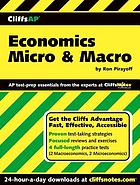 CliffsAP Economics Micro and Macro
by
CliffsAP study guides help you gain an edge on Advanced Placement* exams. Review exercises, realistic practice exams, and effective test-taking strategies are the key to calmer nerves and higher AP* scores. CliffsAP Economics Micro & Macro is for students who are enrolled in AP Economics or who are preparing for the Advanced Placement Examination in Economics to earn college credit and/or placement into advanced coursework at the college level. Inside, you'll find test-taking strategies, a clear explanation of the exam format, a look at how exams are graded, and more: A topic-by-topic look at what's on the exam Reviews of both micro- and macroeconomics A checklist of the materials you'll need on test day Four full-length practice tests Sample questions (and answers!) and practice tests reinforce what you've learned in areas such as product and factor markets, supply and demand, and price elasticity. CliffsAP Economics Mirco & Macro also includes information on the following: Gross Domestic Product Aggregate supply and demand Fiscal policies Production costs Profit maximizations The government's role International economics This comprehensive guide offers a thorough review of key concepts and detailed answer explanations. It's all you need to do your best -- and get the college credits you deserve. *Advanced Placement Program and AP are registered trademarks of the College Board, which was not involved in the production of, and does not endorse this product.
CliffsAP Economics Micro and Macro
by
CliffsAP study guides help you gain an edge on Advanced Placement* exams. Review exercises, realistic practice exams, and effective test-taking strategies are the key to calmer nerves and higher AP* scores. CliffsAP Economics Micro & Macro is for students who are enrolled in AP Economics or who are preparing for the Advanced Placement Examination in Economics to earn college credit and/or placement into advanced coursework at the college level. Inside, you'll find test-taking strategies, a clear explanation of the exam format, a look at how exams are graded, and more: A topic-by-topic look at what's on the exam Reviews of both micro- and macroeconomics A checklist of the materials you'll need on test day Four full-length practice tests Sample questions (and answers!) and practice tests reinforce what you've learned in areas such as product and factor markets, supply and demand, and price elasticity. CliffsAP Economics Mirco & Macro also includes information on the following: Gross Domestic Product Aggregate supply and demand Fiscal policies Production costs Profit maximizations The government's role International economics This comprehensive guide offers a thorough review of key concepts and detailed answer explanations. It's all you need to do your best -- and get the college credits you deserve. *Advanced Placement Program and AP are registered trademarks of the College Board, which was not involved in the production of, and does not endorse this product.
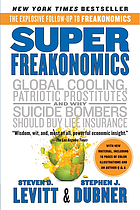 SuperFreakonomics: global cooling, patriotic prostitutes, and why suicide bombers should buy life insurance
by
Freakonomics lived on theNew York Times bestseller list for an astonishing two years. Now authors Steven D. Levitt and Stephen J. Dubner return with more iconoclastic insights and observations inSuperFreakonomics--the long awaited follow-up to their New York Times Notable blockbuster. Based on revolutionary research and original studies SuperFreakonomics promises to once again challenge our view of the way the world really works.
SuperFreakonomics: global cooling, patriotic prostitutes, and why suicide bombers should buy life insurance
by
Freakonomics lived on theNew York Times bestseller list for an astonishing two years. Now authors Steven D. Levitt and Stephen J. Dubner return with more iconoclastic insights and observations inSuperFreakonomics--the long awaited follow-up to their New York Times Notable blockbuster. Based on revolutionary research and original studies SuperFreakonomics promises to once again challenge our view of the way the world really works.
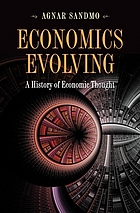 Economics Evolving: a history of economic thought
by
In clear, nontechnical language, this introductory textbook describes the history of economic thought, focusing on the development of economic theory from Adam Smith's Wealth of Nations to the late twentieth century. The text concentrates on the most important figures in the history of economics, from Smith, Thomas Robert Malthus, David Ricardo, John Stuart Mill, and Karl Marx in the classical period to John Maynard Keynes and the leading economists of the postwar era, such as John Hicks, Milton Friedman, and Paul Samuelson. It describes the development of theories concerning prices and markets, money and the price level, population and capital accumulation, and the choice between socialism and the market economy. The book examines how important economists have reflected on the sometimes conflicting goals of efficient resource use and socially acceptable income distribution. It also provides sketches of the lives and times of the major economists. Economics Evolving repeatedly shows how apparently simple ideas that are now taken for granted were at one time at the cutting edge of economics research. For example, the demand curve that today's students probably get to know during their first economics lecture was originally drawn by one of the most innovative theorists in the history of the subject. The book demonstrates not only how the study of economics has progressed over the course of its history, but also that it is still a developing science.
Economics Evolving: a history of economic thought
by
In clear, nontechnical language, this introductory textbook describes the history of economic thought, focusing on the development of economic theory from Adam Smith's Wealth of Nations to the late twentieth century. The text concentrates on the most important figures in the history of economics, from Smith, Thomas Robert Malthus, David Ricardo, John Stuart Mill, and Karl Marx in the classical period to John Maynard Keynes and the leading economists of the postwar era, such as John Hicks, Milton Friedman, and Paul Samuelson. It describes the development of theories concerning prices and markets, money and the price level, population and capital accumulation, and the choice between socialism and the market economy. The book examines how important economists have reflected on the sometimes conflicting goals of efficient resource use and socially acceptable income distribution. It also provides sketches of the lives and times of the major economists. Economics Evolving repeatedly shows how apparently simple ideas that are now taken for granted were at one time at the cutting edge of economics research. For example, the demand curve that today's students probably get to know during their first economics lecture was originally drawn by one of the most innovative theorists in the history of the subject. The book demonstrates not only how the study of economics has progressed over the course of its history, but also that it is still a developing science.
 An Encyclopedia of Keynesian Economics
by
This thoroughly revised and updated second edition of a highly acclaimed and authoritative reference work introduces the major concepts in the field of Keynesian economics.The comprehensive Encyclopedia features accessible, informative and provocative contributions by leading international scholars working in the tradition of Keynes. It brings together widely dispersed yet theoretically congruent ideas, presents concise biographies of economists who have contributed to the debate on Keynes and the Keynesian Revolution, and outlines the basic principles, models and tools used to discuss the economic consequences of The General Theory. Longer entries on specific topics associated with Keynes and the Keynesian Revolution analyse the principal factors that contributed to The General Theory, the economics of Keynes and the rise and apparent decline of Keynesian economics in greater detail.The second edition will ensure that An Encyclopedia of Keynesian Economics will remain the best single reference source on Keynesian economics and will continue to be welcomed by academics, students and teachers of economics as well as by scholars in related social sciences and government policymakers.
An Encyclopedia of Keynesian Economics
by
This thoroughly revised and updated second edition of a highly acclaimed and authoritative reference work introduces the major concepts in the field of Keynesian economics.The comprehensive Encyclopedia features accessible, informative and provocative contributions by leading international scholars working in the tradition of Keynes. It brings together widely dispersed yet theoretically congruent ideas, presents concise biographies of economists who have contributed to the debate on Keynes and the Keynesian Revolution, and outlines the basic principles, models and tools used to discuss the economic consequences of The General Theory. Longer entries on specific topics associated with Keynes and the Keynesian Revolution analyse the principal factors that contributed to The General Theory, the economics of Keynes and the rise and apparent decline of Keynesian economics in greater detail.The second edition will ensure that An Encyclopedia of Keynesian Economics will remain the best single reference source on Keynesian economics and will continue to be welcomed by academics, students and teachers of economics as well as by scholars in related social sciences and government policymakers.
 Schaum's Outline of Introduction to Mathematical Economics, 3rd Edition
by
The ideal review for your intro to mathematical economics course More than 40 million students have trusted Schaum's Outlines for their expert knowledge and helpful solved problems. Written by renowned experts in their respective fields, Schaum's Outlines cover everything from math to science, nursing to language. The main feature for all these books is the solved problems. Step-by-step, authors walk readers through coming up with solutions to exercises in their topic of choice. Outline format supplies a concise guide to the standard college courses in mathematical economics 710 solved problems Clear, concise explanations of all mathematical economics concepts Supplements the major bestselling textbooks in economics courses Appropriate for the following courses: Introduction to Economics, Economics, Econometrics, Microeconomics, Macroeconomics, Economics Theories, Mathematical Economics, Math for Economists, Math for Social Sciences Easily understood review of mathematical economics Supports all the major textbooks for mathematical economics courses
Schaum's Outline of Introduction to Mathematical Economics, 3rd Edition
by
The ideal review for your intro to mathematical economics course More than 40 million students have trusted Schaum's Outlines for their expert knowledge and helpful solved problems. Written by renowned experts in their respective fields, Schaum's Outlines cover everything from math to science, nursing to language. The main feature for all these books is the solved problems. Step-by-step, authors walk readers through coming up with solutions to exercises in their topic of choice. Outline format supplies a concise guide to the standard college courses in mathematical economics 710 solved problems Clear, concise explanations of all mathematical economics concepts Supplements the major bestselling textbooks in economics courses Appropriate for the following courses: Introduction to Economics, Economics, Econometrics, Microeconomics, Macroeconomics, Economics Theories, Mathematical Economics, Math for Economists, Math for Social Sciences Easily understood review of mathematical economics Supports all the major textbooks for mathematical economics courses
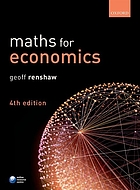 Maths for Economics 4e
by
Drawing on his extensive experience teaching in the area, Geoff Renshaw has developed Maths for Economics to enable students to master and apply mathematical principles and methods both in their degrees and their careers. Through the use of a gradual learning gradient and the provision of examples and exercises to constantly reinforce learning, the author has created a resource which students can use to build their confidence - whether coming from a background of a GCSE or A Level course, or more generally for students who feel they need to go back to the very basics. Knowledge is built up in small steps rather than big jumps, and once confident that they have firmly grasped the foundations, the book helps students to make the progression beyond mechanical exercises and on to the development of a maths tool-kit for the analysis of economic and business problems - an invaluable skill for their course and future employment. The Online Resource Centre contains the following resources: For Students: Ask the author forum Excel tutorial Maple tutorial Further exercises Answers to further questions Expanded solutions to progress exercises For Lecturers (password protected): Test exercises Graphs from the book Answers to test exercises PowerPoint presentations Instructor manual
Maths for Economics 4e
by
Drawing on his extensive experience teaching in the area, Geoff Renshaw has developed Maths for Economics to enable students to master and apply mathematical principles and methods both in their degrees and their careers. Through the use of a gradual learning gradient and the provision of examples and exercises to constantly reinforce learning, the author has created a resource which students can use to build their confidence - whether coming from a background of a GCSE or A Level course, or more generally for students who feel they need to go back to the very basics. Knowledge is built up in small steps rather than big jumps, and once confident that they have firmly grasped the foundations, the book helps students to make the progression beyond mechanical exercises and on to the development of a maths tool-kit for the analysis of economic and business problems - an invaluable skill for their course and future employment. The Online Resource Centre contains the following resources: For Students: Ask the author forum Excel tutorial Maple tutorial Further exercises Answers to further questions Expanded solutions to progress exercises For Lecturers (password protected): Test exercises Graphs from the book Answers to test exercises PowerPoint presentations Instructor manual
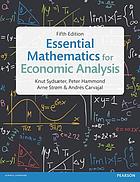 Essential Mathematics for Economic Analysis
by
An extensive introduction to all the mathematical tools an economist needs is provided in this worldwide bestseller.
Essential Mathematics for Economic Analysis
by
An extensive introduction to all the mathematical tools an economist needs is provided in this worldwide bestseller.
 Fundamental Methods of Mathematical Economics
by
It has been 20 years since the last edition of this classic text. Kevin Wainwright, a long time user of the text (British Columbia University and Simon Fraser University), has executed the perfect revision---he has updated examples, applications and theory without changing the elegant, precise presentation style of Alpha Chiang. Readers will find the wait was worthwhile.
Fundamental Methods of Mathematical Economics
by
It has been 20 years since the last edition of this classic text. Kevin Wainwright, a long time user of the text (British Columbia University and Simon Fraser University), has executed the perfect revision---he has updated examples, applications and theory without changing the elegant, precise presentation style of Alpha Chiang. Readers will find the wait was worthwhile.
 Mathematics for Economists
by
An abundance of applications to current economic analysis, illustrative diagrams, thought-provoking exercises, careful proofs, and a flexible organization-these are the advantages that Mathematics for Economists brings to today's classroom.
Mathematics for Economists
by
An abundance of applications to current economic analysis, illustrative diagrams, thought-provoking exercises, careful proofs, and a flexible organization-these are the advantages that Mathematics for Economists brings to today's classroom.
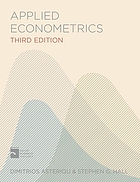 Applied Econometrics
by
This textbook offers a unique blend of theory and practical application. Taking students from a basic level up to an advanced understanding in an intuitive, step-by-step fashion, it provides perfect preparation for doing applied econometric work. Economic tests and methods of estimation are presented clearly, and practical guidance on using several types of software packages is given. Real world data is used throughout and emphasis is given to the interpretation of the results, and the conclusions to be drawn from them in econometric work. This book will be core reading for undergraduate and Master's students on an Economics or Finance degree, who take a course in applied econometrics. Its practical nature makes it perfect for modules requiring a research project.
Applied Econometrics
by
This textbook offers a unique blend of theory and practical application. Taking students from a basic level up to an advanced understanding in an intuitive, step-by-step fashion, it provides perfect preparation for doing applied econometric work. Economic tests and methods of estimation are presented clearly, and practical guidance on using several types of software packages is given. Real world data is used throughout and emphasis is given to the interpretation of the results, and the conclusions to be drawn from them in econometric work. This book will be core reading for undergraduate and Master's students on an Economics or Finance degree, who take a course in applied econometrics. Its practical nature makes it perfect for modules requiring a research project.
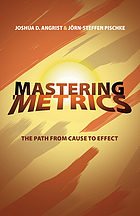 Mastering 'Metrics
by
Applied econometrics, known to aficionados as 'metrics, is the original data science. 'Metrics encompasses the statistical methods economists use to untangle cause and effect in human affairs. Through accessible discussion and with a dose of kung fu-themed humor, Mastering 'Metrics presents the essential tools of econometric research and demonstrates why econometrics is exciting and useful. The five most valuable econometric methods, or what the authors call the Furious Five--random assignment, regression, instrumental variables, regression discontinuity designs, and differences in differences--are illustrated through well-crafted real-world examples (vetted for awesomeness by Kung Fu Panda's Jade Palace). Does health insurance make you healthier? Randomized experiments provide answers. Are expensive private colleges and selective public high schools better than more pedestrian institutions? Regression analysis and a regression discontinuity design reveal the surprising truth. When private banks teeter, and depositors take their money and run, should central banks step in to save them? Differences-in-differences analysis of a Depression-era banking crisis offers a response. Could arresting O. J. Simpson have saved his ex-wife's life? Instrumental variables methods instruct law enforcement authorities in how best to respond to domestic abuse. Wielding econometric tools with skill and confidence, Mastering 'Metrics uses data and statistics to illuminate the path from cause to effect. Shows why econometrics is important Explains econometric research through humorous and accessible discussion Outlines empirical methods central to modern econometric practice Works through interesting and relevant real-world examples
Mastering 'Metrics
by
Applied econometrics, known to aficionados as 'metrics, is the original data science. 'Metrics encompasses the statistical methods economists use to untangle cause and effect in human affairs. Through accessible discussion and with a dose of kung fu-themed humor, Mastering 'Metrics presents the essential tools of econometric research and demonstrates why econometrics is exciting and useful. The five most valuable econometric methods, or what the authors call the Furious Five--random assignment, regression, instrumental variables, regression discontinuity designs, and differences in differences--are illustrated through well-crafted real-world examples (vetted for awesomeness by Kung Fu Panda's Jade Palace). Does health insurance make you healthier? Randomized experiments provide answers. Are expensive private colleges and selective public high schools better than more pedestrian institutions? Regression analysis and a regression discontinuity design reveal the surprising truth. When private banks teeter, and depositors take their money and run, should central banks step in to save them? Differences-in-differences analysis of a Depression-era banking crisis offers a response. Could arresting O. J. Simpson have saved his ex-wife's life? Instrumental variables methods instruct law enforcement authorities in how best to respond to domestic abuse. Wielding econometric tools with skill and confidence, Mastering 'Metrics uses data and statistics to illuminate the path from cause to effect. Shows why econometrics is important Explains econometric research through humorous and accessible discussion Outlines empirical methods central to modern econometric practice Works through interesting and relevant real-world examples
 Econometrics by Example
by
The second edition of this bestselling textbook retains its unique learning-by-doing approach to econometrics. Rather than relying on complex theoretical discussions and complicated mathematics, this book explains econometrics from a practical point of view by walking the student through real-life examples, step by step. Damodar Gujarati's clear, concise, writing style guides students from model formulation, to estimation and hypothesis-testing, through to post-estimation diagnostics. The basic statistics needed to follow the book are covered in an appendix, making the book a flexible and self-contained learning resource. The textbook is ideal for undergraduate students in economics, business, marketing, finance, operations research and related disciplines. It is also intended for students in MBA programs across the social sciences, and for researchers in business, government and research organizations who require econometrics.
Econometrics by Example
by
The second edition of this bestselling textbook retains its unique learning-by-doing approach to econometrics. Rather than relying on complex theoretical discussions and complicated mathematics, this book explains econometrics from a practical point of view by walking the student through real-life examples, step by step. Damodar Gujarati's clear, concise, writing style guides students from model formulation, to estimation and hypothesis-testing, through to post-estimation diagnostics. The basic statistics needed to follow the book are covered in an appendix, making the book a flexible and self-contained learning resource. The textbook is ideal for undergraduate students in economics, business, marketing, finance, operations research and related disciplines. It is also intended for students in MBA programs across the social sciences, and for researchers in business, government and research organizations who require econometrics.
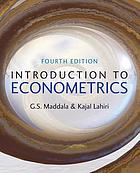 Introduction to Econometrics
by
Now in its fourth edition, this landmark text provides a fresh, accessible and well-written introduction to the subject. With a rigorous pedagogical framework, which sets it apart from comparable texts, the latest edition features an expanded website providing numerous real life data sets and examples.
Introduction to Econometrics
by
Now in its fourth edition, this landmark text provides a fresh, accessible and well-written introduction to the subject. With a rigorous pedagogical framework, which sets it apart from comparable texts, the latest edition features an expanded website providing numerous real life data sets and examples.
 Introduction to econometrics
by
PART I: INTRODUCTION AND REVIEW; 1. Economic Questions and Data; 2. Review of Probability; 3. Review of Statistics; ; PART II: FUNDAMENTALS OF REGRESSION ANALYSIS; 4. Linear Regression with One Regressor; 5. Regression with a Single Regressor: Hypothesis Tests and Confidence Intervals; 6. Linear Regression with Multiple Regressors; 7. Hypothesis Tests and Confidence Intervals in Multiple Regression; 8. Nonlinear Regression Functions; 9. Assessing Studies Based on Multiple Regression; ; PART III: FURTHER TOPICS IN REGRESSION ANALYSIS; 10. Regression with Panel Data; 11. Regression with a Binary Dependent Variable; 12. Instrumental Variables Regression; 13. Experiments and Quasi-Experiments; 14. Prediction with Many Regressors and Big Data; ; PART IV: REGRESSION ANALYSIS OF ECONOMIC TIME SERIES DATA; 15. Introduction to Time Series Regression and Forecasting; 16. Estimation of Dynamic Causal Effects; 17. Additional Topics in Time Series Regression; ; PART V: THE ECONOMIC THEORY OF REGRESSION ANALYSIS; 18. The Theory of Linear Regression with One Regressor; 19. The Theory of Multiple Regression
Introduction to econometrics
by
PART I: INTRODUCTION AND REVIEW; 1. Economic Questions and Data; 2. Review of Probability; 3. Review of Statistics; ; PART II: FUNDAMENTALS OF REGRESSION ANALYSIS; 4. Linear Regression with One Regressor; 5. Regression with a Single Regressor: Hypothesis Tests and Confidence Intervals; 6. Linear Regression with Multiple Regressors; 7. Hypothesis Tests and Confidence Intervals in Multiple Regression; 8. Nonlinear Regression Functions; 9. Assessing Studies Based on Multiple Regression; ; PART III: FURTHER TOPICS IN REGRESSION ANALYSIS; 10. Regression with Panel Data; 11. Regression with a Binary Dependent Variable; 12. Instrumental Variables Regression; 13. Experiments and Quasi-Experiments; 14. Prediction with Many Regressors and Big Data; ; PART IV: REGRESSION ANALYSIS OF ECONOMIC TIME SERIES DATA; 15. Introduction to Time Series Regression and Forecasting; 16. Estimation of Dynamic Causal Effects; 17. Additional Topics in Time Series Regression; ; PART V: THE ECONOMIC THEORY OF REGRESSION ANALYSIS; 18. The Theory of Linear Regression with One Regressor; 19. The Theory of Multiple Regression
 Introductory econometrics : a modern approach
by
Introductory econometrics : a modern approach
by
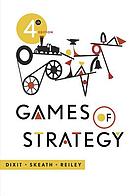 Games of Strategy
by
A clear, comprehensive introduction to the study of game theory. In the Fourth Edition, new real-world examples and compelling end-of-chapter exercises engage students with game theory.
Games of Strategy
by
A clear, comprehensive introduction to the study of game theory. In the Fourth Edition, new real-world examples and compelling end-of-chapter exercises engage students with game theory.
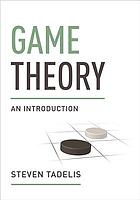 Game Theory
by
The definitive introduction to game theory This comprehensive textbook introduces readers to the principal ideas and applications of game theory, in a style that combines rigor with accessibility. Steven Tadelis begins with a concise description of rational decision making, and goes on to discuss strategic and extensive form games with complete information, Bayesian games, and extensive form games with imperfect information. He covers a host of topics, including multistage and repeated games, bargaining theory, auctions, rent-seeking games, mechanism design, signaling games, reputation building, and information transmission games. Unlike other books on game theory, this one begins with the idea of rationality and explores its implications for multiperson decision problems through concepts like dominated strategies and rationalizability. Only then does it present the subject of Nash equilibrium and its derivatives. Game Theory is the ideal textbook for advanced undergraduate and beginning graduate students. Throughout, concepts and methods are explained using real-world examples backed by precise analytic material. The book features many important applications to economics and political science, as well as numerous exercises that focus on how to formalize informal situations and then analyze them. Introduces the core ideas and applications of game theory Covers static and dynamic games, with complete and incomplete information Features a variety of examples, applications, and exercises Topics include repeated games, bargaining, auctions, signaling, reputation, and information transmission Ideal for advanced undergraduate and beginning graduate students Complete solutions available to teachers and selected solutions available to students
Game Theory
by
The definitive introduction to game theory This comprehensive textbook introduces readers to the principal ideas and applications of game theory, in a style that combines rigor with accessibility. Steven Tadelis begins with a concise description of rational decision making, and goes on to discuss strategic and extensive form games with complete information, Bayesian games, and extensive form games with imperfect information. He covers a host of topics, including multistage and repeated games, bargaining theory, auctions, rent-seeking games, mechanism design, signaling games, reputation building, and information transmission games. Unlike other books on game theory, this one begins with the idea of rationality and explores its implications for multiperson decision problems through concepts like dominated strategies and rationalizability. Only then does it present the subject of Nash equilibrium and its derivatives. Game Theory is the ideal textbook for advanced undergraduate and beginning graduate students. Throughout, concepts and methods are explained using real-world examples backed by precise analytic material. The book features many important applications to economics and political science, as well as numerous exercises that focus on how to formalize informal situations and then analyze them. Introduces the core ideas and applications of game theory Covers static and dynamic games, with complete and incomplete information Features a variety of examples, applications, and exercises Topics include repeated games, bargaining, auctions, signaling, reputation, and information transmission Ideal for advanced undergraduate and beginning graduate students Complete solutions available to teachers and selected solutions available to students
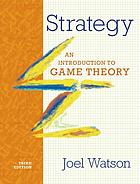 Strategy
by
Joel Watson has refined his successful text to make it even more student-friendly. A number of sections have been added, and numerous chapters have been substantially revised. Dozens of new exercises have been added, along with solutions to selected exercises. Chapters are short and focused, with just the right amount of mathematical content and end-of-chapter exercises. New passages walk students through tricky topics.
Strategy
by
Joel Watson has refined his successful text to make it even more student-friendly. A number of sections have been added, and numerous chapters have been substantially revised. Dozens of new exercises have been added, along with solutions to selected exercises. Chapters are short and focused, with just the right amount of mathematical content and end-of-chapter exercises. New passages walk students through tricky topics.
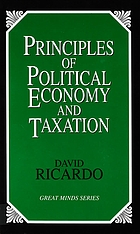 The Principles of Political Economy and Taxation
by
David Ricardo (1772-1823), the founder of the classical school of economics, applied the deductive logic of the philosopher James Mill to the analysis of monetary principles. His chief work, Principles of Political Economy and Taxation, first published in 1817, had a profound impact and remains one of the groundworks of modern economics. Ricardo's labor theory of value, as well as his elaboration of the division of incomes, and the function of wages, rent, and trade, deeply influenced the economic philosophies of Karl Marx, John Stuart Mill, Alfred Marshall, and many others.
The Principles of Political Economy and Taxation
by
David Ricardo (1772-1823), the founder of the classical school of economics, applied the deductive logic of the philosopher James Mill to the analysis of monetary principles. His chief work, Principles of Political Economy and Taxation, first published in 1817, had a profound impact and remains one of the groundworks of modern economics. Ricardo's labor theory of value, as well as his elaboration of the division of incomes, and the function of wages, rent, and trade, deeply influenced the economic philosophies of Karl Marx, John Stuart Mill, Alfred Marshall, and many others.
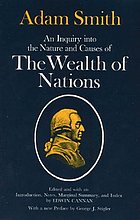 An Inquiry into the Nature and Causes of the Wealth of Nations
by
Adam Smith's The Wealth of Nations was recognized as a landmark of human thought upon its publication in 1776. As the first scientific argument for the principles of political economy, it is the point of departure for all subsequent economic thought. Smith's theories of capital accumulation, growth, and secular change, among others, continue to be influential in modern economics. This reprint of Edwin Cannan's definitive 1904 edition of The Wealth of Nations includes Cannan's famous introduction, notes, and a full index, as well as a new preface written especially for this edition by the distinguished economist George J. Stigler. Mr. Stigler's preface will be of value for anyone wishing to see the contemporary relevance of Adam Smith's thought.
An Inquiry into the Nature and Causes of the Wealth of Nations
by
Adam Smith's The Wealth of Nations was recognized as a landmark of human thought upon its publication in 1776. As the first scientific argument for the principles of political economy, it is the point of departure for all subsequent economic thought. Smith's theories of capital accumulation, growth, and secular change, among others, continue to be influential in modern economics. This reprint of Edwin Cannan's definitive 1904 edition of The Wealth of Nations includes Cannan's famous introduction, notes, and a full index, as well as a new preface written especially for this edition by the distinguished economist George J. Stigler. Mr. Stigler's preface will be of value for anyone wishing to see the contemporary relevance of Adam Smith's thought.
 Economics: the User's Guide
by
In his bestselling 23 Things They Don't Tell You About Capitalism, Cambridge economist Ha-Joon Chang brilliantly debunked many of the predominant myths of neoclassical economics. Now, in an entertaining and accessible primer, he explains how the global economy actually works-in real-world terms. Writing with irreverent wit, a deep knowledge of history, and a disregard for conventional economic pieties, Chang offers insights that will never be found in the textbooks. Unlike many economists, who present only one view of their discipline, Chang introduces a wide range of economic theories, from classical to Keynesian, revealing how each has its strengths and weaknesses, and why there is no one way to explain economic behavior. Instead, by ignoring the received wisdom and exposing the myriad forces that shape our financial world, Chang gives us the tools we need to understand our increasingly global and interconnected world often driven by economics. From the future of the Euro, inequality in China, or the condition of the American manufacturing industry here in the United States-Economics: The User's Guide is a concise and expertly crafted guide to economic fundamentals that offers a clear and accurate picture of the global economy and how and why it affects our daily lives.
Economics: the User's Guide
by
In his bestselling 23 Things They Don't Tell You About Capitalism, Cambridge economist Ha-Joon Chang brilliantly debunked many of the predominant myths of neoclassical economics. Now, in an entertaining and accessible primer, he explains how the global economy actually works-in real-world terms. Writing with irreverent wit, a deep knowledge of history, and a disregard for conventional economic pieties, Chang offers insights that will never be found in the textbooks. Unlike many economists, who present only one view of their discipline, Chang introduces a wide range of economic theories, from classical to Keynesian, revealing how each has its strengths and weaknesses, and why there is no one way to explain economic behavior. Instead, by ignoring the received wisdom and exposing the myriad forces that shape our financial world, Chang gives us the tools we need to understand our increasingly global and interconnected world often driven by economics. From the future of the Euro, inequality in China, or the condition of the American manufacturing industry here in the United States-Economics: The User's Guide is a concise and expertly crafted guide to economic fundamentals that offers a clear and accurate picture of the global economy and how and why it affects our daily lives.
 Economics of Public Issues
by
For principles of economics, public policy, and social issues courses. Brief, relevant readings that spark independent thinking and classroom discussions The Economics of Public Issues is a collection of brief, relevant readings that spark independent thinking and classroom discussion in principles of economics and social issues. The 20th Edition encourages students to apply theoretical discussions to today's important issues to gain a deeper understanding of current microeconomic policy concerns.
Economics of Public Issues
by
For principles of economics, public policy, and social issues courses. Brief, relevant readings that spark independent thinking and classroom discussions The Economics of Public Issues is a collection of brief, relevant readings that spark independent thinking and classroom discussion in principles of economics and social issues. The 20th Edition encourages students to apply theoretical discussions to today's important issues to gain a deeper understanding of current microeconomic policy concerns.
 Economics
by
Steve Slavin's lively and comprehensive Economics 11e has a student-friendly, step-by-step approach. As in previous editions, Slavin introduces more math review than other products to help students get past math phobias through consistent practice. The content is set up as a workbook, encouraging students to fill in tables and graphs and work problems as they read to actively engage with the material. Matched with the extensive learning aids available in Connect, including the adaptive study tool LearnSmart, Slavin provides a complete learning environment for the introductory economics student. Connect is the only integrated learning system that empowers students by continuously adapting to deliver precisely what they need, when they need it, and how they need it, so that your class time is more engaging and effective.
Economics
by
Steve Slavin's lively and comprehensive Economics 11e has a student-friendly, step-by-step approach. As in previous editions, Slavin introduces more math review than other products to help students get past math phobias through consistent practice. The content is set up as a workbook, encouraging students to fill in tables and graphs and work problems as they read to actively engage with the material. Matched with the extensive learning aids available in Connect, including the adaptive study tool LearnSmart, Slavin provides a complete learning environment for the introductory economics student. Connect is the only integrated learning system that empowers students by continuously adapting to deliver precisely what they need, when they need it, and how they need it, so that your class time is more engaging and effective.
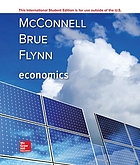 Economics principles, problems and policies
by
Economics principles, problems and policies
by
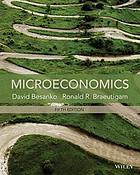 Microeconomics
by
Microeconomics, 5th Edition gives students themost effective approach for learning microeconomic tools andconcepts. This text provides an accessible, integrated structurewith numerous practice problems, exercises, and engagingapplications. Worked-out Learning-by-Doing problems,mathematical and graphical data, and verbal explanations enablebusiness and economics majors to recognize significant data,patterns, and trends. Microeconomics, 5th Edition is also available asa Wiley E-Text: Powered by VitalSource enhanced with dynamiccontent to further enrich student learning.
Microeconomics
by
Microeconomics, 5th Edition gives students themost effective approach for learning microeconomic tools andconcepts. This text provides an accessible, integrated structurewith numerous practice problems, exercises, and engagingapplications. Worked-out Learning-by-Doing problems,mathematical and graphical data, and verbal explanations enablebusiness and economics majors to recognize significant data,patterns, and trends. Microeconomics, 5th Edition is also available asa Wiley E-Text: Powered by VitalSource enhanced with dynamiccontent to further enrich student learning.
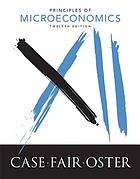 Principles of Microeconomics
by
Reviewers tell us that Case/Fair/Oster is one of the all-time bestselling Principles of Economics texts because they trust it to be clear, thorough, and complete. Readers of Principles of Microeconomics, Twelfth Edition come away with a basic understanding of how market economies function, an appreciation for the things they do well, and a sense of things they do poorly. With the latest research and added exercises, readers begin to learn the art and science of economic thinking and start to look at some policy and even personal decisions in a different way. KEY TOPICS: The Scope and Method of Economics; The Economic Problem: Scarcity and Choice; Demand, Supply, and Market Equilibrium; Demand and Supply Applications; Elasticity; Household Behavior and Consumer Choice; The Production Process: The Behavior of Profit-Maximizing Firms; Short-Run Costs and Output Decisions; Long-Run Costs and Output Decisions; Input Demand: The Labor and Land Markets; Input Demand: The Capital Market and the Investment Decision; General Equilibrium and the Efficiency of Perfect Competition; Monopoly and Antitrust Policy; Oligopoly; Monopolistic Competition; Externalities, Public Goods, and Common Resources; Uncertainty and Asymmetric Information; Income Distribution and Poverty; Public Finance: The Economics of Taxation; International Trade, Comparative Advantage, and Protectionism; Economic Growth in Developing Economies; Critical Thinking about Research MARKET: For readers interested in the principles of microeconomics.
Principles of Microeconomics
by
Reviewers tell us that Case/Fair/Oster is one of the all-time bestselling Principles of Economics texts because they trust it to be clear, thorough, and complete. Readers of Principles of Microeconomics, Twelfth Edition come away with a basic understanding of how market economies function, an appreciation for the things they do well, and a sense of things they do poorly. With the latest research and added exercises, readers begin to learn the art and science of economic thinking and start to look at some policy and even personal decisions in a different way. KEY TOPICS: The Scope and Method of Economics; The Economic Problem: Scarcity and Choice; Demand, Supply, and Market Equilibrium; Demand and Supply Applications; Elasticity; Household Behavior and Consumer Choice; The Production Process: The Behavior of Profit-Maximizing Firms; Short-Run Costs and Output Decisions; Long-Run Costs and Output Decisions; Input Demand: The Labor and Land Markets; Input Demand: The Capital Market and the Investment Decision; General Equilibrium and the Efficiency of Perfect Competition; Monopoly and Antitrust Policy; Oligopoly; Monopolistic Competition; Externalities, Public Goods, and Common Resources; Uncertainty and Asymmetric Information; Income Distribution and Poverty; Public Finance: The Economics of Taxation; International Trade, Comparative Advantage, and Protectionism; Economic Growth in Developing Economies; Critical Thinking about Research MARKET: For readers interested in the principles of microeconomics.
 Advanced Microeconomic Theory
by
An introduction to advanced topics in microeconomics that emphasizes the intuition behind assumptions and results, providing examples that show how to apply theory to practice.This textbook offers an introduction to advanced microeconomic theory that emphasizes the intuition behind mathematical assumptions, providing step-by-step examples that show how to apply theoretical models. It covers standard topics such as preference relations, demand theory and applications, producer theory, choice under uncertainty, partial and general equilibrium, monopoly, game theory and imperfect competition, externalities and public goods, and contract theory; but its intuitive and application-oriented approach provides students with a bridge to more technical topics. The book can be used by advanced undergraduates as well as Masters students in economics, finance, and public policy, and by PhD students in programs with an applied focus. The text connects each topic with recent findings in behavioral and experimental economics, and discusses these results in context, within the appropriate chapter. Step-by-step examples appear immediately after the main theoretical findings, and end-of chapter exercises help students understand how to approach similar exercises on their own. An appendix reviews basic mathematical concepts. A separate workbook, Practice Exercises for Advanced Microeconomic Theory, offers solutions to selected problems with detailed explanations. The textbook and workbook together help students improve both their theoretical and practical preparation in advanced microeconomics.
Advanced Microeconomic Theory
by
An introduction to advanced topics in microeconomics that emphasizes the intuition behind assumptions and results, providing examples that show how to apply theory to practice.This textbook offers an introduction to advanced microeconomic theory that emphasizes the intuition behind mathematical assumptions, providing step-by-step examples that show how to apply theoretical models. It covers standard topics such as preference relations, demand theory and applications, producer theory, choice under uncertainty, partial and general equilibrium, monopoly, game theory and imperfect competition, externalities and public goods, and contract theory; but its intuitive and application-oriented approach provides students with a bridge to more technical topics. The book can be used by advanced undergraduates as well as Masters students in economics, finance, and public policy, and by PhD students in programs with an applied focus. The text connects each topic with recent findings in behavioral and experimental economics, and discusses these results in context, within the appropriate chapter. Step-by-step examples appear immediately after the main theoretical findings, and end-of chapter exercises help students understand how to approach similar exercises on their own. An appendix reviews basic mathematical concepts. A separate workbook, Practice Exercises for Advanced Microeconomic Theory, offers solutions to selected problems with detailed explanations. The textbook and workbook together help students improve both their theoretical and practical preparation in advanced microeconomics.
 Practice Exercises for Advanced Microeconomic Theory
by
Solutions and detailed explanations for odd-numbered end-of-chapter exercises (107 problems) in Felix Muñoz-Garcia's Advanced Microeconomic Theory. Felix Muñoz-Garcia's Advanced Microeconomic Theory provides examples and exercises that help students understand how to apply theoretical models and offers tools for approaching similar problems on their own. This workbook provides solutions and step-by-step explanations for the odd-numbered exercises (107 problems in total). The answer key and detailed explanations emphasize the economic intuition behind the mathematical assumptions and results and, in combination with the textbook, enable students to improve both their theoretical and practical preparation.
Practice Exercises for Advanced Microeconomic Theory
by
Solutions and detailed explanations for odd-numbered end-of-chapter exercises (107 problems) in Felix Muñoz-Garcia's Advanced Microeconomic Theory. Felix Muñoz-Garcia's Advanced Microeconomic Theory provides examples and exercises that help students understand how to apply theoretical models and offers tools for approaching similar problems on their own. This workbook provides solutions and step-by-step explanations for the odd-numbered exercises (107 problems in total). The answer key and detailed explanations emphasize the economic intuition behind the mathematical assumptions and results and, in combination with the textbook, enable students to improve both their theoretical and practical preparation.
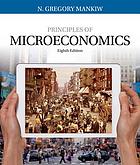 Principles of Microeconomics
by
Now you can master the principles of microeconomics with the help of the most popular, widely-used economics textbook by students worldwide -- Mankiw�s PRINCIPLES OF MICROECONOMICS, 8E. With its clear and engaging writing style, this book emphasizes only the material that will help you better understand the world in which you live, will make you a more astute participant in the economy, and will give you a better understanding of both the potential and limits of economic policy. The latest relevant examples bring microeconomic principles to life. Acclaimed text author N. Gregory Mankiw explains, "I have tried to put myself in the position of someone seeing economics for the first time. My goal is to emphasize the material that students should and do find interesting about the study of the economy." The powerful MindTap student-focused digital resource is available and sold separately. Its digital learning and homework solutions reinforce the principles presented in this edition.
Principles of Microeconomics
by
Now you can master the principles of microeconomics with the help of the most popular, widely-used economics textbook by students worldwide -- Mankiw�s PRINCIPLES OF MICROECONOMICS, 8E. With its clear and engaging writing style, this book emphasizes only the material that will help you better understand the world in which you live, will make you a more astute participant in the economy, and will give you a better understanding of both the potential and limits of economic policy. The latest relevant examples bring microeconomic principles to life. Acclaimed text author N. Gregory Mankiw explains, "I have tried to put myself in the position of someone seeing economics for the first time. My goal is to emphasize the material that students should and do find interesting about the study of the economy." The powerful MindTap student-focused digital resource is available and sold separately. Its digital learning and homework solutions reinforce the principles presented in this edition.
 Intermediate Microeconomics and Its Application (Book Only)
by
INTERMEDIATE MICROECONOMICS AND ITS APPLICATION offers an exceptionally clear and concise introduction to the economics of markets. This proven text uses a managerial focus and includes relevant applications and strong examples as well as step-by-step video problems, an algebraic approach, and activities that allow you to learn by doing. Your purchase also includes online resources on CourseMate, including a complete eBook, step-by-step video problems, solutions to odd=numbered questions, and interactive quizzes.
Intermediate Microeconomics and Its Application (Book Only)
by
INTERMEDIATE MICROECONOMICS AND ITS APPLICATION offers an exceptionally clear and concise introduction to the economics of markets. This proven text uses a managerial focus and includes relevant applications and strong examples as well as step-by-step video problems, an algebraic approach, and activities that allow you to learn by doing. Your purchase also includes online resources on CourseMate, including a complete eBook, step-by-step video problems, solutions to odd=numbered questions, and interactive quizzes.
 Microeconomic theory : basic principles and extensions
by
Microeconomic theory : basic principles and extensions
by
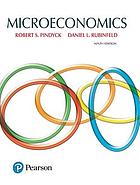 Microeconomics
by
For Intermediate Microeconomics courses. This package includes MyLab Economics. Microeconomics and its role in decision making and public policy Microeconomics exposes readers to topics that play a central role in microeconomics. From game theory and competitive strategy, to the roles of uncertainty and information, and the analysis of pricing by firms with market power, the text helps you understand what's going on in the world of business. It also shows you how microeconomics can be used as a practical tool for decision-making and for designing and understanding public policy. The 9th Edition further illustrates microeconomics' relevance and usefulness with new coverage and examples, and an improved exposition that is clear and accessible as well as lively and engaging. With Microeconomics, you will be able to fully appreciate how a modern economy functions. Also available with MyLab Economics MyLab(tm) Economics is an online homework, tutorial, and assessment program designed to work with this text to engage students and improve results. Within its structured environment, students practice what they learn, test their understanding, and pursue a personalized study plan that helps them better absorb course material and understand difficult concepts. NOTE: You are purchasing a standalone product. MyLab Economics does not come packaged with this product. If you would like to purchase both the physical text and MyLab Economics, search for: 0134086317 / 9780134086316 Microeconomics Plus MyLab Economics with Pearson eText -- Access Card Package, 9/e Package consists of: 0134143078 / 9780134143071 MyLab Economics with Pearson eText -- Access Card -- for Microeconomics 0134184246 / 9780134184241 Microeconomics
Microeconomics
by
For Intermediate Microeconomics courses. This package includes MyLab Economics. Microeconomics and its role in decision making and public policy Microeconomics exposes readers to topics that play a central role in microeconomics. From game theory and competitive strategy, to the roles of uncertainty and information, and the analysis of pricing by firms with market power, the text helps you understand what's going on in the world of business. It also shows you how microeconomics can be used as a practical tool for decision-making and for designing and understanding public policy. The 9th Edition further illustrates microeconomics' relevance and usefulness with new coverage and examples, and an improved exposition that is clear and accessible as well as lively and engaging. With Microeconomics, you will be able to fully appreciate how a modern economy functions. Also available with MyLab Economics MyLab(tm) Economics is an online homework, tutorial, and assessment program designed to work with this text to engage students and improve results. Within its structured environment, students practice what they learn, test their understanding, and pursue a personalized study plan that helps them better absorb course material and understand difficult concepts. NOTE: You are purchasing a standalone product. MyLab Economics does not come packaged with this product. If you would like to purchase both the physical text and MyLab Economics, search for: 0134086317 / 9780134086316 Microeconomics Plus MyLab Economics with Pearson eText -- Access Card Package, 9/e Package consists of: 0134143078 / 9780134143071 MyLab Economics with Pearson eText -- Access Card -- for Microeconomics 0134184246 / 9780134184241 Microeconomics
 Microeconomics: theory and applications with calculus
by
Significantly revised and updated with new real-world examples, exercises, and applications, this Fourth Edition of Microeconomics: Theory and Applications with Calculus remains the premiere microeconomics text to marry formal theory with robust, thoroughly analyzed real-world problems. Aimed at readers who possess a basic understanding of microeconomics, Perloff introduces economic theory through a combination of calculus, algebra, and graphs. The text integrates estimated, real-world problems and applications, using a step-by-step approach to demonstrate how microeconomic theory can be applied to solve practical problems and policy issues. Compared to other similar texts, the author also places greater emphasis on using contemporary theories--such as game theory and contract theory--to analyze markets. KEY TOPICS: Introduction; Supply and Demand; A Consumer's Constrained Choice; Demand; Consumer Welfare and Policy Analysis; Firms and Production; Costs; Competitive Firms and Markets; Properties and Applications of the Competitive Model; General Equilibrium and Economic Welfare; Monopoly and Monopsony; Pricing and Advertising; Game Theory; Oligopoly and Monopolistic Competition; Factor Markets; Uncertainty; Property Rights, Externalities, Rivalry, and Exclusion; Asymmetric Information; Contracts and Moral Hazards MARKET: For anyone interested in calculus-based intermediate microeconomics.
Microeconomics: theory and applications with calculus
by
Significantly revised and updated with new real-world examples, exercises, and applications, this Fourth Edition of Microeconomics: Theory and Applications with Calculus remains the premiere microeconomics text to marry formal theory with robust, thoroughly analyzed real-world problems. Aimed at readers who possess a basic understanding of microeconomics, Perloff introduces economic theory through a combination of calculus, algebra, and graphs. The text integrates estimated, real-world problems and applications, using a step-by-step approach to demonstrate how microeconomic theory can be applied to solve practical problems and policy issues. Compared to other similar texts, the author also places greater emphasis on using contemporary theories--such as game theory and contract theory--to analyze markets. KEY TOPICS: Introduction; Supply and Demand; A Consumer's Constrained Choice; Demand; Consumer Welfare and Policy Analysis; Firms and Production; Costs; Competitive Firms and Markets; Properties and Applications of the Competitive Model; General Equilibrium and Economic Welfare; Monopoly and Monopsony; Pricing and Advertising; Game Theory; Oligopoly and Monopolistic Competition; Factor Markets; Uncertainty; Property Rights, Externalities, Rivalry, and Exclusion; Asymmetric Information; Contracts and Moral Hazards MARKET: For anyone interested in calculus-based intermediate microeconomics.
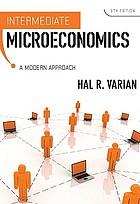 Intermediate Microeconomics
by
Varian is "the Adam Smith of the new discipline of Googlenomics."--Stephen Levy, WiredFor over 20 years Hal Varian's Intermediate Microeconomics has given students the most current and complete coverage of intermediate microeconomics at an appropriate mathematical level. The Eighth Edition includes contemporary case studies and examples and relevant coverage of the current economic crisis--all in focused, lecture-length chapters.
Intermediate Microeconomics
by
Varian is "the Adam Smith of the new discipline of Googlenomics."--Stephen Levy, WiredFor over 20 years Hal Varian's Intermediate Microeconomics has given students the most current and complete coverage of intermediate microeconomics at an appropriate mathematical level. The Eighth Edition includes contemporary case studies and examples and relevant coverage of the current economic crisis--all in focused, lecture-length chapters.
 Macroeconomics
by
For courses in Intermediate Macroeconomics. A Unified Approach to Economic Theory Demonstrating a balanced treatment of both classical and Keynesian economics, Macroecomomics presents macroeconomic theory in a big-picture way. Comprehensive coverage makes it easy for readers to analyze real macroeconomic data used by policy makers and researchers. This text uses a unified approach based on a single economics model that provides readers with a clear understanding of macroeconomics and its classical and Keynesian assumptions. The Ninth Edition features new applications, boxes, and problems throughout and reflects recent events and developments in the field in light of recent crises in the United States and Europe. Also available with MyEconLab MyEconLab is an online homework, tutorial, and assessment program designed to work with this text to engage students and improve results. Within its structured environment, students practice what they learn, test their understanding, and pursue a personalized study plan that helps them better absorb course material and understand difficult concepts. Note: You are purchasing a standalone product; MyLab(tm) & Mastering(tm) does not come packaged with this content. Students, if interested in purchasing this title with MyLab & Mastering, ask your instructor for the correct package ISBN and Course ID. Instructors, contact your Pearson representative for more information. If you would like to purchase both the physical text and MyLab & Mastering, search for: 0134467221 / 9780134467221 Macroeconomics Plus MyEconLab with Pearson eText -- Access Card Package Package consists of: 0134143183 / 9780134143187 MyEconLab with Pearson eText -- Access Card -- for Macroeconomics 0134167392 / 9780134167398 Macroeconomics
Macroeconomics
by
For courses in Intermediate Macroeconomics. A Unified Approach to Economic Theory Demonstrating a balanced treatment of both classical and Keynesian economics, Macroecomomics presents macroeconomic theory in a big-picture way. Comprehensive coverage makes it easy for readers to analyze real macroeconomic data used by policy makers and researchers. This text uses a unified approach based on a single economics model that provides readers with a clear understanding of macroeconomics and its classical and Keynesian assumptions. The Ninth Edition features new applications, boxes, and problems throughout and reflects recent events and developments in the field in light of recent crises in the United States and Europe. Also available with MyEconLab MyEconLab is an online homework, tutorial, and assessment program designed to work with this text to engage students and improve results. Within its structured environment, students practice what they learn, test their understanding, and pursue a personalized study plan that helps them better absorb course material and understand difficult concepts. Note: You are purchasing a standalone product; MyLab(tm) & Mastering(tm) does not come packaged with this content. Students, if interested in purchasing this title with MyLab & Mastering, ask your instructor for the correct package ISBN and Course ID. Instructors, contact your Pearson representative for more information. If you would like to purchase both the physical text and MyLab & Mastering, search for: 0134467221 / 9780134467221 Macroeconomics Plus MyEconLab with Pearson eText -- Access Card Package Package consists of: 0134143183 / 9780134143187 MyEconLab with Pearson eText -- Access Card -- for Macroeconomics 0134167392 / 9780134167398 Macroeconomics
 Macroeconomics
by
In Macroeconomics, Blanchard presents a unified, global view of macroeconomics, enabling readers to see the connections between goods, financial markets, and labor markets worldwide. Organized into two parts, the text contains a core section that focuses on short-, medium-, and long-run markets and three major extensions that offer more in-depth coverage of the issues at hand. From the major economic crisis and monetary policy in the United States, to the problems of the Euro area and growth in China, the text helps readers make sense not only of current macroeconomic events but also of events that may unfold in the future. Integrated, detailed boxes in the Seventh Edition have been updated to convey the life of macroeconomics today; reinforce lessons from the models; and help readers employ and develop their analytical and evaluative skills. KEY TOPICS: The Core; Introduction; A Tour of the World; A Tour of the Book; The Short Run;The Goods Market; Financial Markets I; Goods and Financial Markets; The IS-LM Model; Financial Markets II; The Medium Run;The Labor Market; The Phillips Curve, the Natural Rate of Unemployment, and Inflation; Putting All Markets Together: From the Short to the Medium Run; The Long Run; The Facts of Growth; Saving, Capital Accumulation, and Output; Technological Progress and Growth; Technological Progress: The Short, the Medium, and the Long Runs; Extensions; Expectations; Financial Markets and Expectations; Expectations, Consumption, and Investment; Expectations, Output, and Policy; The Open Economy; Openness in Goods and Financial Markets; The Goods Market in an Open Economy; Output, the Interest Rate, and the Exchange Rate; Exchange Rate Regimes; Back to Policy; Should Policy Makers Be Restrained?; Fiscal Policy: A Summing Up; Monetary Policy: A Summing Up; Epilogue: The Story of Macroeconomics MARKET: For anyone interested in the macroeconomic picture of corporate businesses.
Macroeconomics
by
In Macroeconomics, Blanchard presents a unified, global view of macroeconomics, enabling readers to see the connections between goods, financial markets, and labor markets worldwide. Organized into two parts, the text contains a core section that focuses on short-, medium-, and long-run markets and three major extensions that offer more in-depth coverage of the issues at hand. From the major economic crisis and monetary policy in the United States, to the problems of the Euro area and growth in China, the text helps readers make sense not only of current macroeconomic events but also of events that may unfold in the future. Integrated, detailed boxes in the Seventh Edition have been updated to convey the life of macroeconomics today; reinforce lessons from the models; and help readers employ and develop their analytical and evaluative skills. KEY TOPICS: The Core; Introduction; A Tour of the World; A Tour of the Book; The Short Run;The Goods Market; Financial Markets I; Goods and Financial Markets; The IS-LM Model; Financial Markets II; The Medium Run;The Labor Market; The Phillips Curve, the Natural Rate of Unemployment, and Inflation; Putting All Markets Together: From the Short to the Medium Run; The Long Run; The Facts of Growth; Saving, Capital Accumulation, and Output; Technological Progress and Growth; Technological Progress: The Short, the Medium, and the Long Runs; Extensions; Expectations; Financial Markets and Expectations; Expectations, Consumption, and Investment; Expectations, Output, and Policy; The Open Economy; Openness in Goods and Financial Markets; The Goods Market in an Open Economy; Output, the Interest Rate, and the Exchange Rate; Exchange Rate Regimes; Back to Policy; Should Policy Makers Be Restrained?; Fiscal Policy: A Summing Up; Monetary Policy: A Summing Up; Epilogue: The Story of Macroeconomics MARKET: For anyone interested in the macroeconomic picture of corporate businesses.
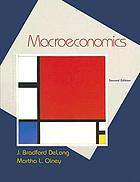 Macroeconomics
by
Part I Preliminaries 1 Introduction to Macroeconomics 2 Measuring the Macroeconomy 3 Thinking Like an Economist Part II Long-Run Economic Growth 4 The Theory of Economic Growth 5 The Reality of Economic Growth: History and Prospect Part III Flexible-Price Macroeconomics 6 Building Blocks of the Flexible-.
Macroeconomics
by
Part I Preliminaries 1 Introduction to Macroeconomics 2 Measuring the Macroeconomy 3 Thinking Like an Economist Part II Long-Run Economic Growth 4 The Theory of Economic Growth 5 The Reality of Economic Growth: History and Prospect Part III Flexible-Price Macroeconomics 6 Building Blocks of the Flexible-.
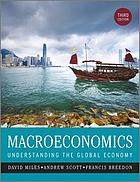 Macroeconomics: understanding the global economy
by
Macroeconomics: Understanding the Global Economy, 3rd Edition is to help students - and indeed anyone - understand contemporary and past economic events that shape the world we live in, and at a sophisticated level. But it does so without focusing on mathematical techniques and models for their own sake. Theory is taken seriously - so much so that the authors go to pains to understand the key aspects of theories in a way that will not put people off before they see how theories are useful to analyse issues. The authors believe that theories are essential to better understand the world, thus the book includes a wealth of historic and current episodes and data to both see how theories can help interpret the world and also to judge their validity. Economies today are very inter-connected; what happens in China matters pretty much everywhere; and what happens in one (even small) country in the euro zone has implications for the whole euro area and beyond, consequently Macroeconomics, 3rd Edition adopts a very international focus.
Macroeconomics: understanding the global economy
by
Macroeconomics: Understanding the Global Economy, 3rd Edition is to help students - and indeed anyone - understand contemporary and past economic events that shape the world we live in, and at a sophisticated level. But it does so without focusing on mathematical techniques and models for their own sake. Theory is taken seriously - so much so that the authors go to pains to understand the key aspects of theories in a way that will not put people off before they see how theories are useful to analyse issues. The authors believe that theories are essential to better understand the world, thus the book includes a wealth of historic and current episodes and data to both see how theories can help interpret the world and also to judge their validity. Economies today are very inter-connected; what happens in China matters pretty much everywhere; and what happens in one (even small) country in the euro zone has implications for the whole euro area and beyond, consequently Macroeconomics, 3rd Edition adopts a very international focus.
 Macroeconomics
by
Macroeconomics
by
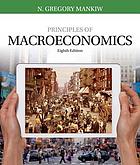 Principles of Microeconomics, Loose-Leaf Version
by
Principles of Microeconomics, Loose-Leaf Version
by
 Theory of Economic Development: an inquiry into profits, capital, credit, interest, and the business cycle
by
Schumpeter proclaims in this classical analysis of capitalist society first published in 1911 that economics is a natural self-regulating mechanism when undisturbed by "social and other meddlers." In his preface he argues that despite weaknesses, theories are based on logic and provide structure for understanding fact. Of those who argue against him, Schumpeter asks a fundamental question: "Is it really artificial to keep separate the phenomena incidental to running a firm and the phenomena incidental to creating a new one?" In his answers, Schumpeter offers guidance to Third World politicians no less than First World businesspeople. In his substantial new introduction, John E. Elliott discusses the salient ideas of The Theory of Economic Development against the historical background of three great periods of economic thought in the last two decades.
Theory of Economic Development: an inquiry into profits, capital, credit, interest, and the business cycle
by
Schumpeter proclaims in this classical analysis of capitalist society first published in 1911 that economics is a natural self-regulating mechanism when undisturbed by "social and other meddlers." In his preface he argues that despite weaknesses, theories are based on logic and provide structure for understanding fact. Of those who argue against him, Schumpeter asks a fundamental question: "Is it really artificial to keep separate the phenomena incidental to running a firm and the phenomena incidental to creating a new one?" In his answers, Schumpeter offers guidance to Third World politicians no less than First World businesspeople. In his substantial new introduction, John E. Elliott discusses the salient ideas of The Theory of Economic Development against the historical background of three great periods of economic thought in the last two decades.
 The Value of Everything: making and taking in the global economy
by
Modern economies reward activities that extract value rather than create it. This must change to ensure a capitalism that works for us all. Shortlisted for the FT & McKinsey Business Book of the Year Award A scathing indictment of our current global financial system, The Value of Everything rigorously scrutinizes the way in which economic value has been accounted and reveals how economic theory has failed to clearly delineate the difference between value creation and value extraction. Mariana Mazzucato argues that the increasingly blurry distinction between the two categories has allowed certain actors in the economy to portray themselves as value creators, while in reality they are just moving around existing value or, even worse, destroying it. The book uses case studies-from Silicon Valley to the financial sector to big pharma-to show how the foggy notions of value create confusion between rents and profits, reward extractors and creators, and distort the measurements of growth and GDP. In the process, innovation suffers and inequality rises. The lesson here is urgent and sobering: to rescue our economy from the next inevitable crisis and to foster long-term economic growth, we will need to rethink capitalism, rethink the role of public policy and the importance of the public sector, and redefine how we measure value in our society.
The Value of Everything: making and taking in the global economy
by
Modern economies reward activities that extract value rather than create it. This must change to ensure a capitalism that works for us all. Shortlisted for the FT & McKinsey Business Book of the Year Award A scathing indictment of our current global financial system, The Value of Everything rigorously scrutinizes the way in which economic value has been accounted and reveals how economic theory has failed to clearly delineate the difference between value creation and value extraction. Mariana Mazzucato argues that the increasingly blurry distinction between the two categories has allowed certain actors in the economy to portray themselves as value creators, while in reality they are just moving around existing value or, even worse, destroying it. The book uses case studies-from Silicon Valley to the financial sector to big pharma-to show how the foggy notions of value create confusion between rents and profits, reward extractors and creators, and distort the measurements of growth and GDP. In the process, innovation suffers and inequality rises. The lesson here is urgent and sobering: to rescue our economy from the next inevitable crisis and to foster long-term economic growth, we will need to rethink capitalism, rethink the role of public policy and the importance of the public sector, and redefine how we measure value in our society.
 The Long Twentieth Century: money, power, and the origins of our times
by
Winner of the American Sociological Association PEWS Award (1995) for Distinguished Scholarship The Long Twentieth Century traces the epochal shifts in the relationship between capital accumulation and state formation over a 700-year period. Giovanni Arrighi masterfully synthesizes social theory, comparative history and historical narrative in this account of the structures and agencies which have shaped the course of world history over the millennium. Borrowing from Braudel, Arrighi argues that the history of capitalism has unfolded as a succession of "long centuries"—ages during which a hegemonic power deploying a novel combination of economic and political networks secured control over an expanding world-economic space. The modest beginnings, rise and violent unravel-ing of the links forged between capital, state power, and geopolitics by hegemonic classes and states are explored with dramatic intensity. From this perspective, Arrighi explains the changing fortunes of Florentine, Venetian, Genoese, Dutch, English, and finally American capitalism. The book concludes with an examination of the forces which have shaped and are now poised to undermine America's world power.
The Long Twentieth Century: money, power, and the origins of our times
by
Winner of the American Sociological Association PEWS Award (1995) for Distinguished Scholarship The Long Twentieth Century traces the epochal shifts in the relationship between capital accumulation and state formation over a 700-year period. Giovanni Arrighi masterfully synthesizes social theory, comparative history and historical narrative in this account of the structures and agencies which have shaped the course of world history over the millennium. Borrowing from Braudel, Arrighi argues that the history of capitalism has unfolded as a succession of "long centuries"—ages during which a hegemonic power deploying a novel combination of economic and political networks secured control over an expanding world-economic space. The modest beginnings, rise and violent unravel-ing of the links forged between capital, state power, and geopolitics by hegemonic classes and states are explored with dramatic intensity. From this perspective, Arrighi explains the changing fortunes of Florentine, Venetian, Genoese, Dutch, English, and finally American capitalism. The book concludes with an examination of the forces which have shaped and are now poised to undermine America's world power.
 Entrepreneurship : successfully launching new ventures Card -- for Entrepreneurship
by
Entrepreneurship: Launching New Ventures, 3e, introduces readers to the process of entrepreneurial success and shows them how to be effective every step of the way. Introduction to Entrepreneurship; Recognizing Opportunities and Generating Ideas; Feasibility Analysis; Writing a Business Plan; Industry and Competitor Analysis; Developing an Effective Business Model; Preparing the Proper Ethical and Legal Foundation; Assessing a New Venture’s Financial Strength and Viability; Building a New Venture Team; Getting Financing or Funding; Unique Marketing Issues; The Importance of Intellectual Property; Preparing for and Evaluating the Challenges of Growth; Strategies for Firm Growth; Franchising For readers interested in starting an entrepreneurial venture in today’s market.
Entrepreneurship : successfully launching new ventures Card -- for Entrepreneurship
by
Entrepreneurship: Launching New Ventures, 3e, introduces readers to the process of entrepreneurial success and shows them how to be effective every step of the way. Introduction to Entrepreneurship; Recognizing Opportunities and Generating Ideas; Feasibility Analysis; Writing a Business Plan; Industry and Competitor Analysis; Developing an Effective Business Model; Preparing the Proper Ethical and Legal Foundation; Assessing a New Venture’s Financial Strength and Viability; Building a New Venture Team; Getting Financing or Funding; Unique Marketing Issues; The Importance of Intellectual Property; Preparing for and Evaluating the Challenges of Growth; Strategies for Firm Growth; Franchising For readers interested in starting an entrepreneurial venture in today’s market.
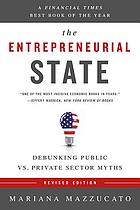 The Entrepreneurial State: debunking public vs. private sector myths
by
The world's most popular products, from the iPhone to Google Search, were funded not by private companies, but the taxpayer. In this sharp and controversial international bestseller, an award-winning economist debunks the pervasive myth that the government is sluggish and inept, and at odds with a dynamic private sector. She reveals in detailed case studies that the opposite is true: the state is, and has been, our boldest and most valuable innovator. Denying this history is leading us down the wrong path. A select few get credit for what is an intensely collective effort, and the US government has started disinvesting from innovation. The repercussions could stunt economic growth and increase inequality. Mazzucato teaches us how to reverse this trend before it is too late.
The Entrepreneurial State: debunking public vs. private sector myths
by
The world's most popular products, from the iPhone to Google Search, were funded not by private companies, but the taxpayer. In this sharp and controversial international bestseller, an award-winning economist debunks the pervasive myth that the government is sluggish and inept, and at odds with a dynamic private sector. She reveals in detailed case studies that the opposite is true: the state is, and has been, our boldest and most valuable innovator. Denying this history is leading us down the wrong path. A select few get credit for what is an intensely collective effort, and the US government has started disinvesting from innovation. The repercussions could stunt economic growth and increase inequality. Mazzucato teaches us how to reverse this trend before it is too late.
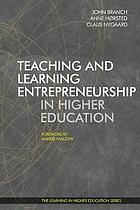 Teaching and learning entrepreneurship in higher education
by
Teaching and learning entrepreneurship in higher education
by
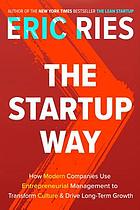 The Startup Way: how modern companies use entrepreneurial management to transform culture and drive long-term growth
by
Entrepreneur and bestselling author of The Lean Startup, Eric Ries reveals how entrepreneurial principles can be used by businesses of all kinds, ranging from established companies to early-stage startups, to grow revenues, drive innovation, and transform themselves into truly modern organizations, poised to take advantage of the enormous opportunities of the twenty-first century. In The Lean Startup, Eric Ries laid out the practices of successful startups - building a minimal viable product, customer-focused and scientific testing based on a build-measure-learn method of continuous innovation, and deciding whether to persevere or pivot. In The Startup Way, he turns his attention to an entirely new group of organizations: established enterprises like iconic multinationals GE and Toyota, tech titans like Amazon and Facebook, and the next generation of Silicon Valley upstarts like Airbnb and Twilio. Drawing on his experiences over the past five years working with these organizations, as well as nonprofits, NGOs, and governments, Ries lays out a system of entrepreneurial management that leads organizations of all sizes and from every industry to sustainable growth and long-term impact. Filled with in-the-field stories, insights, and tools, The Startup Way is an essential road map for any organization navigating the uncertain waters of the century ahead.
The Startup Way: how modern companies use entrepreneurial management to transform culture and drive long-term growth
by
Entrepreneur and bestselling author of The Lean Startup, Eric Ries reveals how entrepreneurial principles can be used by businesses of all kinds, ranging from established companies to early-stage startups, to grow revenues, drive innovation, and transform themselves into truly modern organizations, poised to take advantage of the enormous opportunities of the twenty-first century. In The Lean Startup, Eric Ries laid out the practices of successful startups - building a minimal viable product, customer-focused and scientific testing based on a build-measure-learn method of continuous innovation, and deciding whether to persevere or pivot. In The Startup Way, he turns his attention to an entirely new group of organizations: established enterprises like iconic multinationals GE and Toyota, tech titans like Amazon and Facebook, and the next generation of Silicon Valley upstarts like Airbnb and Twilio. Drawing on his experiences over the past five years working with these organizations, as well as nonprofits, NGOs, and governments, Ries lays out a system of entrepreneurial management that leads organizations of all sizes and from every industry to sustainable growth and long-term impact. Filled with in-the-field stories, insights, and tools, The Startup Way is an essential road map for any organization navigating the uncertain waters of the century ahead.
 Green Consumerism: an A-to-Z guide
by
Via 150 signed entries, Green Consumerism: An A-to-Z Guide offers a wide-ranging examination of green consumerism, one reflecting the diversity of views and debates surrounding the concept. The multiplicity of topics and disciplinary perspectives provides a useful survey of the nature of green consumerism, the forms it takes, the issues impacting it, and the practices it involves. Contributing authors also provide insights into the social and spacial constitution of green consumerism, its multifaceted and sometimes contested contours, and the ways it is embedded and shaped in relation to wider cultural, economic, political and environmental processes. Readers will derive a sense not only of what green consumerism has become, but more critically, how it might evolve, addressing both limitations and possibilities for real and meaningful change. Vivid photographs, searchable hyperlinks, numerous cross references, an extensive resource guide, and a clear, accessible writing style make the Green Society volumes ideal for classroom use as well as for research. Learn more about the Green Series or request a free 30-day online trial to this title at www.sagepub.com/greenseries
Green Consumerism: an A-to-Z guide
by
Via 150 signed entries, Green Consumerism: An A-to-Z Guide offers a wide-ranging examination of green consumerism, one reflecting the diversity of views and debates surrounding the concept. The multiplicity of topics and disciplinary perspectives provides a useful survey of the nature of green consumerism, the forms it takes, the issues impacting it, and the practices it involves. Contributing authors also provide insights into the social and spacial constitution of green consumerism, its multifaceted and sometimes contested contours, and the ways it is embedded and shaped in relation to wider cultural, economic, political and environmental processes. Readers will derive a sense not only of what green consumerism has become, but more critically, how it might evolve, addressing both limitations and possibilities for real and meaningful change. Vivid photographs, searchable hyperlinks, numerous cross references, an extensive resource guide, and a clear, accessible writing style make the Green Society volumes ideal for classroom use as well as for research. Learn more about the Green Series or request a free 30-day online trial to this title at www.sagepub.com/greenseries
 The Wiley Blackwell Encyclopedia of Consumption and Consumer Studies
by
With entries detailing key concepts, persons, and approaches, The Wiley Blackwell Encyclopedia of Consumption and Consumer Studies provides definitive coverage of a field that has grown dramatically in scope and popularity around the world over the last two decades. Includes over 200 A-Z entries varying in length from 500 to 5,000 words, with a list of suggested readings for each entry and cross-references, as well as a lexicon by category, and a timeline Brings together the latest research and theories in the field from international contributors across a range of disciplines, from sociology, cultural studies, and advertising to anthropology, business, and consumer behavior Available online with interactive cross-referencing links and powerful searching capabilities within the work and across Wiley's comprehensive online reference collection or as a single volume in print www.consumptionandconsumerstudies.com
The Wiley Blackwell Encyclopedia of Consumption and Consumer Studies
by
With entries detailing key concepts, persons, and approaches, The Wiley Blackwell Encyclopedia of Consumption and Consumer Studies provides definitive coverage of a field that has grown dramatically in scope and popularity around the world over the last two decades. Includes over 200 A-Z entries varying in length from 500 to 5,000 words, with a list of suggested readings for each entry and cross-references, as well as a lexicon by category, and a timeline Brings together the latest research and theories in the field from international contributors across a range of disciplines, from sociology, cultural studies, and advertising to anthropology, business, and consumer behavior Available online with interactive cross-referencing links and powerful searching capabilities within the work and across Wiley's comprehensive online reference collection or as a single volume in print www.consumptionandconsumerstudies.com
 Schaum's Outline of Microeconomics, Fourth Edition
by
The ideal review for your microeconomics course More than 40 million students have trusted Schaum's Outlines for their expert knowledge and helpful solved problems. Written by renowned experts in their respective fields, Schaum's Outlines cover everything from math to science, nursing to language. The main feature for all these books is the solved problems. Step-by-step, authors walk readers through coming up with solutions to exercises in their topic of choice. 896 solved problems Outline format supplies a concise guide to the standard college course in microeconomics Clear, concise explanations of all Microeconomics concepts Complements and supplements the major microeconomics textbooks Appropriate for the following courses: Principles of Microeconomics, Intermediate Microeconomics, Introduction to Economics, Microeconomic Theory
Schaum's Outline of Microeconomics, Fourth Edition
by
The ideal review for your microeconomics course More than 40 million students have trusted Schaum's Outlines for their expert knowledge and helpful solved problems. Written by renowned experts in their respective fields, Schaum's Outlines cover everything from math to science, nursing to language. The main feature for all these books is the solved problems. Step-by-step, authors walk readers through coming up with solutions to exercises in their topic of choice. 896 solved problems Outline format supplies a concise guide to the standard college course in microeconomics Clear, concise explanations of all Microeconomics concepts Complements and supplements the major microeconomics textbooks Appropriate for the following courses: Principles of Microeconomics, Intermediate Microeconomics, Introduction to Economics, Microeconomic Theory
 Introductory Econometrics: a modern approach
by
Gain an understanding of how econometrics can answer today's questions in business, policy evaluation and forecasting with Wooldridge's INTRODUCTORY ECONOMETRICS: A MODERN APPROACH, 7E. Unlike traditional texts, this book's practical, yet professional, approach demonstrates how econometrics has moved beyond a set of abstract tools to become genuinely useful for answering questions across a variety of disciplines.The author has organized the book's presentation around the type of data being analyzed with a systematic approach that only introduces assumptions as they are needed. This makes the material easier to understand and, ultimately, leads to better econometric practices. Packed with relevant applications, the text incorporates more than 100 data sets in different formats. Updates introduce the latest developments in the field, including the recent advances in the so-called "causal effects" or "treatment effects," to provide a complete understanding of the impact and importance of econometrics today.
Introductory Econometrics: a modern approach
by
Gain an understanding of how econometrics can answer today's questions in business, policy evaluation and forecasting with Wooldridge's INTRODUCTORY ECONOMETRICS: A MODERN APPROACH, 7E. Unlike traditional texts, this book's practical, yet professional, approach demonstrates how econometrics has moved beyond a set of abstract tools to become genuinely useful for answering questions across a variety of disciplines.The author has organized the book's presentation around the type of data being analyzed with a systematic approach that only introduces assumptions as they are needed. This makes the material easier to understand and, ultimately, leads to better econometric practices. Packed with relevant applications, the text incorporates more than 100 data sets in different formats. Updates introduce the latest developments in the field, including the recent advances in the so-called "causal effects" or "treatment effects," to provide a complete understanding of the impact and importance of econometrics today.
 Time Series and Panel Data Econometrics
by
This book is concerned with recent developments in time series and panel data techniques for the analysis of macroeconomic and financial data. It provides a rigorous, nevertheless user-friendly, account of the time series techniques dealing with univariate and multivariate time series models, as well as panel data models.It is distinct from other time series texts in the sense that it also covers panel data models and attempts at a more coherent integration of time series, multivariate analysis, and panel data models. It builds on the author's extensive research in the areas of time series and panel data analysis and covers a wide variety of topics in one volume. Different parts of the book can be used as teaching material for a variety of courses in econometrics. It can also be used as reference manual.It begins with an overview of basic econometric and statistical techniques, and provides an account of stochastic processes, univariate and multivariate time series, tests for unit roots, cointegration, impulse response analysis, autoregressive conditional heteroskedasticity models, simultaneous equation models, vector autoregressions, causality, forecasting, multivariate volatility models, panel data models, aggregation and global vector autoregressive models (GVAR). The techniques are illustrated using Microfit 5 (Pesaran and Pesaran, 2009, OUP) with applications to real output, inflation, interest rates, exchange rates, and stock prices.
Time Series and Panel Data Econometrics
by
This book is concerned with recent developments in time series and panel data techniques for the analysis of macroeconomic and financial data. It provides a rigorous, nevertheless user-friendly, account of the time series techniques dealing with univariate and multivariate time series models, as well as panel data models.It is distinct from other time series texts in the sense that it also covers panel data models and attempts at a more coherent integration of time series, multivariate analysis, and panel data models. It builds on the author's extensive research in the areas of time series and panel data analysis and covers a wide variety of topics in one volume. Different parts of the book can be used as teaching material for a variety of courses in econometrics. It can also be used as reference manual.It begins with an overview of basic econometric and statistical techniques, and provides an account of stochastic processes, univariate and multivariate time series, tests for unit roots, cointegration, impulse response analysis, autoregressive conditional heteroskedasticity models, simultaneous equation models, vector autoregressions, causality, forecasting, multivariate volatility models, panel data models, aggregation and global vector autoregressive models (GVAR). The techniques are illustrated using Microfit 5 (Pesaran and Pesaran, 2009, OUP) with applications to real output, inflation, interest rates, exchange rates, and stock prices.
 Using Econometrics: a practical guide
by
For courses in Econometrics. A Clear, Practical Introduction to Econometrics Using Econometrics: A Practical Guide offers readers an innovative introduction to elementary econometrics. Through real-world examples and exercises, the book covers the topic of single-equation linear regression analysis in an easily understandable format. The Seventh Edition is appropriate for all levels: beginner econometric readers, regression users seeking a refresher, and experienced practitioners who want a convenient reference. Praised as one of the most important texts in the last 30 years, the book retains its clarity and practicality in previous editions with a number of substantial improvements throughout.
Using Econometrics: a practical guide
by
For courses in Econometrics. A Clear, Practical Introduction to Econometrics Using Econometrics: A Practical Guide offers readers an innovative introduction to elementary econometrics. Through real-world examples and exercises, the book covers the topic of single-equation linear regression analysis in an easily understandable format. The Seventh Edition is appropriate for all levels: beginner econometric readers, regression users seeking a refresher, and experienced practitioners who want a convenient reference. Praised as one of the most important texts in the last 30 years, the book retains its clarity and practicality in previous editions with a number of substantial improvements throughout.
 Econometrics
by
The most authoritative and up-to-date core econometrics textbook available Econometrics is the quantitative language of economic theory, analysis, and empirical work, and it has become a cornerstone of graduate economics programs. Econometrics provides graduate and PhD students with an essential introduction to this foundational subject in economics and serves as an invaluable reference for researchers and practitioners. This comprehensive textbook teaches fundamental concepts, emphasizes modern, real-world applications, and gives students an intuitive understanding of econometrics. Covers the full breadth of econometric theory and methods with mathematical rigor while emphasizing intuitive explanations that are accessible to students of all backgrounds Draws on integrated, research-level datasets, provided on an accompanying website Discusses linear econometrics, time series, panel data, nonparametric methods, nonlinear econometric models, and modern machine learning Features hundreds of exercises that enable students to learn by doing Includes in-depth appendices on matrix algebra and useful inequalities and a wealth of real-world examples Can serve as a core textbook for a first-year PhD course in econometrics and as a follow-up to Bruce E. Hansen's Probability and Statistics for Economists
Econometrics
by
The most authoritative and up-to-date core econometrics textbook available Econometrics is the quantitative language of economic theory, analysis, and empirical work, and it has become a cornerstone of graduate economics programs. Econometrics provides graduate and PhD students with an essential introduction to this foundational subject in economics and serves as an invaluable reference for researchers and practitioners. This comprehensive textbook teaches fundamental concepts, emphasizes modern, real-world applications, and gives students an intuitive understanding of econometrics. Covers the full breadth of econometric theory and methods with mathematical rigor while emphasizing intuitive explanations that are accessible to students of all backgrounds Draws on integrated, research-level datasets, provided on an accompanying website Discusses linear econometrics, time series, panel data, nonparametric methods, nonlinear econometric models, and modern machine learning Features hundreds of exercises that enable students to learn by doing Includes in-depth appendices on matrix algebra and useful inequalities and a wealth of real-world examples Can serve as a core textbook for a first-year PhD course in econometrics and as a follow-up to Bruce E. Hansen's Probability and Statistics for Economists
 Capitalism and Its Critics: a history : from the Industrial Revolution to AI
by
A Financial Times Most Anticipated Book of 2025 A sweeping, dramatic history of capitalism as seen through the eyes of its fiercest critics. Capitalism has long been understood as a driving force behind the biggest political, economic, and social dislocations of our time. But in this sweeping, kaleidoscopic history of the economic system that has shaped our world, the Pulitzer Prize finalist John Cassidy adopts a bold new approach: he examines global capitalism through the eyes of its critics. From the English Luddites, who rebelled against early factory automation, to communists in Germany and Russia in the early twentieth century, Latin American dependistas, the international Wages for Housework campaign of the 1970s, and the modern degrowth movement, this absorbing narrative traverses the globe. It visits with familiar names--Smith, Carlyle, Marx, Luxemburg, Keynes, Polanyi--but also focuses on many lesser-known figures, including William Thompson, the Irish proto-socialist whose work influenced Marx; Flora Tristan, the French proponent of a universal labor union; John Hobson, the original theorist of imperialism; J.C. Kumarappa, the Indian exponent of Gandhian economics; Eric Williams, the Trinidadian author of a famous thesis on slavery and capitalism; and Joan Robinson, the Cambridge economist and critic of the Cold War. Blending rich biography, panoramic history, and lively exploration of economic theories, Capitalism and Its Critics tells an expansive story that illuminates the deep roots of many of the most urgent issues we face today, from widening inequality and the ecological crisis to technological transformation and resurgent authoritarian politics.
Capitalism and Its Critics: a history : from the Industrial Revolution to AI
by
A Financial Times Most Anticipated Book of 2025 A sweeping, dramatic history of capitalism as seen through the eyes of its fiercest critics. Capitalism has long been understood as a driving force behind the biggest political, economic, and social dislocations of our time. But in this sweeping, kaleidoscopic history of the economic system that has shaped our world, the Pulitzer Prize finalist John Cassidy adopts a bold new approach: he examines global capitalism through the eyes of its critics. From the English Luddites, who rebelled against early factory automation, to communists in Germany and Russia in the early twentieth century, Latin American dependistas, the international Wages for Housework campaign of the 1970s, and the modern degrowth movement, this absorbing narrative traverses the globe. It visits with familiar names--Smith, Carlyle, Marx, Luxemburg, Keynes, Polanyi--but also focuses on many lesser-known figures, including William Thompson, the Irish proto-socialist whose work influenced Marx; Flora Tristan, the French proponent of a universal labor union; John Hobson, the original theorist of imperialism; J.C. Kumarappa, the Indian exponent of Gandhian economics; Eric Williams, the Trinidadian author of a famous thesis on slavery and capitalism; and Joan Robinson, the Cambridge economist and critic of the Cold War. Blending rich biography, panoramic history, and lively exploration of economic theories, Capitalism and Its Critics tells an expansive story that illuminates the deep roots of many of the most urgent issues we face today, from widening inequality and the ecological crisis to technological transformation and resurgent authoritarian politics.
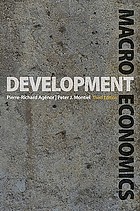 Development Macroeconomics
by
Since it was first published in 1995, Development Macroeconomics has remained the definitive textbook on the macroeconomics of developing countries. Now, in this fully revised and updated third edition, Pierre-Richard Agénor and Peter Montiel cover the latest advances in this rapidly changing field, making this the most up-to-date, authoritative, and comprehensive book available on the macroeconomic issues and challenges developing nations confront today. Agénor and Montiel provide completely new and expanded coverage of fiscal discipline, monetary policy regimes, currency and banking crises, monetary unions, management of capital flows, the choice of an exchange-rate regime, public capital and growth, the political economy of stabilization and adjustment--and much more. They review attempts that have been made to adapt standard macroeconomic analysis to conditions in developing economies, and they use a variety of analytical models to address the macroeconomic policy issues that most concern these countries. Agénor and Montiel systematically examine empirical evidence on behavioral assumptions and on the effects of macroeconomic policies in developing nations. They also provide extensive references to literature in the field. This new edition of Development Macroeconomics is the ideal introduction for students and an indispensable resource for researchers. Fully updated and expanded Provides the most comprehensive treatment of the macroeconomics of developing nations Features new material on fiscal discipline, monetary policy regimes, currency and banking crises--and much more Includes extensive references Serves both as a graduate textbook and a resource for researchers
Development Macroeconomics
by
Since it was first published in 1995, Development Macroeconomics has remained the definitive textbook on the macroeconomics of developing countries. Now, in this fully revised and updated third edition, Pierre-Richard Agénor and Peter Montiel cover the latest advances in this rapidly changing field, making this the most up-to-date, authoritative, and comprehensive book available on the macroeconomic issues and challenges developing nations confront today. Agénor and Montiel provide completely new and expanded coverage of fiscal discipline, monetary policy regimes, currency and banking crises, monetary unions, management of capital flows, the choice of an exchange-rate regime, public capital and growth, the political economy of stabilization and adjustment--and much more. They review attempts that have been made to adapt standard macroeconomic analysis to conditions in developing economies, and they use a variety of analytical models to address the macroeconomic policy issues that most concern these countries. Agénor and Montiel systematically examine empirical evidence on behavioral assumptions and on the effects of macroeconomic policies in developing nations. They also provide extensive references to literature in the field. This new edition of Development Macroeconomics is the ideal introduction for students and an indispensable resource for researchers. Fully updated and expanded Provides the most comprehensive treatment of the macroeconomics of developing nations Features new material on fiscal discipline, monetary policy regimes, currency and banking crises--and much more Includes extensive references Serves both as a graduate textbook and a resource for researchers
 The Lords of Poverty: the power, prestige, and corruption of the international aid business
by
The Lords of Poverty: the power, prestige, and corruption of the international aid business
by
 More from Less: the surprising story of how we learned to prosper using fewer resources--and what happens next
by
From the coauthor of the New York Times bestseller The Second Machine Age, a compelling argument--masterfully researched and brilliantly articulated--that we have at last learned how to increase human prosperity while treading more lightly on our planet. Throughout history, the only way for humanity to grow was by degrading the Earth: chopping down forests, fouling the air and water, and endlessly digging out resources. Since the first Earth Day in 1970, the reigning argument has been that taking better care of the planet means radically changing course: reducing our consumption, tightening our belts, learning to share and reuse, restraining growth. Is that argument correct? Absolutely not. In More from Less, McAfee argues that to solve our ecological problems we don't need to make radical changes. Instead, we need to do more of what we're already doing: growing technologically sophisticated market-based economies around the world. How can he possibly make this claim? Because of the evidence. America--a large, high-tech country that accounts for about 25% of the global economy--is now generally using less of most resources year after year, even as its economy and population continue to grow. What's more, the US is polluting the air and water less, emitting fewer greenhouse gases, and replenishing endangered animal populations. And, as McAfee shows, America is not alone. Other countries are also transforming themselves in fundamental ways. What has made this turnabout possible? One thing, primarily: the collaboration between technology and capitalism, although good governance and public awareness have also been critical. McAfee does warn of issues that haven't been solved, like global warming, overfishing, and communities left behind as capitalism and tech progress race forward. But overall, More from Less is a revelatory, paradigm-shifting account of how we've stumbled into an unexpectedly better balance with nature--one that holds out the promise of more abundant and greener centuries ahead.
More from Less: the surprising story of how we learned to prosper using fewer resources--and what happens next
by
From the coauthor of the New York Times bestseller The Second Machine Age, a compelling argument--masterfully researched and brilliantly articulated--that we have at last learned how to increase human prosperity while treading more lightly on our planet. Throughout history, the only way for humanity to grow was by degrading the Earth: chopping down forests, fouling the air and water, and endlessly digging out resources. Since the first Earth Day in 1970, the reigning argument has been that taking better care of the planet means radically changing course: reducing our consumption, tightening our belts, learning to share and reuse, restraining growth. Is that argument correct? Absolutely not. In More from Less, McAfee argues that to solve our ecological problems we don't need to make radical changes. Instead, we need to do more of what we're already doing: growing technologically sophisticated market-based economies around the world. How can he possibly make this claim? Because of the evidence. America--a large, high-tech country that accounts for about 25% of the global economy--is now generally using less of most resources year after year, even as its economy and population continue to grow. What's more, the US is polluting the air and water less, emitting fewer greenhouse gases, and replenishing endangered animal populations. And, as McAfee shows, America is not alone. Other countries are also transforming themselves in fundamental ways. What has made this turnabout possible? One thing, primarily: the collaboration between technology and capitalism, although good governance and public awareness have also been critical. McAfee does warn of issues that haven't been solved, like global warming, overfishing, and communities left behind as capitalism and tech progress race forward. But overall, More from Less is a revelatory, paradigm-shifting account of how we've stumbled into an unexpectedly better balance with nature--one that holds out the promise of more abundant and greener centuries ahead.
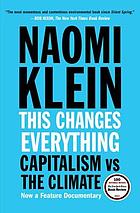 This Changes Everything: capitalism vs. the climate
by
The most important book yet from the author of the international bestseller The Shock Doctrine, a brilliant explanation of why the climate crisis challenges us to abandon the core "free market" ideology of our time, restructure the global economy, and remake our political systems. In short, either we embrace radical change ourselves or radical changes will be visited upon our physical world. The status quo is no longer an option. In This Changes Everything Naomi Klein argues that climate change isn't just another issue to be neatly filed between taxes and health care. It's an alarm that calls us to fix an economic system that is already failing us in many ways. Klein meticulously builds the case for how massively reducing our greenhouse emissions is our best chance to simultaneously reduce gaping inequalities, re-imagine our broken democracies, and rebuild our gutted local economies. She exposes the ideological desperation of the climate-change deniers, the messianic delusions of the would-be geoengineers, and the tragic defeatism of too many mainstream green initiatives. And she demonstrates precisely why the market has not-and cannot-fix the climate crisis but will instead make things worse, with ever more extreme and ecologically damaging extraction methods, accompanied by rampant disaster capitalism. Klein argues that the changes to our relationship with nature and one another that are required to respond to the climate crisis humanely should not be viewed as grim penance, but rather as a kind of gift-a catalyst to transform broken economic and cultural priorities and to heal long-festering historical wounds. And she documents the inspiring movements that have already begun this process: communities that are not just refusing to be sites of further fossil fuel extraction but are building the next, regeneration-based economies right now. Can we pull off these changes in time? Nothing is certain. Nothing except that climate change changes everything. And for a very brief time, the nature of that change is still up to us.
This Changes Everything: capitalism vs. the climate
by
The most important book yet from the author of the international bestseller The Shock Doctrine, a brilliant explanation of why the climate crisis challenges us to abandon the core "free market" ideology of our time, restructure the global economy, and remake our political systems. In short, either we embrace radical change ourselves or radical changes will be visited upon our physical world. The status quo is no longer an option. In This Changes Everything Naomi Klein argues that climate change isn't just another issue to be neatly filed between taxes and health care. It's an alarm that calls us to fix an economic system that is already failing us in many ways. Klein meticulously builds the case for how massively reducing our greenhouse emissions is our best chance to simultaneously reduce gaping inequalities, re-imagine our broken democracies, and rebuild our gutted local economies. She exposes the ideological desperation of the climate-change deniers, the messianic delusions of the would-be geoengineers, and the tragic defeatism of too many mainstream green initiatives. And she demonstrates precisely why the market has not-and cannot-fix the climate crisis but will instead make things worse, with ever more extreme and ecologically damaging extraction methods, accompanied by rampant disaster capitalism. Klein argues that the changes to our relationship with nature and one another that are required to respond to the climate crisis humanely should not be viewed as grim penance, but rather as a kind of gift-a catalyst to transform broken economic and cultural priorities and to heal long-festering historical wounds. And she documents the inspiring movements that have already begun this process: communities that are not just refusing to be sites of further fossil fuel extraction but are building the next, regeneration-based economies right now. Can we pull off these changes in time? Nothing is certain. Nothing except that climate change changes everything. And for a very brief time, the nature of that change is still up to us.
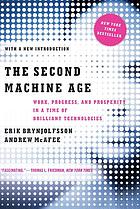 The Second Machine Age: work, progress, and prosperity in a time of brilliant technologies
by
In recent years, computers have learned to diagnose diseases, drive cars, write clean prose and win game shows. Advances like these have created unprecedented economic bounty but in their wake median income has stagnated and employment levels have fallen. Erik Brynjolfsson and Andrew McAfee reveal the technological forces driving this reinvention of the economy and chart a path towards future prosperity. Businesses and individuals, they argue, must learn to race with machines. Drawing on years of research, Brynjolfsson and McAfee identify the best strategies and policies for doing so. A fundamentally optimistic book, The Second Machine Age will radically alter how we think about issues of technological, societal and economic progress.
The Second Machine Age: work, progress, and prosperity in a time of brilliant technologies
by
In recent years, computers have learned to diagnose diseases, drive cars, write clean prose and win game shows. Advances like these have created unprecedented economic bounty but in their wake median income has stagnated and employment levels have fallen. Erik Brynjolfsson and Andrew McAfee reveal the technological forces driving this reinvention of the economy and chart a path towards future prosperity. Businesses and individuals, they argue, must learn to race with machines. Drawing on years of research, Brynjolfsson and McAfee identify the best strategies and policies for doing so. A fundamentally optimistic book, The Second Machine Age will radically alter how we think about issues of technological, societal and economic progress.
 Innovation Studies: evolution and future challenges
by
Innovation is increasingly recognized as a vitally important social and economic phenomenon worthy of serious research study. Firms are concerned about their innovation ability, particularly relative to their competitors. Politicians care about innovation, too, because of its presumed socialand economic impact. However, to recognize that innovation is desirable is not sufficient. What is required is systematic and reliable knowledge about how best to influence innovation and to exploit its effects to the full.Gaining such knowledge is the aim of the field of innovation studies, which is now at least half a century old. Hence, it is an opportune time to ask what has been achieved and what we still need to know more about. This is what this book sets out to explore. Written by a number of centralcontributors to the field, it critically examines the current state of the art and identifies issues that merit greater attention. The focus is mainly on how society can derive the greatest benefit from innovation and what needs to done to achieve this. However, to learn more about how society canbenefit more from innovation, one also needs to understand innovation processes in firms and how these interact with broader social, institutional and political factors. Such issues are therefore also central to the discussion here.
Innovation Studies: evolution and future challenges
by
Innovation is increasingly recognized as a vitally important social and economic phenomenon worthy of serious research study. Firms are concerned about their innovation ability, particularly relative to their competitors. Politicians care about innovation, too, because of its presumed socialand economic impact. However, to recognize that innovation is desirable is not sufficient. What is required is systematic and reliable knowledge about how best to influence innovation and to exploit its effects to the full.Gaining such knowledge is the aim of the field of innovation studies, which is now at least half a century old. Hence, it is an opportune time to ask what has been achieved and what we still need to know more about. This is what this book sets out to explore. Written by a number of centralcontributors to the field, it critically examines the current state of the art and identifies issues that merit greater attention. The focus is mainly on how society can derive the greatest benefit from innovation and what needs to done to achieve this. However, to learn more about how society canbenefit more from innovation, one also needs to understand innovation processes in firms and how these interact with broader social, institutional and political factors. Such issues are therefore also central to the discussion here.
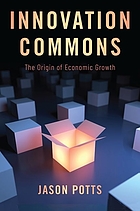 Innovation Commons : the origin of economic growth
by
Innovation is among the most important topics in understanding economic sustained economic growth. Jason Potts argues that the initial stages of innovation require cooperation under uncertainty and draws from insights on the solving of commons problems to shed light on policies and conditionsconducive to the creation of new firms and industries.The problems of innovation commons are overcome, Potts shows, when there are governance institutions that incentivize cooperation, thereby facilitating the pooling of distributed information, knowledge, and other inputs. The entrepreneurial discovery of an economic opportunity is thus an emergentinstitution resulting from the formation of a cooperative group, under conditions of extreme uncertainty, working toward the mutual purpose of opportunity discovery about a nascent technology or new idea. Among the problems commons address are those of the identity; cooperation; consent; monitoring;punishment; and independence. A commons is efficient compared to the creation of alternative economic institutions that involve extensive contracting and networks, private property rights and price signals, or public goods (i.e. firms, markets, and governments). In other words, the origin ofinnovation is not entrepreneurial action per se, but the creation of a common pool resource from which entrepreneurs can discover opportunities.Potts' framework draws on the evolutionary theory of cooperation and institutional theory of the commons. It also has important implications for understanding the origin of firms and industries, and for the design of innovation policy. Beginning with a discussion of problems of knowledge andcoordination as well as their implications for common pool environments, the book then explores instances of innovation commons and the lifecycle of innovation, including increased institutionalization and rigidness. Potts also discusses the possible implications of the commons framework forpolicies to sustain innovation dynamics.
Innovation Commons : the origin of economic growth
by
Innovation is among the most important topics in understanding economic sustained economic growth. Jason Potts argues that the initial stages of innovation require cooperation under uncertainty and draws from insights on the solving of commons problems to shed light on policies and conditionsconducive to the creation of new firms and industries.The problems of innovation commons are overcome, Potts shows, when there are governance institutions that incentivize cooperation, thereby facilitating the pooling of distributed information, knowledge, and other inputs. The entrepreneurial discovery of an economic opportunity is thus an emergentinstitution resulting from the formation of a cooperative group, under conditions of extreme uncertainty, working toward the mutual purpose of opportunity discovery about a nascent technology or new idea. Among the problems commons address are those of the identity; cooperation; consent; monitoring;punishment; and independence. A commons is efficient compared to the creation of alternative economic institutions that involve extensive contracting and networks, private property rights and price signals, or public goods (i.e. firms, markets, and governments). In other words, the origin ofinnovation is not entrepreneurial action per se, but the creation of a common pool resource from which entrepreneurs can discover opportunities.Potts' framework draws on the evolutionary theory of cooperation and institutional theory of the commons. It also has important implications for understanding the origin of firms and industries, and for the design of innovation policy. Beginning with a discussion of problems of knowledge andcoordination as well as their implications for common pool environments, the book then explores instances of innovation commons and the lifecycle of innovation, including increased institutionalization and rigidness. Potts also discusses the possible implications of the commons framework forpolicies to sustain innovation dynamics.
 The Economics of Innovation: an introduction
by
This major textbook provides a comprehensive yet accessible introduction to the economics of innovation, written for students with some basic knowledge of economics. G.M. Peter Swann contends that innovation is one of the most important economic and business phenomena of our time and a topic of great practical and policy interest, with widespread implications for our economy and society. This book engages with the reader to explore some of the key economic issues concerning innovation. Bridging a gap in the literature, this timely textbook addresses critical questions such as: How should different aspects of innovation be described and classified? What are the incentives to innovate? How should firms organize themselves to promote innovation? What are the effects of innovation on the economy? Do governments have a role in supporting and guiding innovation?Introducing the student to a broad range of issues surrounding the economics of innovation, this text will prove invaluable to students on a variety of courses including economics, business and management, innovation, and science and technology studies.
The Economics of Innovation: an introduction
by
This major textbook provides a comprehensive yet accessible introduction to the economics of innovation, written for students with some basic knowledge of economics. G.M. Peter Swann contends that innovation is one of the most important economic and business phenomena of our time and a topic of great practical and policy interest, with widespread implications for our economy and society. This book engages with the reader to explore some of the key economic issues concerning innovation. Bridging a gap in the literature, this timely textbook addresses critical questions such as: How should different aspects of innovation be described and classified? What are the incentives to innovate? How should firms organize themselves to promote innovation? What are the effects of innovation on the economy? Do governments have a role in supporting and guiding innovation?Introducing the student to a broad range of issues surrounding the economics of innovation, this text will prove invaluable to students on a variety of courses including economics, business and management, innovation, and science and technology studies.
 The Race for What's Left: the global scramble for the world's last resources
by
From Michael Klare, the renowned expert on natural resource issues, an invaluable account of a new and dangerous global competition The world is facing an unprecedented crisis of resource depletion--a crisis that goes beyond "peak oil" to encompass shortages of coal and uranium, copper and lithium, water and arable land. With all of the planet's easily accessible resource deposits rapidly approaching exhaustion, the desperate hunt for supplies has become a frenzy of extreme exploration, as governments and corporations rush to stake their claim in areas previously considered too dangerous and remote.The Race for What's Left takes us from the Arctic to war zones to deep ocean floors, from a Russian submarine planting the country's flag on the North Pole seabed to the large-scale buying up of African farmland by Saudi Arabia, China, and other food-importing nations. As Klare explains, this invasion of the final frontiers carries grave consequences. With resource extraction growing more complex, the environmental risks are becoming increasingly severe; theDeepwater Horizon disaster is only a preview of the dangers to come. At the same time, the intense search for dwindling supplies is igniting new border disputes, raising the likelihood of military confrontation. Inevitably, if the scouring of the globe continues on its present path, many key resources that modern industry relies upon will disappear completely. The only way out, Klare argues, is to alter our consumption patterns altogether--a crucial task that will be the greatest challenge of the coming century.
The Race for What's Left: the global scramble for the world's last resources
by
From Michael Klare, the renowned expert on natural resource issues, an invaluable account of a new and dangerous global competition The world is facing an unprecedented crisis of resource depletion--a crisis that goes beyond "peak oil" to encompass shortages of coal and uranium, copper and lithium, water and arable land. With all of the planet's easily accessible resource deposits rapidly approaching exhaustion, the desperate hunt for supplies has become a frenzy of extreme exploration, as governments and corporations rush to stake their claim in areas previously considered too dangerous and remote.The Race for What's Left takes us from the Arctic to war zones to deep ocean floors, from a Russian submarine planting the country's flag on the North Pole seabed to the large-scale buying up of African farmland by Saudi Arabia, China, and other food-importing nations. As Klare explains, this invasion of the final frontiers carries grave consequences. With resource extraction growing more complex, the environmental risks are becoming increasingly severe; theDeepwater Horizon disaster is only a preview of the dangers to come. At the same time, the intense search for dwindling supplies is igniting new border disputes, raising the likelihood of military confrontation. Inevitably, if the scouring of the globe continues on its present path, many key resources that modern industry relies upon will disappear completely. The only way out, Klare argues, is to alter our consumption patterns altogether--a crucial task that will be the greatest challenge of the coming century.
 Sustainable development in the United States : an experimental set of indicators : a progress report
by
Sustainable development in the United States : an experimental set of indicators : a progress report
by
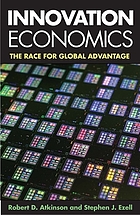 Innovation Economics: the race for global advantage
by
This important book delivers a critical wake-up call: a fierce global race for innovation advantage is under way, and while other nations are making support for technology and innovation a central tenet of their economic strategies and policies, America lacks a robust innovation policy. What does this portend? Robert Atkinson and Stephen Ezell, widely respected economic thinkers, report on profound new forces that are shaping the global economy—forces that favor nations with innovation-based economies and innovation policies. Unless the United States enacts public policies to reflect this reality, Americans face the relatively lower standards of living associated with a noncompetitive national economy. The authors explore how a weak innovation economy not only contributed to the Great Recession but is delaying America's recovery from it and how innovation in the United States compares with that in other developed and developing nations. Atkinson and Ezell then lay out a detailed, pragmatic road map for America to regain its global innovation advantage by 2020, as well as maximize the global supply of innovation and promote sustainable globalization.
Innovation Economics: the race for global advantage
by
This important book delivers a critical wake-up call: a fierce global race for innovation advantage is under way, and while other nations are making support for technology and innovation a central tenet of their economic strategies and policies, America lacks a robust innovation policy. What does this portend? Robert Atkinson and Stephen Ezell, widely respected economic thinkers, report on profound new forces that are shaping the global economy—forces that favor nations with innovation-based economies and innovation policies. Unless the United States enacts public policies to reflect this reality, Americans face the relatively lower standards of living associated with a noncompetitive national economy. The authors explore how a weak innovation economy not only contributed to the Great Recession but is delaying America's recovery from it and how innovation in the United States compares with that in other developed and developing nations. Atkinson and Ezell then lay out a detailed, pragmatic road map for America to regain its global innovation advantage by 2020, as well as maximize the global supply of innovation and promote sustainable globalization.
 Before the Industrial Revolution: European society and economy, 1000-1700
by
Before the Industrial Revolution: European society and economy, 1000-1700
by
 A Marxist Model of Social Change: Soviet Central Asia, 1917-1940
by
A Marxist Model of Social Change: Soviet Central Asia, 1917-1940
by
 Economic History of the Middle East, 1800-1914 : a book of readings
by
Economic History of the Middle East, 1800-1914 : a book of readings
by
 The Central Asian Economies since Independence
by
The 9/11 attacks, the U.S. invasion of Afghanistan, and the oil boom of recent years have greatly increased the strategic importance of resource-rich Central Asia, making an understanding of its economic--and therefore political--prospects more important than ever. In The Central Asian Economies Since Independence, Richard Pomfret provides a concise and up-to-date analysis of the huge changes undergone by the economies of Kazakhstan, the Kyrgyz Republic, Tajikistan, Turkmenistan, and Uzbekistan since the collapse of the Soviet Union in 1991. The book assesses the economic prospects of each country, and the likelihood that economic conditions will spur major political changes. With independent chapters on each country, and chapters analyzing their comparative economic performance, the book highlights similarities and differences. Facing common problems caused by the breakdown of Soviet economic relations and the hyperinflation of the early 1990s, these countries have taken widely divergent paths in the transition from Soviet central planning to more market-based economies. The book ends in 2005 with the bloodless Kyrgyz revolution and the violence in Uzbekistan, which signaled the end of the region's political continuity. Throughout the book, Pomfret emphasizes the economic forces that foster political instability--from Kazakhstan's resource boom and Turkmenistan's lack of reform to Tajikistan's abject poverty.
The Central Asian Economies since Independence
by
The 9/11 attacks, the U.S. invasion of Afghanistan, and the oil boom of recent years have greatly increased the strategic importance of resource-rich Central Asia, making an understanding of its economic--and therefore political--prospects more important than ever. In The Central Asian Economies Since Independence, Richard Pomfret provides a concise and up-to-date analysis of the huge changes undergone by the economies of Kazakhstan, the Kyrgyz Republic, Tajikistan, Turkmenistan, and Uzbekistan since the collapse of the Soviet Union in 1991. The book assesses the economic prospects of each country, and the likelihood that economic conditions will spur major political changes. With independent chapters on each country, and chapters analyzing their comparative economic performance, the book highlights similarities and differences. Facing common problems caused by the breakdown of Soviet economic relations and the hyperinflation of the early 1990s, these countries have taken widely divergent paths in the transition from Soviet central planning to more market-based economies. The book ends in 2005 with the bloodless Kyrgyz revolution and the violence in Uzbekistan, which signaled the end of the region's political continuity. Throughout the book, Pomfret emphasizes the economic forces that foster political instability--from Kazakhstan's resource boom and Turkmenistan's lack of reform to Tajikistan's abject poverty.
 Проблемы экономического роста и развития производительных сил в КНР
by
Проблемы экономического роста и развития производительных сил в КНР
by
 Growth, poverty alleviation, and sustainable resource management in the mountain areas of South Asia : proceedings of the international conference held from 31 January-4 February, 2000 in Kathmandu, Nepal
by
Growth, poverty alleviation, and sustainable resource management in the mountain areas of South Asia : proceedings of the international conference held from 31 January-4 February, 2000 in Kathmandu, Nepal
by
 Poverty alleviation in mountain areas of China : proceedings of the international conference held from 11-15 November 2002 in Chengdu, China
by
Poverty alleviation in mountain areas of China : proceedings of the international conference held from 11-15 November 2002 in Chengdu, China
by
 Transformation of social and economic relationships in Northern Pakistan
by
Transformation of social and economic relationships in Northern Pakistan
by
 Иностранный капитал в дореволюционном Казахстане
by
Иностранный капитал в дореволюционном Казахстане
by
 Beyond the Urals : economic developments in Soviet Asia
by
Beyond the Urals : economic developments in Soviet Asia
by
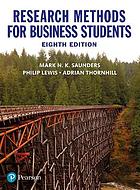 Research methods for business students
by
Research methods for business students
by
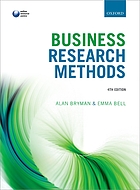 Business Research Methods
by
A complete introduction to doing business research, Business Research Methods is the ideal guide for students embarking on a research project. Together with real students and supervisors, the authors draw on their own extensive experience to give readers tips for success and provide advice tohelp them avoid common mistakes.Developed specifically with business and management students in mind, this bestselling textbook explores the nature and purpose of business research and the issues it entails, while also providing students with practical advice on carrying out their research. In addition to a broad range of relevantcase studies, the book features a substantial discussion of ethics, a chapter on internet research methods, and a strong emphasis on practical content such as planning a project and writing it up.With a new chapter on the nature of business research that explains why an understanding of research methods is so important to the broader study of business and management, and a new chapter on sampling in qualitative research, Business Research Methods remains the book of choice to help you builda full understanding of the subject.Online Resource CentreFor students:* An interactive research guide, providing guidance and advice on every aspect of business research* Video interviews with research students* Questions for review* Datasets from the text* Self-marking multiple-choice questions for revision* Annotated web links to useful articles, reviews, models and research guides* A guide to using Excel in data analysisFor lecturers:* A lecturer's guide including lecture outlines, reading lists and teaching activities* A suite of customisable PowerPoint slides* Figures and tables from the text
Business Research Methods
by
A complete introduction to doing business research, Business Research Methods is the ideal guide for students embarking on a research project. Together with real students and supervisors, the authors draw on their own extensive experience to give readers tips for success and provide advice tohelp them avoid common mistakes.Developed specifically with business and management students in mind, this bestselling textbook explores the nature and purpose of business research and the issues it entails, while also providing students with practical advice on carrying out their research. In addition to a broad range of relevantcase studies, the book features a substantial discussion of ethics, a chapter on internet research methods, and a strong emphasis on practical content such as planning a project and writing it up.With a new chapter on the nature of business research that explains why an understanding of research methods is so important to the broader study of business and management, and a new chapter on sampling in qualitative research, Business Research Methods remains the book of choice to help you builda full understanding of the subject.Online Resource CentreFor students:* An interactive research guide, providing guidance and advice on every aspect of business research* Video interviews with research students* Questions for review* Datasets from the text* Self-marking multiple-choice questions for revision* Annotated web links to useful articles, reviews, models and research guides* A guide to using Excel in data analysisFor lecturers:* A lecturer's guide including lecture outlines, reading lists and teaching activities* A suite of customisable PowerPoint slides* Figures and tables from the text
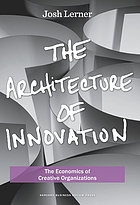 The Architecture of Innovation: the economics of creative organizations
by
Find the right innovation model Innovation is a much-used buzzword these days, but when it comes to creating and implementing a new idea, many companies miss the mark--plans backfire, consumer preferences shift, or tried-and-true practices fail to work in a new context. So is innovation just a low-odds crapshoot? In The Architecture of Innovation, Harvard Business School professor Josh Lerner--one of the foremost experts on how innovation works--says innovation can be understood and managed. The key to success? Incentives. Fortunately, new research has shed light on the role incentives can play in promoting new ideas, but these findings have been absent from innovation literature--until now. By using the principles of organizational economics, Lerner explains how companies can set the right incentives and time horizons for investments and create a robust innovation infrastructure in the process. Drawing from years of experience studying and advising companies, venture capital firms, and an assortment of governments around the globe, Lerner looks to corporate labs and start-ups, and argues that the best elements of both can be found in hybrid models for innovation. While doing so, he uses a wide range of industry-rich examples to show how these models work and how you can put them into practice in your own organization. Practical and thought-provoking, The Architecture of Innovation is the missing blueprint for any company looking to strengthen its innovation competence.
The Architecture of Innovation: the economics of creative organizations
by
Find the right innovation model Innovation is a much-used buzzword these days, but when it comes to creating and implementing a new idea, many companies miss the mark--plans backfire, consumer preferences shift, or tried-and-true practices fail to work in a new context. So is innovation just a low-odds crapshoot? In The Architecture of Innovation, Harvard Business School professor Josh Lerner--one of the foremost experts on how innovation works--says innovation can be understood and managed. The key to success? Incentives. Fortunately, new research has shed light on the role incentives can play in promoting new ideas, but these findings have been absent from innovation literature--until now. By using the principles of organizational economics, Lerner explains how companies can set the right incentives and time horizons for investments and create a robust innovation infrastructure in the process. Drawing from years of experience studying and advising companies, venture capital firms, and an assortment of governments around the globe, Lerner looks to corporate labs and start-ups, and argues that the best elements of both can be found in hybrid models for innovation. While doing so, he uses a wide range of industry-rich examples to show how these models work and how you can put them into practice in your own organization. Practical and thought-provoking, The Architecture of Innovation is the missing blueprint for any company looking to strengthen its innovation competence.
 The Big Book of Business Games: Icebreakers, Creativity Exercises and Meeting Energizers
by
Break the ice at your next meeting with The Big Book of Business Games! In this exciting resource book, two of today's acknowledged games masters serve up a cookbook of activities that you can learn to use, guaranteed to generate a lively discussion, or simply give a group a "breather" from the monotony of a boring staff meeting or presentation. Each of the 75 group games and activities here is adapted from the best-selling Games Trainers Play series and shortened to suit the needs of managers and team leaders to use with their departments, staff, or committees.
The Big Book of Business Games: Icebreakers, Creativity Exercises and Meeting Energizers
by
Break the ice at your next meeting with The Big Book of Business Games! In this exciting resource book, two of today's acknowledged games masters serve up a cookbook of activities that you can learn to use, guaranteed to generate a lively discussion, or simply give a group a "breather" from the monotony of a boring staff meeting or presentation. Each of the 75 group games and activities here is adapted from the best-selling Games Trainers Play series and shortened to suit the needs of managers and team leaders to use with their departments, staff, or committees.
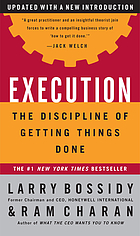 Execution
by
The book that shows how to get the job done and deliver results . . . whether you're running an entire company or in your first management job Larry Bossidy is one of the world's most acclaimed CEOs, a man with few peers who has a track record for delivering results. Ram Charan is a legendary advisor to senior executives and boards of directors, a man with unparalleled insight into why some companies are successful and others are not. Together they've pooled their knowledge and experience into the one book on how to close the gap between results promised and results delivered that people in business need today. After a long, stellar career with General Electric, Larry Bossidy transformed AlliedSignal into one of the world's most admired companies and was named CEO of the year in 1998 by Chief Executive magazine. Accomplishments such as 31 consecutive quarters of earnings-per-share growth of 13 percent or more didn't just happen; they resulted from the consistent practice of the discipline of execution: understanding how to link together people, strategy, and operations, the three core processes of every business. Leading these processes is the real job of running a business, not formulating a "vision" and leaving the work of carrying it out to others. Bossidy and Charan show the importance of being deeply and passionately engaged in an organization and why robust dialogues about people, strategy, and operations result in a business based on intellectual honesty and realism. The leader's most important job--selecting and appraising people--is one that should never be delegated. As a CEO, Larry Bossidy personally makes the calls to check references for key hires. Why? With the right people in the right jobs, there's a leadership gene pool that conceives and selects strategies that can be executed. People then work together to create a strategy building block by building block, a strategy in sync with the realities of the marketplace, the economy, and the competition. Once the right people and strategy are in place, they are then linked to an operating process that results in the implementation of specific programs and actions and that assigns accountability. This kind of effective operating process goes way beyond the typical budget exercise that looks into a rearview mirror to set its goals. It puts reality behind the numbers and is where the rubber meets the road. Putting an execution culture in place is hard, but losing it is easy. In July 2001 Larry Bossidy was asked by the board of directors of Honeywell International (it had merged with AlliedSignal) to return and get the company back on track. He's been putting the ideas he writes about in Execution to work in real time.
Execution
by
The book that shows how to get the job done and deliver results . . . whether you're running an entire company or in your first management job Larry Bossidy is one of the world's most acclaimed CEOs, a man with few peers who has a track record for delivering results. Ram Charan is a legendary advisor to senior executives and boards of directors, a man with unparalleled insight into why some companies are successful and others are not. Together they've pooled their knowledge and experience into the one book on how to close the gap between results promised and results delivered that people in business need today. After a long, stellar career with General Electric, Larry Bossidy transformed AlliedSignal into one of the world's most admired companies and was named CEO of the year in 1998 by Chief Executive magazine. Accomplishments such as 31 consecutive quarters of earnings-per-share growth of 13 percent or more didn't just happen; they resulted from the consistent practice of the discipline of execution: understanding how to link together people, strategy, and operations, the three core processes of every business. Leading these processes is the real job of running a business, not formulating a "vision" and leaving the work of carrying it out to others. Bossidy and Charan show the importance of being deeply and passionately engaged in an organization and why robust dialogues about people, strategy, and operations result in a business based on intellectual honesty and realism. The leader's most important job--selecting and appraising people--is one that should never be delegated. As a CEO, Larry Bossidy personally makes the calls to check references for key hires. Why? With the right people in the right jobs, there's a leadership gene pool that conceives and selects strategies that can be executed. People then work together to create a strategy building block by building block, a strategy in sync with the realities of the marketplace, the economy, and the competition. Once the right people and strategy are in place, they are then linked to an operating process that results in the implementation of specific programs and actions and that assigns accountability. This kind of effective operating process goes way beyond the typical budget exercise that looks into a rearview mirror to set its goals. It puts reality behind the numbers and is where the rubber meets the road. Putting an execution culture in place is hard, but losing it is easy. In July 2001 Larry Bossidy was asked by the board of directors of Honeywell International (it had merged with AlliedSignal) to return and get the company back on track. He's been putting the ideas he writes about in Execution to work in real time.
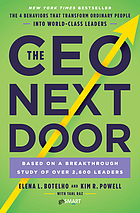 The CEO next door : the 4 behaviours that transform ordinary people into world-class leaders
by
The CEO next door : the 4 behaviours that transform ordinary people into world-class leaders
by
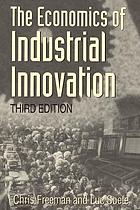 The Economics of Industrial Innovation
by
Technical innovation has moved to center stage in contemporary debates on economic theory and policy, and Chris Freeman and Luc Soete have played a prominent part in these debates. For this new edition of The Economics of Industrial Innovation, they have rewritten all the existing chapters and added ten new ones that address recent advances in theory and in policymaking. In the new chapters they deal with the international dimensions of technical change including underdevelopment, technology transfer, international trade, and globalization. They have also strengthened the historical account of the rise of new technologies, a main feature of earlier editions. They take advantage of their experience on projects for the OECD, the European Union, and industry in other new chapters on "The Information Society" and on environmental issues, as well as in the updated discussion of science and technology policy.
The Economics of Industrial Innovation
by
Technical innovation has moved to center stage in contemporary debates on economic theory and policy, and Chris Freeman and Luc Soete have played a prominent part in these debates. For this new edition of The Economics of Industrial Innovation, they have rewritten all the existing chapters and added ten new ones that address recent advances in theory and in policymaking. In the new chapters they deal with the international dimensions of technical change including underdevelopment, technology transfer, international trade, and globalization. They have also strengthened the historical account of the rise of new technologies, a main feature of earlier editions. They take advantage of their experience on projects for the OECD, the European Union, and industry in other new chapters on "The Information Society" and on environmental issues, as well as in the updated discussion of science and technology policy.
 Exploring innovation
by
Exploring innovation
by
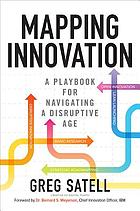 Mapping Innovation: a Playbook for Navigating a Disruptive Age
by
Map the innovation space--and blaze a path to profits and growth Countless books, articles, and other advice promise leaders solutions to the complex challenges they face. Some offer quick, silver-bullet remedies--a straight line to success!--and some are so technical that readers get lost before they begin. Now, there's Mapping Innovation, a refreshing alternative in the crowded business innovation space. Engaging and informative without sacrificing substance and expertise, this groundbreaking guide provides thorough background on some of the greatest innovations of the past century as well as . It details the processes that advanced them from inception to world-changing products--and shows you how to replicate their success. Business innovation expert Greg Satell helps you find your way by revealing the four models of innovation: Basic Research, Breakthrough Innovation, Sustaining Innovation, and Disruptive Innovation. One size does not fit all, so he provides a framework--the Innovation Matrix--for discovering which "type" of innovation process best suits the problem you need to solve. It's about asking the right questions, so that you can apply the right strategies to the problems you need to solve. In the end, you'll have a crystal clear model for disrupting the marketplace, scaling your efforts to propel your enterprise forward, and leverage digital platforms to your advantage. Mapping Innovation offers a simple and accessible but powerful approach to developing a strategy that will put you light years ahead of the competition!.
Mapping Innovation: a Playbook for Navigating a Disruptive Age
by
Map the innovation space--and blaze a path to profits and growth Countless books, articles, and other advice promise leaders solutions to the complex challenges they face. Some offer quick, silver-bullet remedies--a straight line to success!--and some are so technical that readers get lost before they begin. Now, there's Mapping Innovation, a refreshing alternative in the crowded business innovation space. Engaging and informative without sacrificing substance and expertise, this groundbreaking guide provides thorough background on some of the greatest innovations of the past century as well as . It details the processes that advanced them from inception to world-changing products--and shows you how to replicate their success. Business innovation expert Greg Satell helps you find your way by revealing the four models of innovation: Basic Research, Breakthrough Innovation, Sustaining Innovation, and Disruptive Innovation. One size does not fit all, so he provides a framework--the Innovation Matrix--for discovering which "type" of innovation process best suits the problem you need to solve. It's about asking the right questions, so that you can apply the right strategies to the problems you need to solve. In the end, you'll have a crystal clear model for disrupting the marketplace, scaling your efforts to propel your enterprise forward, and leverage digital platforms to your advantage. Mapping Innovation offers a simple and accessible but powerful approach to developing a strategy that will put you light years ahead of the competition!.
 Good to Great: why some companies make the leap ... and others don't
by
The Challenge Built to Last, the defining management study of the nineties, showed how great companies triumph over time and how long-term sustained performance can be engineered into the DNA of an enterprise from the very beginning. But what about the company that is not born with great DNA? How can good companies, mediocre companies, even bad companies achieve enduring greatness? The Study For years, this question preyed on the mind of Jim Collins. Are there companies that defy gravity and convert long-term mediocrity or worse into long-term superiority? And if so, what are the universal distinguishing characteristics that cause a company to go from good to great? The Standards Using tough benchmarks, Collins and his research team identified a set of elite companies that made the leap to great results and sustained those results for at least fifteen years. How great? After the leap, the good-to-great companies generated cumulative stock returns that beat the general stock market by an average of seven times in fifteen years, better than twice the results delivered by a composite index of the world's greatest companies, including Coca-Cola, Intel, General Electric, and Merck. The Comparisons The research team contrasted the good-to-great companies with a carefully selected set of comparison companies that failed to make the leap from good to great. What was different? Why did one set of companies become truly great performers while the other set remained only good? Over five years, the team analyzed the histories of all twenty-eight companies in the study. After sifting through mountains of data and thousands of pages of interviews, Collins and his crew discovered the key determinants of greatness -- why some companies make the leap and others don't. The Findings The findings of the Good to Great study will surprise many readers and shed light on virtually every area of management strategy and practice. The findings include: Level 5 Leaders: The research team was shocked to discover the type of leadership required to achieve greatness. The Hedgehog Concept (Simplicity within the Three Circles): To go from good to great requires transcending the curse of competence. A Culture of Discipline: When you combine a culture of discipline with an ethic of entrepreneurship, you get the magical alchemy of great results. Technology Accelerators: Good-to-great companies think differently about the role of technology. The Flywheel and the Doom Loop: Those who launch radical change programs and wrenching restructurings will almost certainly fail to make the leap. "Some of the key concepts discerned in the study," comments Jim Collins, "fly in the face of our modern business culture and will, quite frankly, upset some people." Perhaps, but who can afford to ignore these findings?
Good to Great: why some companies make the leap ... and others don't
by
The Challenge Built to Last, the defining management study of the nineties, showed how great companies triumph over time and how long-term sustained performance can be engineered into the DNA of an enterprise from the very beginning. But what about the company that is not born with great DNA? How can good companies, mediocre companies, even bad companies achieve enduring greatness? The Study For years, this question preyed on the mind of Jim Collins. Are there companies that defy gravity and convert long-term mediocrity or worse into long-term superiority? And if so, what are the universal distinguishing characteristics that cause a company to go from good to great? The Standards Using tough benchmarks, Collins and his research team identified a set of elite companies that made the leap to great results and sustained those results for at least fifteen years. How great? After the leap, the good-to-great companies generated cumulative stock returns that beat the general stock market by an average of seven times in fifteen years, better than twice the results delivered by a composite index of the world's greatest companies, including Coca-Cola, Intel, General Electric, and Merck. The Comparisons The research team contrasted the good-to-great companies with a carefully selected set of comparison companies that failed to make the leap from good to great. What was different? Why did one set of companies become truly great performers while the other set remained only good? Over five years, the team analyzed the histories of all twenty-eight companies in the study. After sifting through mountains of data and thousands of pages of interviews, Collins and his crew discovered the key determinants of greatness -- why some companies make the leap and others don't. The Findings The findings of the Good to Great study will surprise many readers and shed light on virtually every area of management strategy and practice. The findings include: Level 5 Leaders: The research team was shocked to discover the type of leadership required to achieve greatness. The Hedgehog Concept (Simplicity within the Three Circles): To go from good to great requires transcending the curse of competence. A Culture of Discipline: When you combine a culture of discipline with an ethic of entrepreneurship, you get the magical alchemy of great results. Technology Accelerators: Good-to-great companies think differently about the role of technology. The Flywheel and the Doom Loop: Those who launch radical change programs and wrenching restructurings will almost certainly fail to make the leap. "Some of the key concepts discerned in the study," comments Jim Collins, "fly in the face of our modern business culture and will, quite frankly, upset some people." Perhaps, but who can afford to ignore these findings?
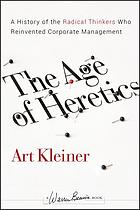 The Age of Heretics: a history of the radical thinkers who reinvented corporate management
by
In this second edition of his bestselling book, author Art Kleiner explores the nature of effective leadership in times of change and defines its importance to the corporation of the future. He describes a heretic as a visionary who creates change in large-scale companies, balancing the contrary truths they can't deny against their loyalty to their organizations. The Age of Heretics reveals how managers can get stuck in counterproductive ways of doing things and shows why it takes a heretical point of view to get past the deadlock and move forward.
The Age of Heretics: a history of the radical thinkers who reinvented corporate management
by
In this second edition of his bestselling book, author Art Kleiner explores the nature of effective leadership in times of change and defines its importance to the corporation of the future. He describes a heretic as a visionary who creates change in large-scale companies, balancing the contrary truths they can't deny against their loyalty to their organizations. The Age of Heretics reveals how managers can get stuck in counterproductive ways of doing things and shows why it takes a heretical point of view to get past the deadlock and move forward.
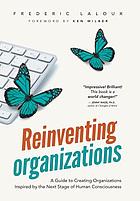 Reinventing Organizations: a guide to creating organizations inspired by the next stage of human consciousness
by
The way we manage organizations seems increasingly out of date. Survey after survey shows that a majority of employees feel disengaged from their companies. The epidemic of organizational disillusionment goes way beyond Corporate America-teachers, doctors, and nurses are leaving their professions in record numbers because the way we run schools and hospitals kills their vocation. Government agencies and nonprofits have a noble purpose, but working for these entities often feels soulless and lifeless just the same. All these organizations suffer from power games played at the top and powerlessness at lower levels, from infighting and bureaucracy, from endless meetings and a seemingly never-ending succession of change and cost-cutting programs. Deep inside, we long for soulful workplaces, for authenticity, community, passion, and purpose. The solution, according to many progressive scholars, lies with more enlightened management. But reality shows that this is not enough. In most cases, the system beats the individual-when managers or leaders go through an inner transformation, they end up leaving their organizations because they no longer feel like putting up with a place that is inhospitable to the deeper longings of their soul. We need more enlightened leaders, but we need something more: enlightened organizational structures and practices. But is there even such a thing? Can we conceive of enlightened organizations? In this groundbreaking book, the author shows that every time humanity has shifted to a new stage of consciousness in the past, it has invented a whole new way to structure and run organizations, each time bringing extraordinary breakthroughs in collaboration. A new shift in consciousness is currently underway. Could it help us invent a radically more soulful and purposeful way to run our businesses and nonprofits, schools and hospitals? The pioneering organizations researched for this book have already "cracked the code." Their founders have fundamentally questioned every aspect of management and have come up with entirely new organizational methods. Even though they operate in very different industries and geographies and did not know of each other's experiments, the structures and practices they have developed are remarkably similar. It's hard not to get excited about this finding: a new organizational model seems to be emerging, and it promises a soulful revolution in the workplace. Reinventing Organizations describes in practical detail how organizations large and small can operate in this new paradigm. Leaders, founders, coaches, and consultants will find this work a joyful handbook, full of insights, examples, and inspiring stories.
Reinventing Organizations: a guide to creating organizations inspired by the next stage of human consciousness
by
The way we manage organizations seems increasingly out of date. Survey after survey shows that a majority of employees feel disengaged from their companies. The epidemic of organizational disillusionment goes way beyond Corporate America-teachers, doctors, and nurses are leaving their professions in record numbers because the way we run schools and hospitals kills their vocation. Government agencies and nonprofits have a noble purpose, but working for these entities often feels soulless and lifeless just the same. All these organizations suffer from power games played at the top and powerlessness at lower levels, from infighting and bureaucracy, from endless meetings and a seemingly never-ending succession of change and cost-cutting programs. Deep inside, we long for soulful workplaces, for authenticity, community, passion, and purpose. The solution, according to many progressive scholars, lies with more enlightened management. But reality shows that this is not enough. In most cases, the system beats the individual-when managers or leaders go through an inner transformation, they end up leaving their organizations because they no longer feel like putting up with a place that is inhospitable to the deeper longings of their soul. We need more enlightened leaders, but we need something more: enlightened organizational structures and practices. But is there even such a thing? Can we conceive of enlightened organizations? In this groundbreaking book, the author shows that every time humanity has shifted to a new stage of consciousness in the past, it has invented a whole new way to structure and run organizations, each time bringing extraordinary breakthroughs in collaboration. A new shift in consciousness is currently underway. Could it help us invent a radically more soulful and purposeful way to run our businesses and nonprofits, schools and hospitals? The pioneering organizations researched for this book have already "cracked the code." Their founders have fundamentally questioned every aspect of management and have come up with entirely new organizational methods. Even though they operate in very different industries and geographies and did not know of each other's experiments, the structures and practices they have developed are remarkably similar. It's hard not to get excited about this finding: a new organizational model seems to be emerging, and it promises a soulful revolution in the workplace. Reinventing Organizations describes in practical detail how organizations large and small can operate in this new paradigm. Leaders, founders, coaches, and consultants will find this work a joyful handbook, full of insights, examples, and inspiring stories.
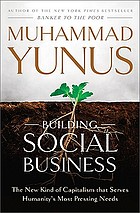 Building Social Business: the new kind of capitalism that serves humanity's most pressing needs
by
Muhammad Yunus, the practical visionary who pioneered microcredit and, with his Grameen Bank, won the 2006 Nobel Peace Prize, has developed a visionary new dimension for capitalism which he calls "social business." By harnessing the energy of profit-making to the objective of fulfilling human needs, social business creates self-supporting, viable commercial enterprises that generate economic growth even as they produce goods and services that make the world a better place. In this book, Yunus shows how social business has gone from being a theory to an inspiring practice, adopted by leading corporations, entrepreneurs, and social activists across Asia, South America, Europe and the US. He demonstrates how social business transforms lives; offers practical guidance for those who want to create social businesses of their own; explains how public and corporate policies must adapt to make room for the social business model; and shows why social business holds the potential to redeem the failed promise of free-market enterprise.
Building Social Business: the new kind of capitalism that serves humanity's most pressing needs
by
Muhammad Yunus, the practical visionary who pioneered microcredit and, with his Grameen Bank, won the 2006 Nobel Peace Prize, has developed a visionary new dimension for capitalism which he calls "social business." By harnessing the energy of profit-making to the objective of fulfilling human needs, social business creates self-supporting, viable commercial enterprises that generate economic growth even as they produce goods and services that make the world a better place. In this book, Yunus shows how social business has gone from being a theory to an inspiring practice, adopted by leading corporations, entrepreneurs, and social activists across Asia, South America, Europe and the US. He demonstrates how social business transforms lives; offers practical guidance for those who want to create social businesses of their own; explains how public and corporate policies must adapt to make room for the social business model; and shows why social business holds the potential to redeem the failed promise of free-market enterprise.
 Entrepreneurship : a small business approach
by
"Entrepreneurship: A Small Business Approach" takes a hands-on, problem-based learning approach that works through real problems faced by entrepreneurs and small business owners. Using real-world scenarios and exercises throughout, it puts the student in the roles of financial analyst, marketer, and business owner to find solutions. By drawing on the most current environmental conditions and solid research, "Entrepreneurship" provides students with the necessary foundation to design, start, and manage a small business.
Entrepreneurship : a small business approach
by
"Entrepreneurship: A Small Business Approach" takes a hands-on, problem-based learning approach that works through real problems faced by entrepreneurs and small business owners. Using real-world scenarios and exercises throughout, it puts the student in the roles of financial analyst, marketer, and business owner to find solutions. By drawing on the most current environmental conditions and solid research, "Entrepreneurship" provides students with the necessary foundation to design, start, and manage a small business.
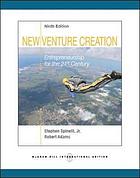 New Venture Creation
by
New Venture Creation: Entrepreneurship for the 21st Century is about the process of getting a new venture started, growing the venture, successfully harvesting it, and starting again. The book presents the substantial body of knowledge about the entrepreneurial process in a pragmatic way – through text, case studies, and hands-on exercises – to help readers compress their learning curves, reduce their ultimate risk and pain, and allow them to gain more from their subsequent entrepreneurial experiences.
New Venture Creation
by
New Venture Creation: Entrepreneurship for the 21st Century is about the process of getting a new venture started, growing the venture, successfully harvesting it, and starting again. The book presents the substantial body of knowledge about the entrepreneurial process in a pragmatic way – through text, case studies, and hands-on exercises – to help readers compress their learning curves, reduce their ultimate risk and pain, and allow them to gain more from their subsequent entrepreneurial experiences.
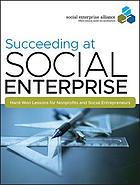 Succeeding at Social Enterprise: hard-won lessons for nonprofits and social entrepreneurs
by
From the Social Enterprise Alliance, the organization dedicated to building a robust social enterprise field, comes Succeeding at Social Enterprise. This practical guide is filled with the best practices, tools, guidance, models and successful cases for leaders (and future leaders) of social ventures and enterprises. A groundbreaking work, it brings together the knowledge and experience of social enterprise pioneers in the field and some of today's most successful social entrepreneurs to show what it takes to implement and run an effective social venture or organization. Succeeding at Social Enterprise focuses on real life examples, lessons learned and the core competencies that are needed to run a social venture in a nonprofit, highlighting such skills as managing and leading, business planning, marketing and sales, and accounting. Praise for Succeeding at Social Enterprise "This is a must read for anyone starting or growing a social enterprise. The lessons learned offer valuable, practical and real insights from pioneers in the field. The frameworks and tools presented can be implemented immediately to help drive success and expand your social impact." --KRISS DEIGLMEIER, executive director, Center for Social Innovation, Stanford Graduate School of Business "By successfully weaving together the best thinking and advice from a diverse set of our field's leading experts and practitioners, Succeeding at Social Enterprise will be the new 'must have' handbook for Social Enterprise."--JED EMERSON, www.BlendedValue.org "This is a timely book needed for a movement that's taking off. The leading thinkers and top practitioners in this book make today's pressing issues clear to both the novice and the expe-rienced social entrepreneur."--KEVIN JONES, founding principal, Good Capital "Written by the nation's leading experts on starting, building and leading a successful social venture, this book is a profoundly important contribution to the growing body of literature on social entrepreneurship. No other book brings to bear this kind of business experience, practi- cal advice and wisdom on the challenges of creating and sustaining a social enterprise." --DAVID ROLL, founder, Lex Mundi Pro Bono Foundation The Social Enterprise Alliance is advocate for the field, hub of information and education, and builder of a vibrant and growing community of social enterprises.
Succeeding at Social Enterprise: hard-won lessons for nonprofits and social entrepreneurs
by
From the Social Enterprise Alliance, the organization dedicated to building a robust social enterprise field, comes Succeeding at Social Enterprise. This practical guide is filled with the best practices, tools, guidance, models and successful cases for leaders (and future leaders) of social ventures and enterprises. A groundbreaking work, it brings together the knowledge and experience of social enterprise pioneers in the field and some of today's most successful social entrepreneurs to show what it takes to implement and run an effective social venture or organization. Succeeding at Social Enterprise focuses on real life examples, lessons learned and the core competencies that are needed to run a social venture in a nonprofit, highlighting such skills as managing and leading, business planning, marketing and sales, and accounting. Praise for Succeeding at Social Enterprise "This is a must read for anyone starting or growing a social enterprise. The lessons learned offer valuable, practical and real insights from pioneers in the field. The frameworks and tools presented can be implemented immediately to help drive success and expand your social impact." --KRISS DEIGLMEIER, executive director, Center for Social Innovation, Stanford Graduate School of Business "By successfully weaving together the best thinking and advice from a diverse set of our field's leading experts and practitioners, Succeeding at Social Enterprise will be the new 'must have' handbook for Social Enterprise."--JED EMERSON, www.BlendedValue.org "This is a timely book needed for a movement that's taking off. The leading thinkers and top practitioners in this book make today's pressing issues clear to both the novice and the expe-rienced social entrepreneur."--KEVIN JONES, founding principal, Good Capital "Written by the nation's leading experts on starting, building and leading a successful social venture, this book is a profoundly important contribution to the growing body of literature on social entrepreneurship. No other book brings to bear this kind of business experience, practi- cal advice and wisdom on the challenges of creating and sustaining a social enterprise." --DAVID ROLL, founder, Lex Mundi Pro Bono Foundation The Social Enterprise Alliance is advocate for the field, hub of information and education, and builder of a vibrant and growing community of social enterprises.
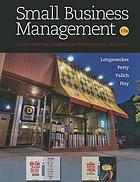 Small Business Management: launching & growing entrepreneurial ventures
by
Realize your dream for small business success with this market-leading book. SMALL BUSINESS MANAGEMENT: LAUNCHING AND GROWING ENTREPRENEURIAL VENTURES, 17E provides the practical concepts, entrepreneurial insights, and comprehensive resources you'll find essential both now and throughout your management future. SMALL BUSINESS MANAGEMENT delivers solid coverage of the fundamentals of business management as it teaches you not only how to start a business, but also how to manage, grow, and harvest a business.This market leading text places you in the role of decision maker, allowing you to immediately apply what you've learned to current challenges in today's small businesses. The book's thorough emphasis on building business plans ensures that you can effectively create, manage, and analyze a plan for your own venture. Unforgettable examples, exciting video cases, and coverage of the most current developments in business management today keep this engaging text as current and practical now as it was when it led the market in its first edition 50 years ago. Each edition builds upon past strengths with new innovations and breakthrough developments.SMALL BUSINESS MANAGEMENT: LAUNCHING AND GROWING ENTREPRENEURIAL VENTURES, 17E offers the insights and practical principles that you'll reference again and again throughout your business career. Available with InfoTrac® Student Collections http://gocengage.com/infotrac.
Small Business Management: launching & growing entrepreneurial ventures
by
Realize your dream for small business success with this market-leading book. SMALL BUSINESS MANAGEMENT: LAUNCHING AND GROWING ENTREPRENEURIAL VENTURES, 17E provides the practical concepts, entrepreneurial insights, and comprehensive resources you'll find essential both now and throughout your management future. SMALL BUSINESS MANAGEMENT delivers solid coverage of the fundamentals of business management as it teaches you not only how to start a business, but also how to manage, grow, and harvest a business.This market leading text places you in the role of decision maker, allowing you to immediately apply what you've learned to current challenges in today's small businesses. The book's thorough emphasis on building business plans ensures that you can effectively create, manage, and analyze a plan for your own venture. Unforgettable examples, exciting video cases, and coverage of the most current developments in business management today keep this engaging text as current and practical now as it was when it led the market in its first edition 50 years ago. Each edition builds upon past strengths with new innovations and breakthrough developments.SMALL BUSINESS MANAGEMENT: LAUNCHING AND GROWING ENTREPRENEURIAL VENTURES, 17E offers the insights and practical principles that you'll reference again and again throughout your business career. Available with InfoTrac® Student Collections http://gocengage.com/infotrac.
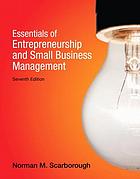 Essentials of Entrepreneurship and Small Business Management
by
Intended primarily for undergraduate courses in small business management or entrepreneurship, this text also provides practical content to anyone interested in starting their own business. With a practical, "hands on" approach to entrepreneurship, this text aims to provide readers with the knowledge and tools they need to launch a business so that it has the greatest chance for success.
Essentials of Entrepreneurship and Small Business Management
by
Intended primarily for undergraduate courses in small business management or entrepreneurship, this text also provides practical content to anyone interested in starting their own business. With a practical, "hands on" approach to entrepreneurship, this text aims to provide readers with the knowledge and tools they need to launch a business so that it has the greatest chance for success.
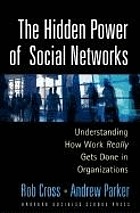 The Hidden Power of Social Networks
by
A powerful, visual framework helps managers discover how employees really communicate and collaborate to get work done - and helps them identify ways they can influence these social networks to improve performance and innovation. In The Hidden Power of Social Networks, Cross and Parker, experts in "social network analysis"--a technique that visually maps relationships between people in large, distributed groups - apply this powerful tool to management for the first time. Based on their in-depth study of sixty informal employee networks in well-known companies around the world, Cross and Parker show managers how to conduct a social network analysis of their organization.
The Hidden Power of Social Networks
by
A powerful, visual framework helps managers discover how employees really communicate and collaborate to get work done - and helps them identify ways they can influence these social networks to improve performance and innovation. In The Hidden Power of Social Networks, Cross and Parker, experts in "social network analysis"--a technique that visually maps relationships between people in large, distributed groups - apply this powerful tool to management for the first time. Based on their in-depth study of sixty informal employee networks in well-known companies around the world, Cross and Parker show managers how to conduct a social network analysis of their organization.
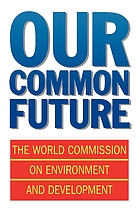 Our Common Future
by
Most of today's decision makers will be dead before the planet suffers the full consequences of acid rain, global warning, ozone depletion, widespread desertification, and species loss. Most of today's young voters, however, will be alive.In this, perhaps the most important document of the decade on the future of the world, the urgency of changing certain policy decisions, some of which threaten the very survival of the human race, is made abundantly clear.The World Commission on Environment and Development, headed by Gro Harlem Brundtland, Prime Minister of Norway, was set up as an independent body in 1983 by the United Nations. Its brief was to re-examine the critical environment, to develop proposals to solve them, and to ensure that humanprogress will be sustained through development without bankrupting the resources of future generations.In Our Common Future, the Commission serves notice that the time has come for a marriage of economy and ecology, so that governments and their people can take responsibility not just for environmental damage, but for the policies that cause the damage. It is not too late to change these policies;but, it warns, we must act now.
Our Common Future
by
Most of today's decision makers will be dead before the planet suffers the full consequences of acid rain, global warning, ozone depletion, widespread desertification, and species loss. Most of today's young voters, however, will be alive.In this, perhaps the most important document of the decade on the future of the world, the urgency of changing certain policy decisions, some of which threaten the very survival of the human race, is made abundantly clear.The World Commission on Environment and Development, headed by Gro Harlem Brundtland, Prime Minister of Norway, was set up as an independent body in 1983 by the United Nations. Its brief was to re-examine the critical environment, to develop proposals to solve them, and to ensure that humanprogress will be sustained through development without bankrupting the resources of future generations.In Our Common Future, the Commission serves notice that the time has come for a marriage of economy and ecology, so that governments and their people can take responsibility not just for environmental damage, but for the policies that cause the damage. It is not too late to change these policies;but, it warns, we must act now.
 Sustainable Development of the Biosphere
by
The future management of the world's resources depends upon reconciling the needs of socio-economic development with the conservation of the world's environment. This book provides a strategic framework for understanding and managing the long-term and large-scale interactions between these two requirements, based upon the sustainable development of the natural resources of the biosphere. It represents the first results of an on-going collaborative study organised by the International Institute for Applied Systems Analysis and involving some of the world's leading historians, natural scientists, development specialists and policy advisors. It provides an authoritative introduction to some of the most complex contemporary environmental issues, and is written in an easily comprehensible style to make the information accessible to a wide range of professional disciplines, to policy makers and analysts, and to the concerned layman.
Sustainable Development of the Biosphere
by
The future management of the world's resources depends upon reconciling the needs of socio-economic development with the conservation of the world's environment. This book provides a strategic framework for understanding and managing the long-term and large-scale interactions between these two requirements, based upon the sustainable development of the natural resources of the biosphere. It represents the first results of an on-going collaborative study organised by the International Institute for Applied Systems Analysis and involving some of the world's leading historians, natural scientists, development specialists and policy advisors. It provides an authoritative introduction to some of the most complex contemporary environmental issues, and is written in an easily comprehensible style to make the information accessible to a wide range of professional disciplines, to policy makers and analysts, and to the concerned layman.
 Development: a Very Short Introduction
by
What do we mean by development? How can citizens, governments and the international community foster development?The process by which nations escape poverty and achieve economic and social progress has been the subject of extensive examination for hundreds of years.The notion of development itself has evolved from an original preoccupation with incomes and economic growth to a much broader understanding ofdevelopment.In this Very Short Introduction Ian Goldin considers the contributions that education, health, gender, equity, and other dimensions of human well-being make to development, and discusses why it is also necessary to include the role of institutions and the rule of law as well as sustainability andenvironmental concerns.ABOUT THE SERIES: The Very Short Introductions series from Oxford University Press contains hundreds of titles in almost every subject area. These pocket-sized books are the perfect way to get ahead in a new subject quickly. Our expert authors combine facts, analysis, perspective, new ideas, andenthusiasm to make interesting and challenging topics highly readable.
Development: a Very Short Introduction
by
What do we mean by development? How can citizens, governments and the international community foster development?The process by which nations escape poverty and achieve economic and social progress has been the subject of extensive examination for hundreds of years.The notion of development itself has evolved from an original preoccupation with incomes and economic growth to a much broader understanding ofdevelopment.In this Very Short Introduction Ian Goldin considers the contributions that education, health, gender, equity, and other dimensions of human well-being make to development, and discusses why it is also necessary to include the role of institutions and the rule of law as well as sustainability andenvironmental concerns.ABOUT THE SERIES: The Very Short Introductions series from Oxford University Press contains hundreds of titles in almost every subject area. These pocket-sized books are the perfect way to get ahead in a new subject quickly. Our expert authors combine facts, analysis, perspective, new ideas, andenthusiasm to make interesting and challenging topics highly readable.
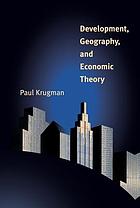 Development, Geography, and Economic Theory
by
Why do certain ideas gain currency in economics while others fall by the wayside? Paul Krugman argues that the unwillingness of mainstream economists to think about what they could not formalize led them to ignore ideas that turn out, in retrospect, to have been very good ones. Krugman examines the course of economic geograph and development theory to shed light on the nature of economic inquiry. He traces how development theory lost its huge initial influence and virtually disappeared from economic discourse after it became clear that many of the theory's main insights could not be clearly modeled. Economic geography seems to have fared even worse, as economists shied away from grappling with questions about space--such as the size, location, or even existence of cities--because the "terrain was seen as unsuitable for the tools at hand." Krugman's book, however, is not a call to abandon economic modeling. He concludes with a reminder of why insisting on the use of models may be right, even when these sometimes lead economists to overlook good ideas. He also recaps the discussion of development and economic geography with a commentary on recent developments in those fields and areas where further inquiry looks most promising.
Development, Geography, and Economic Theory
by
Why do certain ideas gain currency in economics while others fall by the wayside? Paul Krugman argues that the unwillingness of mainstream economists to think about what they could not formalize led them to ignore ideas that turn out, in retrospect, to have been very good ones. Krugman examines the course of economic geograph and development theory to shed light on the nature of economic inquiry. He traces how development theory lost its huge initial influence and virtually disappeared from economic discourse after it became clear that many of the theory's main insights could not be clearly modeled. Economic geography seems to have fared even worse, as economists shied away from grappling with questions about space--such as the size, location, or even existence of cities--because the "terrain was seen as unsuitable for the tools at hand." Krugman's book, however, is not a call to abandon economic modeling. He concludes with a reminder of why insisting on the use of models may be right, even when these sometimes lead economists to overlook good ideas. He also recaps the discussion of development and economic geography with a commentary on recent developments in those fields and areas where further inquiry looks most promising.
 Economic Development
by
For courses on economic development A complete, balanced introduction to the theory, issues, and latest research. Economic Development, Twelfth Edition--the leading textbook in this field--provides students with a complete and balanced introduction to the requisite theory, driving policy issues, and latest research. Todaro and Smith take a policy-oriented approach, presenting economic theory in the context of critical policy debates and country-specific case studies so you can see how theory relates to the problems and prospects of developing countries. Teaching and Learning Experiences This program presents a better teaching and learning experience-for you and your students. Use the text's Hallmark Approach to presenting engaging information: Shaped by the authors' personalities, this approach is backed up with extensive research and travel to provide the best data possible. Teach with strong pedagogy tools: The text reinforces central key concepts by presenting a clear learning path for students. Give students a real-world global perspective: Students are able togain a unique perspective about world issues from two authors who strive to address different sides to problems.
Economic Development
by
For courses on economic development A complete, balanced introduction to the theory, issues, and latest research. Economic Development, Twelfth Edition--the leading textbook in this field--provides students with a complete and balanced introduction to the requisite theory, driving policy issues, and latest research. Todaro and Smith take a policy-oriented approach, presenting economic theory in the context of critical policy debates and country-specific case studies so you can see how theory relates to the problems and prospects of developing countries. Teaching and Learning Experiences This program presents a better teaching and learning experience-for you and your students. Use the text's Hallmark Approach to presenting engaging information: Shaped by the authors' personalities, this approach is backed up with extensive research and travel to provide the best data possible. Teach with strong pedagogy tools: The text reinforces central key concepts by presenting a clear learning path for students. Give students a real-world global perspective: Students are able togain a unique perspective about world issues from two authors who strive to address different sides to problems.
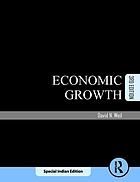 Economic Growth
by
Why are some countries rich and others poor? David N. Weil, one of the top researchers in economic growth, introduces students to the latest theoretical tools, data, and insights underlying this pivotal question. By showing how empirical data relate to new and old theoretical ideas, Economic Growth provides students with a complete introduction to the discipline and the latest research. With its comprehensive and flexible organization, Economic Growth is ideal for a wide array of courses, including undergraduate and graduate courses in economic growth, economic development, macro theory, applied econometrics, and development studies.
Economic Growth
by
Why are some countries rich and others poor? David N. Weil, one of the top researchers in economic growth, introduces students to the latest theoretical tools, data, and insights underlying this pivotal question. By showing how empirical data relate to new and old theoretical ideas, Economic Growth provides students with a complete introduction to the discipline and the latest research. With its comprehensive and flexible organization, Economic Growth is ideal for a wide array of courses, including undergraduate and graduate courses in economic growth, economic development, macro theory, applied econometrics, and development studies.
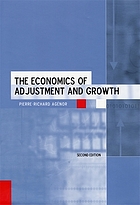 The Economics of Adjustment and Growth
by
This book provides a systematic and coherent framework for understanding the interactions between the micro and macro dimensions of economic adjustment policies; that is, it explores short-run macroeconomic management and structural adjustment policies aimed at promoting economic growth. It emphasizes the importance of structural microeconomic characteristics in the transmission of policy shocks and the response of the economy to adjustment policies. It has particular relevance to the economics of developing countries. The book is directed to economists interested in an overview of the economics of reform; economists in international organizations, such as the UN, the IMF, and the World Bank, dealing with development; and economists in developing countries. It is also a text for advanced undergraduate students pursuing a degree in economic policy and management and students in political science and public policy.
The Economics of Adjustment and Growth
by
This book provides a systematic and coherent framework for understanding the interactions between the micro and macro dimensions of economic adjustment policies; that is, it explores short-run macroeconomic management and structural adjustment policies aimed at promoting economic growth. It emphasizes the importance of structural microeconomic characteristics in the transmission of policy shocks and the response of the economy to adjustment policies. It has particular relevance to the economics of developing countries. The book is directed to economists interested in an overview of the economics of reform; economists in international organizations, such as the UN, the IMF, and the World Bank, dealing with development; and economists in developing countries. It is also a text for advanced undergraduate students pursuing a degree in economic policy and management and students in political science and public policy.
 The Limits of the Market : the pendulum between government and market
by
Will the financial crisis and growing inequality mark a new turning point in the balance of power between the free market and government? Are we about to witness the overthrow of capitalism, and will the state resume control? In The Limits of the Market, Paul De Grauwe examines why a healthy mix of market and state seems so difficult. Periods in which the free market gains in importance inevitably alternate with periods in which the governmenttakes control.
The Limits of the Market : the pendulum between government and market
by
Will the financial crisis and growing inequality mark a new turning point in the balance of power between the free market and government? Are we about to witness the overthrow of capitalism, and will the state resume control? In The Limits of the Market, Paul De Grauwe examines why a healthy mix of market and state seems so difficult. Periods in which the free market gains in importance inevitably alternate with periods in which the governmenttakes control.
 Development economics
by
Development economics
by
 Хозяйство джуйбарских шейхов : к истории феодального землевладения в Средней Азии в ХVI-XVII вв.
by
Хозяйство джуйбарских шейхов : к истории феодального землевладения в Средней Азии в ХVI-XVII вв.
by
 Zemelʹno-vodnye resursy Sredneĭ Azii i ikh selʹskokhozi︠a︡ĭstvennoe ispolʹzovanie
by
Zemelʹno-vodnye resursy Sredneĭ Azii i ikh selʹskokhozi︠a︡ĭstvennoe ispolʹzovanie
by
 The Global Food Economy: the battle for the future of farming
by
The Global Food Economy examines the human and ecological cost of what we eat. The current food economy is characterized by immense contradictions. Surplus 'food mountains', bountiful supermarkets, and rising levels of obesity stand in stark contrast to widespread hunger and malnutrition. Transnational companies dominate the market in food and benefit from subsidies, whilst farmers in developing countries remain impoverished. Food miles, mounting toxicity and the 'ecological hoofprint' of livestock mean that the global food economy rests on increasingly shaky environmental foundations. This book looks at how such a system came about, and how it is being enforced by the WTO. Ultimately, Weis considers how we can find a way of building socially just, ecologically rational and humane food economies.
The Global Food Economy: the battle for the future of farming
by
The Global Food Economy examines the human and ecological cost of what we eat. The current food economy is characterized by immense contradictions. Surplus 'food mountains', bountiful supermarkets, and rising levels of obesity stand in stark contrast to widespread hunger and malnutrition. Transnational companies dominate the market in food and benefit from subsidies, whilst farmers in developing countries remain impoverished. Food miles, mounting toxicity and the 'ecological hoofprint' of livestock mean that the global food economy rests on increasingly shaky environmental foundations. This book looks at how such a system came about, and how it is being enforced by the WTO. Ultimately, Weis considers how we can find a way of building socially just, ecologically rational and humane food economies.
 Blue Gold: the battle against corporate theft of the world's water
by
In this international bestseller, currently available in more than a dozen countries, Maude Barlow and Tony Clarke describe the real and worsening global water crisis, and reveal the plans of transnational corporations to profit from it. The authors present both a compelling case and a practical plan for fighting back against the corporate takeover of this most precious natural resource.
Blue Gold: the battle against corporate theft of the world's water
by
In this international bestseller, currently available in more than a dozen countries, Maude Barlow and Tony Clarke describe the real and worsening global water crisis, and reveal the plans of transnational corporations to profit from it. The authors present both a compelling case and a practical plan for fighting back against the corporate takeover of this most precious natural resource.
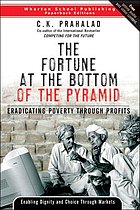 The Fortune at the Bottom of the Pyramid
by
The world's most exciting, fastest - growing new market is where you least expect it: at the bottom of the pyramid. Collectively, the world's billions of poor people have immense untapped buying power. They represent an enormous opportunity for companies who learn how to serve them. Not only can it be done, it is being done - very profitably. What's more, companies aren't just making money: by serving these markets, they're helping millions of the world's poorest people escape poverty. C.K. Prahalad's global bestseller The Fortune at the Bottom of the Pyramid, now available in paperback, shows why you can't afford to ignore "Bottom of the Pyramid " (BOP) markets. Now available in paperback, it offers a blueprint for driving the radical innovation you'll need to profit in emerging markets - and using those innovations to become more competitive everywhere.
The Fortune at the Bottom of the Pyramid
by
The world's most exciting, fastest - growing new market is where you least expect it: at the bottom of the pyramid. Collectively, the world's billions of poor people have immense untapped buying power. They represent an enormous opportunity for companies who learn how to serve them. Not only can it be done, it is being done - very profitably. What's more, companies aren't just making money: by serving these markets, they're helping millions of the world's poorest people escape poverty. C.K. Prahalad's global bestseller The Fortune at the Bottom of the Pyramid, now available in paperback, shows why you can't afford to ignore "Bottom of the Pyramid " (BOP) markets. Now available in paperback, it offers a blueprint for driving the radical innovation you'll need to profit in emerging markets - and using those innovations to become more competitive everywhere.
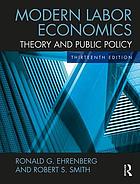 Modern Labor Economics
by
Modern Labor Economics: Theory and Public Policy, now in its thirteenth edition, continues to be the leading text for one-semester courses in labor economics at the undergraduate and graduate levels. It offers a thorough overview of the modern theory of labor market behavior, and reveals how this theory is used to analyze public policy. Designed for students who may not have extensive backgrounds in economics, the text balances theoretical coverage with examples of practical applications that allow students to see concepts in action. Experienced educators for nearly four decades, co-authors Ehrenberg and Smith believe that showing students the social implications of the concepts discussed in the course will enhance their motivation to learn. As such, this text presents numerous examples of policy decisions that have been affected by the ever-shifting labor market.   This new edition continues to offer: a balance of relevant, contemporary examples; coverage of the current economic climate; introduction to basic methodological techniques and problems; tools for review and further study. In addition to providing updated data and examples throughout, the thirteenth edition offers greater coverage of inequality, healthcare policy, and labor-replacing technologies. The text is also supported by a full range of companion online materials.
Modern Labor Economics
by
Modern Labor Economics: Theory and Public Policy, now in its thirteenth edition, continues to be the leading text for one-semester courses in labor economics at the undergraduate and graduate levels. It offers a thorough overview of the modern theory of labor market behavior, and reveals how this theory is used to analyze public policy. Designed for students who may not have extensive backgrounds in economics, the text balances theoretical coverage with examples of practical applications that allow students to see concepts in action. Experienced educators for nearly four decades, co-authors Ehrenberg and Smith believe that showing students the social implications of the concepts discussed in the course will enhance their motivation to learn. As such, this text presents numerous examples of policy decisions that have been affected by the ever-shifting labor market.   This new edition continues to offer: a balance of relevant, contemporary examples; coverage of the current economic climate; introduction to basic methodological techniques and problems; tools for review and further study. In addition to providing updated data and examples throughout, the thirteenth edition offers greater coverage of inequality, healthcare policy, and labor-replacing technologies. The text is also supported by a full range of companion online materials.
 Consequences of Creating a Market Economy : evidence from household surveys in Central Asia
by
This book uses household survey data from five Central Asian countries to analyse the important consequences of, and elements that constitute, the creation of a market economy. The countries studied - Kazakhstan, the Kyrgyz Republic, Tajikistan, Turkmenistan and Uzbekistan - had taken minimal action towards creating a market economy before the dissolution of the USSR in late 1991. From similar initial conditions they have pursued different post-independence economic strategies, making them ideal candidates for comparative analysis.The pivotal question concerns the determination of living standards. Who gained and who lost from the transition to a market economy? Which characteristics are rewarded in a new market economy? How do national policies and other systematic factors affect these outcomes? The authors also address other important issues that have emerged during transition debates: the position of women and the role of small businesses. The book analyses the gender issue in the narrow, but significant, sense of what happened to women in the labour market and the authors also analyze the characteristics of households with non-farm businesses.This book will prove invaluable to academics and researchers of Asian studies and particularly those with an interest in economic development and labour economics within the region.
Consequences of Creating a Market Economy : evidence from household surveys in Central Asia
by
This book uses household survey data from five Central Asian countries to analyse the important consequences of, and elements that constitute, the creation of a market economy. The countries studied - Kazakhstan, the Kyrgyz Republic, Tajikistan, Turkmenistan and Uzbekistan - had taken minimal action towards creating a market economy before the dissolution of the USSR in late 1991. From similar initial conditions they have pursued different post-independence economic strategies, making them ideal candidates for comparative analysis.The pivotal question concerns the determination of living standards. Who gained and who lost from the transition to a market economy? Which characteristics are rewarded in a new market economy? How do national policies and other systematic factors affect these outcomes? The authors also address other important issues that have emerged during transition debates: the position of women and the role of small businesses. The book analyses the gender issue in the narrow, but significant, sense of what happened to women in the labour market and the authors also analyze the characteristics of households with non-farm businesses.This book will prove invaluable to academics and researchers of Asian studies and particularly those with an interest in economic development and labour economics within the region.
 The Politics of Food : the global conflict between food security and food sovereignty
by
A description of the current global food system, this book challenges our ethical responsibility to the global poor and implicates us all for failing to curb global hunger and malnutrition. The Politics of Food: The Global Conflict between Food Security and Food Sovereignty argues that our current global food system constitutes a massive violation of human rights. In this impassioned, well-researched book, William Schanbacher makes the case that the food security model for combating global hunger--driven by the United Nations, the World Bank, the International Monetary Fund, and other organizations--is a failure, too dependent on trade and too reliant on international agribusiness. Instead, the emerging model of food sovereignty--helping local farmers and businesses produce better quality food--is the more effective and responsible approach. Through numerous case studies, the book examines critical issues of global trade and corporate monopolization of the food industry, while examining the emerging social justice movements that seek to make food sovereignty the model for battling hunger. Includes citations and references to primary source documents of the United Nations, World Bank, the International Monetary Fund, and the World Trade Organization Offers an index of key terms and themes, such as food security, food sovereignty, and human rights
The Politics of Food : the global conflict between food security and food sovereignty
by
A description of the current global food system, this book challenges our ethical responsibility to the global poor and implicates us all for failing to curb global hunger and malnutrition. The Politics of Food: The Global Conflict between Food Security and Food Sovereignty argues that our current global food system constitutes a massive violation of human rights. In this impassioned, well-researched book, William Schanbacher makes the case that the food security model for combating global hunger--driven by the United Nations, the World Bank, the International Monetary Fund, and other organizations--is a failure, too dependent on trade and too reliant on international agribusiness. Instead, the emerging model of food sovereignty--helping local farmers and businesses produce better quality food--is the more effective and responsible approach. Through numerous case studies, the book examines critical issues of global trade and corporate monopolization of the food industry, while examining the emerging social justice movements that seek to make food sovereignty the model for battling hunger. Includes citations and references to primary source documents of the United Nations, World Bank, the International Monetary Fund, and the World Trade Organization Offers an index of key terms and themes, such as food security, food sovereignty, and human rights
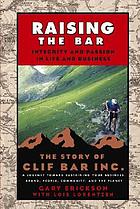 Raising the Bar: a journey toward sustaining your business, brand, people, community, and the planet
by
In April of 2000, Gary Erickson turned down a $120 million offer to buy his thriving company. Today, instead of taking it easy for the rest of his life and enjoying a luxurious retirement, he's working harder than ever. Why would any sane person pass up the financial opportunity of a lifetime? Raising the Bar tells the amazing story of Clif Bar's Gary Erickson and shows that some things are more important than money. Gary Erickson and coauthor Lois Lorentzen tell the unusual and inspiring story about following your passion, the freedom to create, sustaining a business over the long haul, and living responsibly in your community and on the earth. Raising the Bar chronicles Clif Bar's ascent from a homemade energy bar to a $100 million phenomenon with an estimated 35 million consumers, and a company hailed by Inc. magazine as one of the fastest-growing private companies in the U.S. four years in a row. The book is filled with compelling personal stories from Erickson's life-trekking in the Himalayan mountains, riding his bicycle over roadless European mountain passes, climbing in the Sierra Nevada range--as inspiration for his philosophy of business. Throughout the book, Erickson--a competitive cyclist, jazz musician, world traveler, mountain climber, wilderness guide, and entrepreneur--convinces us that sustaining one's employees, community, and environment is good business. If you are a manager, executive, business owner, or board member, Raising the Bar is your personal guide to corporate integrity. If you are a sports enthusiast, environmentalist, adventure lover, intrigued by a unique corporate culture, or just interested in a good story, Raising the Bar is for you.
Raising the Bar: a journey toward sustaining your business, brand, people, community, and the planet
by
In April of 2000, Gary Erickson turned down a $120 million offer to buy his thriving company. Today, instead of taking it easy for the rest of his life and enjoying a luxurious retirement, he's working harder than ever. Why would any sane person pass up the financial opportunity of a lifetime? Raising the Bar tells the amazing story of Clif Bar's Gary Erickson and shows that some things are more important than money. Gary Erickson and coauthor Lois Lorentzen tell the unusual and inspiring story about following your passion, the freedom to create, sustaining a business over the long haul, and living responsibly in your community and on the earth. Raising the Bar chronicles Clif Bar's ascent from a homemade energy bar to a $100 million phenomenon with an estimated 35 million consumers, and a company hailed by Inc. magazine as one of the fastest-growing private companies in the U.S. four years in a row. The book is filled with compelling personal stories from Erickson's life-trekking in the Himalayan mountains, riding his bicycle over roadless European mountain passes, climbing in the Sierra Nevada range--as inspiration for his philosophy of business. Throughout the book, Erickson--a competitive cyclist, jazz musician, world traveler, mountain climber, wilderness guide, and entrepreneur--convinces us that sustaining one's employees, community, and environment is good business. If you are a manager, executive, business owner, or board member, Raising the Bar is your personal guide to corporate integrity. If you are a sports enthusiast, environmentalist, adventure lover, intrigued by a unique corporate culture, or just interested in a good story, Raising the Bar is for you.
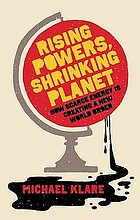 Rising Powers, Shrinking Planet: the new geopolitics of energy
by
From the author of the now-classicResource Wars, an indispensable account of how the world's diminishing sources of energy are radically changing the international balance of power Recently, an unprecedented Chinese attempt to acquire the major American energy firm Unocal was blocked by Congress amidst hysterical warnings of a Communist threat. But the political grandstanding missed a larger point: the takeover bid was a harbinger of a new structure of world power, based not on market forces or on arms and armies but on the possession of vital natural resources. Surveying the energy-driven dynamic that is reconfiguring the international landscape, Michael Klare, the preeminent expert on resource geopolitics, forecasts a future of surprising new alliances and explosive danger. World leaders are now facing the stark recognition that all materials vital for the functioning of modern industrial societies (not just oil and natural gas but uranium, coal, copper, and others) are finite and being depleted at an ever-accelerating rate. As a result, governments rather than corporations are increasingly spearheading the pursuit of resources. In a radically altered world-- where Russia is transformed from battered Cold War loser to arrogant broker of Eurasian energy, and the United States is forced to compete with the emerging "Chindia" juggernaut--the only route to survival on a shrinking planet, Klare shows, lies through international cooperation. Rising Powers, Shrinking Planet surveys the energy-driven dynamic that is reconfiguring the international landscape, and argues that the only route to survival in our radically altered world lies through international cooperation. "Klare's superb book explains, in haunting detail, the trends that will lead us into a series of dangerous traps unless we muster the will to transform the way we use energy." -- Bill McKibben
Rising Powers, Shrinking Planet: the new geopolitics of energy
by
From the author of the now-classicResource Wars, an indispensable account of how the world's diminishing sources of energy are radically changing the international balance of power Recently, an unprecedented Chinese attempt to acquire the major American energy firm Unocal was blocked by Congress amidst hysterical warnings of a Communist threat. But the political grandstanding missed a larger point: the takeover bid was a harbinger of a new structure of world power, based not on market forces or on arms and armies but on the possession of vital natural resources. Surveying the energy-driven dynamic that is reconfiguring the international landscape, Michael Klare, the preeminent expert on resource geopolitics, forecasts a future of surprising new alliances and explosive danger. World leaders are now facing the stark recognition that all materials vital for the functioning of modern industrial societies (not just oil and natural gas but uranium, coal, copper, and others) are finite and being depleted at an ever-accelerating rate. As a result, governments rather than corporations are increasingly spearheading the pursuit of resources. In a radically altered world-- where Russia is transformed from battered Cold War loser to arrogant broker of Eurasian energy, and the United States is forced to compete with the emerging "Chindia" juggernaut--the only route to survival on a shrinking planet, Klare shows, lies through international cooperation. Rising Powers, Shrinking Planet surveys the energy-driven dynamic that is reconfiguring the international landscape, and argues that the only route to survival in our radically altered world lies through international cooperation. "Klare's superb book explains, in haunting detail, the trends that will lead us into a series of dangerous traps unless we muster the will to transform the way we use energy." -- Bill McKibben
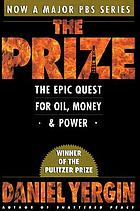 The Prize: the epic quest for oil, money, and power
by
Hailed by "The New York Times" as "a book that must be read to understand the first thing about the role of oil in modern history," Yergin's bestselling Pulitzer Prize-winner was made into an exciting eight-part miniseries that aired on PBS. 32 pages of photos.
The Prize: the epic quest for oil, money, and power
by
Hailed by "The New York Times" as "a book that must be read to understand the first thing about the role of oil in modern history," Yergin's bestselling Pulitzer Prize-winner was made into an exciting eight-part miniseries that aired on PBS. 32 pages of photos.
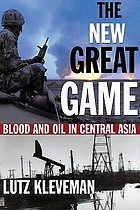 The New Great Game: blood and oil in Central Asia
by
In the tradition of "The Prize," Kleveman gives readers the 21st-century chapter on the history, passion, and politics of oil and gas resources and the struggle to control them in a critical part of the world.
The New Great Game: blood and oil in Central Asia
by
In the tradition of "The Prize," Kleveman gives readers the 21st-century chapter on the history, passion, and politics of oil and gas resources and the struggle to control them in a critical part of the world.
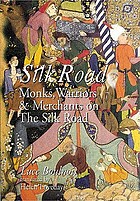 Silk Road monks, warriors & merchants on the Silk Road
by
Place names such as Samarkand, Bukhara, Khotan and Chang'an continue to fascinate with the richness of their past. In this authoritative book, Luce Boulnois explores the encounter between East and West across the vast continental expanse that separates th
Silk Road monks, warriors & merchants on the Silk Road
by
Place names such as Samarkand, Bukhara, Khotan and Chang'an continue to fascinate with the richness of their past. In this authoritative book, Luce Boulnois explores the encounter between East and West across the vast continental expanse that separates th
 Himalayan trade routes to Central Asia : some aspects of international trade in the Himalayan region, 1858-1907
by
Himalayan trade routes to Central Asia : some aspects of international trade in the Himalayan region, 1858-1907
by
 K istorii stroitelʹstva zheleznykh dorog v Sredneĭ Azii : (1880-1917 gg.)
by
K istorii stroitelʹstva zheleznykh dorog v Sredneĭ Azii : (1880-1917 gg.)
by
 Stalin's Railroad: Turksib and the building of socialism
by
The Turkestano-Siberian Railroad, or Turksib, was one of the great construction projects of the Soviet Union's First Five-Year Plan. As the major icon to ending the economic "backwardness" of the USSR's minority republics, it stood apart from similar efforts as one of the most potent metaphors for the creation of a unified socialist nation. Built between December 1926 and January 1931 by nearly 50,000 workers and at a cost of more 161 million rubles, Turksib embodied the Bolsheviks' commitment to end ethnic inequality and promote cultural revolution in one the far-flung corners of the old Tsarist Empire, Kazakhstan. Trumpeted as the "forge of the Kazakh proletariat," the railroad was to create a native working class, bringing not only trains to the steppes, but also the Revolution. In the first in-depth study of this grand project, Matthew Payne explores the transformation of its builders in Turksib's crucible of class war, race riots, state purges, and the brutal struggle of everyday life. In the battle for the souls of the nation's engineers, as well as the racial and ethnic conflicts that swirled, far from Moscow, around Stalin's vast campaign of industrialization, he finds a microcosm of the early Soviet Union.
Stalin's Railroad: Turksib and the building of socialism
by
The Turkestano-Siberian Railroad, or Turksib, was one of the great construction projects of the Soviet Union's First Five-Year Plan. As the major icon to ending the economic "backwardness" of the USSR's minority republics, it stood apart from similar efforts as one of the most potent metaphors for the creation of a unified socialist nation. Built between December 1926 and January 1931 by nearly 50,000 workers and at a cost of more 161 million rubles, Turksib embodied the Bolsheviks' commitment to end ethnic inequality and promote cultural revolution in one the far-flung corners of the old Tsarist Empire, Kazakhstan. Trumpeted as the "forge of the Kazakh proletariat," the railroad was to create a native working class, bringing not only trains to the steppes, but also the Revolution. In the first in-depth study of this grand project, Matthew Payne explores the transformation of its builders in Turksib's crucible of class war, race riots, state purges, and the brutal struggle of everyday life. In the battle for the souls of the nation's engineers, as well as the racial and ethnic conflicts that swirled, far from Moscow, around Stalin's vast campaign of industrialization, he finds a microcosm of the early Soviet Union.
 Statistics for Business and Economics
by
Get more out of your statistics course than simply solving equations. Discover how statistical information enables strong decisions in today�s business world with STATISTICS FOR BUSINESS AND ECONOMICS, REVISED 13E. Sound methodology combines with a proven problem-scenario approach, and meaningful applications for the most powerful approach to mastering critical business statistics. This edition�s prestigious author team brings together more than 25 years of unmatched experience to this thoroughly updated text. More than 350 real business examples, timely cases, and memorable exercises present the latest statistical data and business information with unwavering accuracy. To ensure the most relevant coverage, this edition includes coverage of popular commercial statistical software Minitab 17 and Excel 2016. Optional chapter appendices, coordinating data sets, and online learning tools, such as CengageNOW, create a customizable, efficient solution.
Statistics for Business and Economics
by
Get more out of your statistics course than simply solving equations. Discover how statistical information enables strong decisions in today�s business world with STATISTICS FOR BUSINESS AND ECONOMICS, REVISED 13E. Sound methodology combines with a proven problem-scenario approach, and meaningful applications for the most powerful approach to mastering critical business statistics. This edition�s prestigious author team brings together more than 25 years of unmatched experience to this thoroughly updated text. More than 350 real business examples, timely cases, and memorable exercises present the latest statistical data and business information with unwavering accuracy. To ensure the most relevant coverage, this edition includes coverage of popular commercial statistical software Minitab 17 and Excel 2016. Optional chapter appendices, coordinating data sets, and online learning tools, such as CengageNOW, create a customizable, efficient solution.
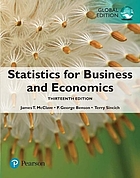 Statistics for business and economics
by
Statistics for business and economics
by
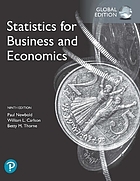 Statistics for business and economics
by
Statistics for business and economics
by
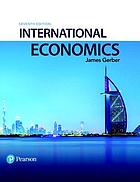 International Economics
by
For courses in international economics. Introduces international economics through accessible writing and real-life applications A principles-¿level introduction that's accessible to readers of all backgrounds, International Economics uses real-life applications to cover both the macro and micro components of international economics. The text illuminates economic institutions and policies, as well as recent developments in the global economy, without requiring the use of higher-¿level math. In addition, the text has a flexible approach, which includes self-¿contained chapters and comprehensive coverage, allowing readers to adapt its concepts to a wide range of possible uses. The 7th Edition includes a number of enhancements, such as updated tables and graphs, new case studies, and revised discussion of relevant topics. Also available with MyLab Economics MyLab(tm) Economics is an online homework, tutorial, and assessment program designed to work with this text to engage students and improve results. Within its structured environment, students practice what they learn, test their understanding, and pursue a personalized study plan that helps them better absorb course material and understand difficult concepts. Note: You are purchasing a standalone product; MyLab Economics does not come packaged with this content. Students, if interested in purchasing this title with MyLab Economics, ask your instructor for the correct package ISBN and Course ID. Instructors, contact your Pearson representative for more information. If you would like to purchase both the physical text and MyLab Economics, search for: 0134640241 / 9780134640242 International Economics Plus MyLab Economics with Pearson eText -- Access Card Package, 7/e Package consists of: 0134472098 / 9780134472096 International Economics 013463666X / 9780134636665 MyLab Economics with Pearson eText -- Standalone Access Card -- for International Economics
International Economics
by
For courses in international economics. Introduces international economics through accessible writing and real-life applications A principles-¿level introduction that's accessible to readers of all backgrounds, International Economics uses real-life applications to cover both the macro and micro components of international economics. The text illuminates economic institutions and policies, as well as recent developments in the global economy, without requiring the use of higher-¿level math. In addition, the text has a flexible approach, which includes self-¿contained chapters and comprehensive coverage, allowing readers to adapt its concepts to a wide range of possible uses. The 7th Edition includes a number of enhancements, such as updated tables and graphs, new case studies, and revised discussion of relevant topics. Also available with MyLab Economics MyLab(tm) Economics is an online homework, tutorial, and assessment program designed to work with this text to engage students and improve results. Within its structured environment, students practice what they learn, test their understanding, and pursue a personalized study plan that helps them better absorb course material and understand difficult concepts. Note: You are purchasing a standalone product; MyLab Economics does not come packaged with this content. Students, if interested in purchasing this title with MyLab Economics, ask your instructor for the correct package ISBN and Course ID. Instructors, contact your Pearson representative for more information. If you would like to purchase both the physical text and MyLab Economics, search for: 0134640241 / 9780134640242 International Economics Plus MyLab Economics with Pearson eText -- Access Card Package, 7/e Package consists of: 0134472098 / 9780134472096 International Economics 013463666X / 9780134636665 MyLab Economics with Pearson eText -- Standalone Access Card -- for International Economics
 Континентально-океаническая дихотомия в международном и региональном развитии
by
Континентально-океаническая дихотомия в международном и региональном развитии
by
 Globalization and Its Discontents: [essays on the new mobility of people and money]
by
Saskia Sassen is an internationally recognized expert on globalization whose writings have appeared in journals and magazines worldwide. Globalization and Its Discontents is a collection of Sassen's essays dealing with topics such as the "global city," gender and migration (reconceived as the globalization of labor), information technology, and the new dynamics of inequality. Sassen brings together cultural and literary studies, feminist theory, political economics, sociology, and political science, showing how vast the chasm between metropolitan business centers and low-income inner cities has become. Incisive and original, she takes on common political, cultural, and economic misconceptions of globalization and offers a thoughtful, provocative new look at our increasingly global society.
Globalization and Its Discontents: [essays on the new mobility of people and money]
by
Saskia Sassen is an internationally recognized expert on globalization whose writings have appeared in journals and magazines worldwide. Globalization and Its Discontents is a collection of Sassen's essays dealing with topics such as the "global city," gender and migration (reconceived as the globalization of labor), information technology, and the new dynamics of inequality. Sassen brings together cultural and literary studies, feminist theory, political economics, sociology, and political science, showing how vast the chasm between metropolitan business centers and low-income inner cities has become. Incisive and original, she takes on common political, cultural, and economic misconceptions of globalization and offers a thoughtful, provocative new look at our increasingly global society.
 International economics theory and policy
by
International economics theory and policy
by
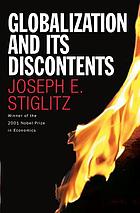 Globalization and Its Discontents
by
This powerful, unsettling book gives us a rare glimpse behind the closed doors of global financial institutions by the winner of the 2001 Nobel Prize in Economics. When it was first published, this national bestseller quickly became a touchstone in the globalization debate. Renowned economist and Nobel Prize winner Joseph E. Stiglitz had a ringside seat for most of the major economic events of the last decade, including stints as chairman of the Council of Economic Advisers and chief economist at the World Bank. Particularly concerned with the plight of the developing nations, he became increasingly disillusioned as he saw the International Monetary Fund and other major institutions put the interests of Wall Street and the financial community ahead of the poorer nations. Those seeking to understand why globalization has engendered the hostility of protesters in Seattle and Genoa will find the reasons here. While this book includes no simple formula on how to make globalization work, Stiglitz provides a reform agenda that will provoke debate for years to come. Rarely do we get such an insider's analysis of the major institutions of globalization as in this penetrating book. With a new foreword for this paperback edition. Those seeking to understand why globalization has engendered the hostility of protesters in Seattle and Genoa will find the reasons here. While this book includes no simple formula on how to make globalization work, Stiglitz provides a reform agenda that will provoke debate for years to come. Rarely do we get such an insider's analysis of the major institutions of globalization as in this penetrating book. With a new foreword for this paperback edition.
Globalization and Its Discontents
by
This powerful, unsettling book gives us a rare glimpse behind the closed doors of global financial institutions by the winner of the 2001 Nobel Prize in Economics. When it was first published, this national bestseller quickly became a touchstone in the globalization debate. Renowned economist and Nobel Prize winner Joseph E. Stiglitz had a ringside seat for most of the major economic events of the last decade, including stints as chairman of the Council of Economic Advisers and chief economist at the World Bank. Particularly concerned with the plight of the developing nations, he became increasingly disillusioned as he saw the International Monetary Fund and other major institutions put the interests of Wall Street and the financial community ahead of the poorer nations. Those seeking to understand why globalization has engendered the hostility of protesters in Seattle and Genoa will find the reasons here. While this book includes no simple formula on how to make globalization work, Stiglitz provides a reform agenda that will provoke debate for years to come. Rarely do we get such an insider's analysis of the major institutions of globalization as in this penetrating book. With a new foreword for this paperback edition. Those seeking to understand why globalization has engendered the hostility of protesters in Seattle and Genoa will find the reasons here. While this book includes no simple formula on how to make globalization work, Stiglitz provides a reform agenda that will provoke debate for years to come. Rarely do we get such an insider's analysis of the major institutions of globalization as in this penetrating book. With a new foreword for this paperback edition.
 Торговые и посольские связи России со среднеазиатскими ханствами через Оренбург : вторая половина XVIII-первая половина XIX в.
by
Торговые и посольские связи России со среднеазиатскими ханствами через Оренбург : вторая половина XVIII-первая половина XIX в.
by
 Персия, СССР и Англия; опыт сравнительного исследования внешней торговли Персии за 1913-14, 1923-24 и 1924-25 г.г. по отчетам персидских таможен.
by
Персия, СССР и Англия; опыт сравнительного исследования внешней торговли Персии за 1913-14, 1923-24 и 1924-25 г.г. по отчетам персидских таможен.
by
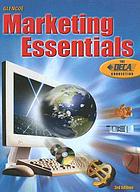 Marketing Essentials
by
Sports and Entertainment Marketing Mini-Simulations
Marketing Essentials
by
Sports and Entertainment Marketing Mini-Simulations
 Fundamentals of Human Resource Management
by
Fundamentals of Human Resource Management provides a complete introduction to human resource management for the general business manager who wants to learn more about how HRM is used in the everyday work environment. Its adaptive learning program and its engaging, focused, and applied content make it the fastest growing HRM program on the market.
Fundamentals of Human Resource Management
by
Fundamentals of Human Resource Management provides a complete introduction to human resource management for the general business manager who wants to learn more about how HRM is used in the everyday work environment. Its adaptive learning program and its engaging, focused, and applied content make it the fastest growing HRM program on the market.
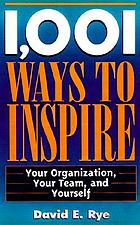 1,001 Ways to Inspire: Your Organization, Your Team and Yourself
by
Achieve higher levels of motivation throughout your organization, and in your personal life as well. 1,001 Ways to Inspire Your Organization, Your Team and Yourself presents a profound model of four personalty types. It offers a simple diagnostic test to help you figure out your own personality type and understand what motivates others. The knowledge you gain fro this book will give you the power to deal more effectively in every interpersonal situation you face.
1,001 Ways to Inspire: Your Organization, Your Team and Yourself
by
Achieve higher levels of motivation throughout your organization, and in your personal life as well. 1,001 Ways to Inspire Your Organization, Your Team and Yourself presents a profound model of four personalty types. It offers a simple diagnostic test to help you figure out your own personality type and understand what motivates others. The knowledge you gain fro this book will give you the power to deal more effectively in every interpersonal situation you face.
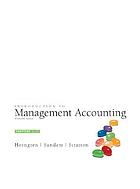 Introduction to Management Accounting, Chap. 1-17
by
Get refreshed with Horngren/Sundem/Stratton'sIntroduction to Management Accounting, 13th Edition.This best-selling book offers a relevant,real-world decision-makingapproach to management accounting. Readers develop a solid understanding of costs and cost behavior and the use of cost information for planning and control decisions, not just inventory valuation. This book emphasizes the notion that “You need to understand the business first, before you can understand the accounting of business.”Updated to cover the most recent methods in management accounting, topics include: cost behavior, cost management systems, and activity-based costing; marketing and product decisions; the master budget; flexible budget and variance analysis; management control systems; capital budgeting; cost allocation; andjob-costing and process-costing systems; basic accounting concepts, techniques, and conventions; corporate financial reports and basic financial statements; and consolidated financial statements.An excellent reference resource for managerial accountants.
Introduction to Management Accounting, Chap. 1-17
by
Get refreshed with Horngren/Sundem/Stratton'sIntroduction to Management Accounting, 13th Edition.This best-selling book offers a relevant,real-world decision-makingapproach to management accounting. Readers develop a solid understanding of costs and cost behavior and the use of cost information for planning and control decisions, not just inventory valuation. This book emphasizes the notion that “You need to understand the business first, before you can understand the accounting of business.”Updated to cover the most recent methods in management accounting, topics include: cost behavior, cost management systems, and activity-based costing; marketing and product decisions; the master budget; flexible budget and variance analysis; management control systems; capital budgeting; cost allocation; andjob-costing and process-costing systems; basic accounting concepts, techniques, and conventions; corporate financial reports and basic financial statements; and consolidated financial statements.An excellent reference resource for managerial accountants.
 Fundamental Accounting Principles
by
Fundamental Accounting Principles
by
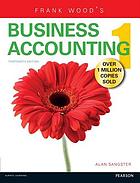 Business Accounting
by
This volume completes the financial accounting coverage of syllabuses of the various examining bodies. It has been brought up to date with all the current accounting standards in as much detail as is required at this level.
Business Accounting
by
This volume completes the financial accounting coverage of syllabuses of the various examining bodies. It has been brought up to date with all the current accounting standards in as much detail as is required at this level.
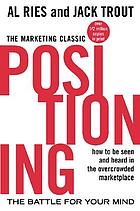 Positioning: the Battle for Your Mind
by
The first book to deal with the problems of communicating to a skeptical, media-blitzed public, Positioning describes a revolutionary approach to creating a "position" in a prospective customer's mind-one that reflects a company's own strengths and weaknesses as well as those of its competitors. Writing in their trademark witty, fast-paced style, advertising gurus Ries and Trout explain how to: Make and position an industry leader so that its name and message wheedles its way into the collective subconscious of your market-and stays there Position a follower so that it can occupy a niche not claimed by the leader Avoid letting a second product ride on the coattails of an established one. Positioning also shows you how to: Use leading ad agency techniques to capture the biggest market share and become a household name Build your strategy around your competition's weaknesses Reposition a strong competitor and create a weak spot Use your present position to its best advantage Choose the best name for your product Determine when-and why-less is more Analyze recent trends that affect your positioning. Ries and Trout provide many valuable case histories and penetrating analyses of some of the most phenomenal successes and failures in advertising history. Revised to reflect significant developments in the five years since its original publication, Positioning is required reading for anyone in business today.
Positioning: the Battle for Your Mind
by
The first book to deal with the problems of communicating to a skeptical, media-blitzed public, Positioning describes a revolutionary approach to creating a "position" in a prospective customer's mind-one that reflects a company's own strengths and weaknesses as well as those of its competitors. Writing in their trademark witty, fast-paced style, advertising gurus Ries and Trout explain how to: Make and position an industry leader so that its name and message wheedles its way into the collective subconscious of your market-and stays there Position a follower so that it can occupy a niche not claimed by the leader Avoid letting a second product ride on the coattails of an established one. Positioning also shows you how to: Use leading ad agency techniques to capture the biggest market share and become a household name Build your strategy around your competition's weaknesses Reposition a strong competitor and create a weak spot Use your present position to its best advantage Choose the best name for your product Determine when-and why-less is more Analyze recent trends that affect your positioning. Ries and Trout provide many valuable case histories and penetrating analyses of some of the most phenomenal successes and failures in advertising history. Revised to reflect significant developments in the five years since its original publication, Positioning is required reading for anyone in business today.
 The Wealthy Barber: everyoneʼs commonsense guide to becoming financially independent
by
" . . . quite simply the best financial self-help book." --Money Book Club, Book-of-the-Month Club In this new and updated edition of one of the biggest-selling financial-planning books ever, David Chilton simplifies the complex puzzles of personal finance and helps you achieve financial independence. With the help of his fictional barber, Roy, and a large dose of humor, Chilton shows you how to take control of your financial future--slowly, steadily, and with sure success. Chilton's plan (detailed in an entertaining story) is no get-rich-quick scheme, but it does make financial independence possible on nothing more than an average salary. This third edition has been updated with assistance from the Arthur Andersen Corporation, and covers the Taxpayer Relief Act of 1997 and other recent developments. Even if you consider yourself a financial "basket case," Chilton explains how you can easily put an effective financial plan into action.
The Wealthy Barber: everyoneʼs commonsense guide to becoming financially independent
by
" . . . quite simply the best financial self-help book." --Money Book Club, Book-of-the-Month Club In this new and updated edition of one of the biggest-selling financial-planning books ever, David Chilton simplifies the complex puzzles of personal finance and helps you achieve financial independence. With the help of his fictional barber, Roy, and a large dose of humor, Chilton shows you how to take control of your financial future--slowly, steadily, and with sure success. Chilton's plan (detailed in an entertaining story) is no get-rich-quick scheme, but it does make financial independence possible on nothing more than an average salary. This third edition has been updated with assistance from the Arthur Andersen Corporation, and covers the Taxpayer Relief Act of 1997 and other recent developments. Even if you consider yourself a financial "basket case," Chilton explains how you can easily put an effective financial plan into action.
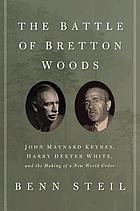 The Battle of Bretton Woods: John Maynard Keynes, Harry Dexter White, and the making of a new world order
by
A sweeping history of the drama, intrigue, and rivalry behind the creation of the postwar economic order When turmoil strikes world monetary and financial markets, leaders invariably call for 'a new Bretton Woods' to prevent catastrophic economic disorder and defuse political conflict. The name of the remote New Hampshire town where representatives of forty-four nations gathered in July 1944, in the midst of the century's second great war, has become shorthand for enlightened globalization. The actual story surrounding the historic Bretton Woods accords, however, is full of startling drama, intrigue, and rivalry, which are vividly brought to life in Benn Steil's epic account. Upending the conventional wisdom that Bretton Woods was the product of an amiable Anglo-American collaboration, Steil shows that it was in reality part of a much more ambitious geopolitical agenda hatched within President Franklin D. Roosevelt's Treasury and aimed at eliminating Britain as an economic and political rival. At the heart of the drama were the antipodal characters of John Maynard Keynes, the renowned and revolutionary British economist, and Harry Dexter White, the dogged, self-made American technocrat. Bringing to bear new and striking archival evidence, Steil offers the most compelling portrait yet of the complex and controversial figure of White--the architect of the dollar's privileged place in the Bretton Woods monetary system, who also, very privately, admired Soviet economic planning and engaged in clandestine communications with Soviet intelligence officials and agents over many years. A remarkably deft work of storytelling that reveals how the blueprint for the postwar economic order was actually drawn, The Battle of Bretton Woods is destined to become a classic of economic and political history.
The Battle of Bretton Woods: John Maynard Keynes, Harry Dexter White, and the making of a new world order
by
A sweeping history of the drama, intrigue, and rivalry behind the creation of the postwar economic order When turmoil strikes world monetary and financial markets, leaders invariably call for 'a new Bretton Woods' to prevent catastrophic economic disorder and defuse political conflict. The name of the remote New Hampshire town where representatives of forty-four nations gathered in July 1944, in the midst of the century's second great war, has become shorthand for enlightened globalization. The actual story surrounding the historic Bretton Woods accords, however, is full of startling drama, intrigue, and rivalry, which are vividly brought to life in Benn Steil's epic account. Upending the conventional wisdom that Bretton Woods was the product of an amiable Anglo-American collaboration, Steil shows that it was in reality part of a much more ambitious geopolitical agenda hatched within President Franklin D. Roosevelt's Treasury and aimed at eliminating Britain as an economic and political rival. At the heart of the drama were the antipodal characters of John Maynard Keynes, the renowned and revolutionary British economist, and Harry Dexter White, the dogged, self-made American technocrat. Bringing to bear new and striking archival evidence, Steil offers the most compelling portrait yet of the complex and controversial figure of White--the architect of the dollar's privileged place in the Bretton Woods monetary system, who also, very privately, admired Soviet economic planning and engaged in clandestine communications with Soviet intelligence officials and agents over many years. A remarkably deft work of storytelling that reveals how the blueprint for the postwar economic order was actually drawn, The Battle of Bretton Woods is destined to become a classic of economic and political history.
 God's banker : the life and death of Roberto Calvi
by
God's banker : the life and death of Roberto Calvi
by
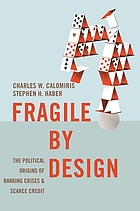 Fragile by Design : the political origins of banking crises and scarce credit
by
Why stable banking systems are so rare Why are banking systems unstable in so many countries--but not in others? The United States has had twelve systemic banking crises since 1840, while Canada has had none. The banking systems of Mexico and Brazil have not only been crisis prone but have provided miniscule amounts of credit to business enterprises and households. Analyzing the political and banking history of the United Kingdom, the United States, Canada, Mexico, and Brazil through several centuries, Fragile by Design demonstrates that chronic banking crises and scarce credit are not accidents. Calomiris and Haber combine political history and economics to examine how coalitions of politicians, bankers, and other interest groups form, why they endure, and how they generate policies that determine who gets to be a banker, who has access to credit, and who pays for bank bailouts and rescues. Fragile by Design is a revealing exploration of the ways that politics inevitably intrudes into bank regulation.
Fragile by Design : the political origins of banking crises and scarce credit
by
Why stable banking systems are so rare Why are banking systems unstable in so many countries--but not in others? The United States has had twelve systemic banking crises since 1840, while Canada has had none. The banking systems of Mexico and Brazil have not only been crisis prone but have provided miniscule amounts of credit to business enterprises and households. Analyzing the political and banking history of the United Kingdom, the United States, Canada, Mexico, and Brazil through several centuries, Fragile by Design demonstrates that chronic banking crises and scarce credit are not accidents. Calomiris and Haber combine political history and economics to examine how coalitions of politicians, bankers, and other interest groups form, why they endure, and how they generate policies that determine who gets to be a banker, who has access to credit, and who pays for bank bailouts and rescues. Fragile by Design is a revealing exploration of the ways that politics inevitably intrudes into bank regulation.
 International Financial Management
by
Coupling in-depth coverage of essential theory with practical applications, Madura's INTERNATIONAL FINANCIAL MANAGEMENT, 13e, builds on the fundamental principles of corporate finance to provide the timely information and contemporary insights you need to prosper in today's global business environment. This best-seller introduces international finance with a focus on the important role that modern multinational corporations play in global commerce and discusses a wide range of managerial topics using a strong corporate perspective. Clear explanations, real-world applications, relevant examples, self-tests, and hands-on applications help you maximize your course success. In addition, MindTap Finance enables you to connect with your instructor, organize coursework, and access a range of study tools, including an e-book and apps -- all in one place.
International Financial Management
by
Coupling in-depth coverage of essential theory with practical applications, Madura's INTERNATIONAL FINANCIAL MANAGEMENT, 13e, builds on the fundamental principles of corporate finance to provide the timely information and contemporary insights you need to prosper in today's global business environment. This best-seller introduces international finance with a focus on the important role that modern multinational corporations play in global commerce and discusses a wide range of managerial topics using a strong corporate perspective. Clear explanations, real-world applications, relevant examples, self-tests, and hands-on applications help you maximize your course success. In addition, MindTap Finance enables you to connect with your instructor, organize coursework, and access a range of study tools, including an e-book and apps -- all in one place.
 Corporate Finance
by
Using the unifying valuation framework based on the Law of One Price, top researchers Jonathan Berk and Peter DeMarzo have set the new canon for corporate finance textbooks. Corporate Finance blends coverage of time-tested principles and the latest advancements with the practical perspective of the financial manager, so students have the knowledge and tools they need to make sound financial decisions in their careers. For a streamlined book specifically tailored to the topics covered in the first one-semester course, Corporate Finance: The Core is also available by Jonathan Berk and Peter DeMarzo. KEY TOPICS: The Corporation; Introduction to Financial Statement Analysis; Financial Decision Making and the Law of One Price; The Time Value of Money; Interest Rates; Valuing Bonds; Investment Decision Rules; Fundamentals of Capital Budgeting; Valuing Stocks; Capital Markets and the Pricing of Risk; Optimal Portfolio Choice and the Capital Asset Pricing Model; Estimating the Cost of Capital; Investor Behavior and Capital Market Efficiency; Capital Structure in a Perfect Market; Debt and Taxes; Financial Distress, Managerial Incentives, and Information; Payout Policy; Capital Budgeting and Valuation with Leverage; Valuation and Financial Modeling: A Case Study; Financial Options; Option Valuation; Real Options; Raising Equity Capital; Debt Financing; Leasing; Working Capital Management; Short-Term Financial Planning; Mergers and Acquisitions; Corporate Governance; Risk Management; International Corporate Finance MARKET: Directed primarily toward MBA/graduate students, this text also provides practical content to current and aspiring finance professionals.
Corporate Finance
by
Using the unifying valuation framework based on the Law of One Price, top researchers Jonathan Berk and Peter DeMarzo have set the new canon for corporate finance textbooks. Corporate Finance blends coverage of time-tested principles and the latest advancements with the practical perspective of the financial manager, so students have the knowledge and tools they need to make sound financial decisions in their careers. For a streamlined book specifically tailored to the topics covered in the first one-semester course, Corporate Finance: The Core is also available by Jonathan Berk and Peter DeMarzo. KEY TOPICS: The Corporation; Introduction to Financial Statement Analysis; Financial Decision Making and the Law of One Price; The Time Value of Money; Interest Rates; Valuing Bonds; Investment Decision Rules; Fundamentals of Capital Budgeting; Valuing Stocks; Capital Markets and the Pricing of Risk; Optimal Portfolio Choice and the Capital Asset Pricing Model; Estimating the Cost of Capital; Investor Behavior and Capital Market Efficiency; Capital Structure in a Perfect Market; Debt and Taxes; Financial Distress, Managerial Incentives, and Information; Payout Policy; Capital Budgeting and Valuation with Leverage; Valuation and Financial Modeling: A Case Study; Financial Options; Option Valuation; Real Options; Raising Equity Capital; Debt Financing; Leasing; Working Capital Management; Short-Term Financial Planning; Mergers and Acquisitions; Corporate Governance; Risk Management; International Corporate Finance MARKET: Directed primarily toward MBA/graduate students, this text also provides practical content to current and aspiring finance professionals.
 Fundamentals of Multinational Finance
by
For undergraduate courses in International Financial Management, International Business Finance, or International Finance. Real-world examples introduce readers to global financial management strategy Fundamentals of Multinational Finance helps prepare tomorrow's business leaders to comprehend global markets and lead organizations through a constantly changing global environment. Via illuminating case studies and real¿-world examples, readers are introduced to the fundamental concepts and tools necessary to implement an effective global financial management strategy. The 6th Edition reflects the juxtaposed forces of an increasingly digital global marketplace and a resurgence of nationalist culture and identity. Financial forces, markets, and management are in many ways at the crux of this challenge. This edition reflects a business world trying to find a new balance between business startups like the micro-multinational, a maturing China, a separatist Britain (Brexit), and an attempt by governments globally to channel, regulate (and tax) multinational firms that continue to grow in stature and strength. Also available with MyLab Finance MyLab(tm) Finance is an online homework, tutorial, and assessment program designed to work with this text to engage students and improve results. Within its structured environment, students practice what they learn, test their understanding, and pursue a personalized study plan that helps them better absorb course material and understand difficult concepts. NOTE: You are purchasing a standalone product; MyLab Finance does not come packaged with this content. If you would like to purchase both the physical text and MyLab Finance, search for: 0134618580 / 9780134618586 Fundamentals of Multinational Finance Plus MyLab Finance with Pearson eText -- Access Card Package Package consists of: 0134472136 / 9780134472133 Fundamentals of Multinational Finance 0134626575 / 9780134626574 MyLab Finance with Pearson eText -- Access Card -- for Fundamentals of Multinational Finance
Fundamentals of Multinational Finance
by
For undergraduate courses in International Financial Management, International Business Finance, or International Finance. Real-world examples introduce readers to global financial management strategy Fundamentals of Multinational Finance helps prepare tomorrow's business leaders to comprehend global markets and lead organizations through a constantly changing global environment. Via illuminating case studies and real¿-world examples, readers are introduced to the fundamental concepts and tools necessary to implement an effective global financial management strategy. The 6th Edition reflects the juxtaposed forces of an increasingly digital global marketplace and a resurgence of nationalist culture and identity. Financial forces, markets, and management are in many ways at the crux of this challenge. This edition reflects a business world trying to find a new balance between business startups like the micro-multinational, a maturing China, a separatist Britain (Brexit), and an attempt by governments globally to channel, regulate (and tax) multinational firms that continue to grow in stature and strength. Also available with MyLab Finance MyLab(tm) Finance is an online homework, tutorial, and assessment program designed to work with this text to engage students and improve results. Within its structured environment, students practice what they learn, test their understanding, and pursue a personalized study plan that helps them better absorb course material and understand difficult concepts. NOTE: You are purchasing a standalone product; MyLab Finance does not come packaged with this content. If you would like to purchase both the physical text and MyLab Finance, search for: 0134618580 / 9780134618586 Fundamentals of Multinational Finance Plus MyLab Finance with Pearson eText -- Access Card Package Package consists of: 0134472136 / 9780134472133 Fundamentals of Multinational Finance 0134626575 / 9780134626574 MyLab Finance with Pearson eText -- Access Card -- for Fundamentals of Multinational Finance
 The Intelligent Investor: a book of practical counsel
by
"By far the best book on investing ever written." -- Warren Buffett The greatest investment advisor of the twentieth century, Benjamin Graham taught and inspired people worldwide. Graham's philosophy of "value investing"--which shields investors from substantial error and teaches them to develop long-term strategies--has made The Intelligent Investor the stock market bible ever since its original publication in 1949. Over the years, market developments have proven the wisdom of Graham's strategies. While preserving the integrity of Graham's original text, this revised edition includes updated commentary by noted financial journalist Jason Zweig, whose perspective incorporates the realities of today's market, draws parallels between Graham's examples and today's financial headlines, and gives readers a more thorough understanding of how to apply Graham's principles. Vital and indispensable, The Intelligent Investor is the most important book you will ever read on how to reach your financial goals.
The Intelligent Investor: a book of practical counsel
by
"By far the best book on investing ever written." -- Warren Buffett The greatest investment advisor of the twentieth century, Benjamin Graham taught and inspired people worldwide. Graham's philosophy of "value investing"--which shields investors from substantial error and teaches them to develop long-term strategies--has made The Intelligent Investor the stock market bible ever since its original publication in 1949. Over the years, market developments have proven the wisdom of Graham's strategies. While preserving the integrity of Graham's original text, this revised edition includes updated commentary by noted financial journalist Jason Zweig, whose perspective incorporates the realities of today's market, draws parallels between Graham's examples and today's financial headlines, and gives readers a more thorough understanding of how to apply Graham's principles. Vital and indispensable, The Intelligent Investor is the most important book you will ever read on how to reach your financial goals.
 Государственный бюджет СССР, 1981-1985 гг. : статистический сборник
by
Государственный бюджет СССР, 1981-1985 гг. : статистический сборник
by
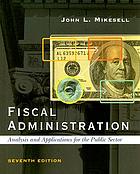 Fiscal Administration : analysis and applications in the public sector
by
Ever wonder how federal finance really works? FISCAL ADMINISTRATION shows you how public budgets operate and lets you crunch the numbers yourself. And with the latest data from the US federal budget, including its breakdown, you can see for yourself how policymakers allocate money. Plus, each chapter includes stories for discussion from the private sector as well as from public finance. Run the numbers and debate the financial policies with FISCAL ADMINISTRATION.
Fiscal Administration : analysis and applications in the public sector
by
Ever wonder how federal finance really works? FISCAL ADMINISTRATION shows you how public budgets operate and lets you crunch the numbers yourself. And with the latest data from the US federal budget, including its breakdown, you can see for yourself how policymakers allocate money. Plus, each chapter includes stories for discussion from the private sector as well as from public finance. Run the numbers and debate the financial policies with FISCAL ADMINISTRATION.